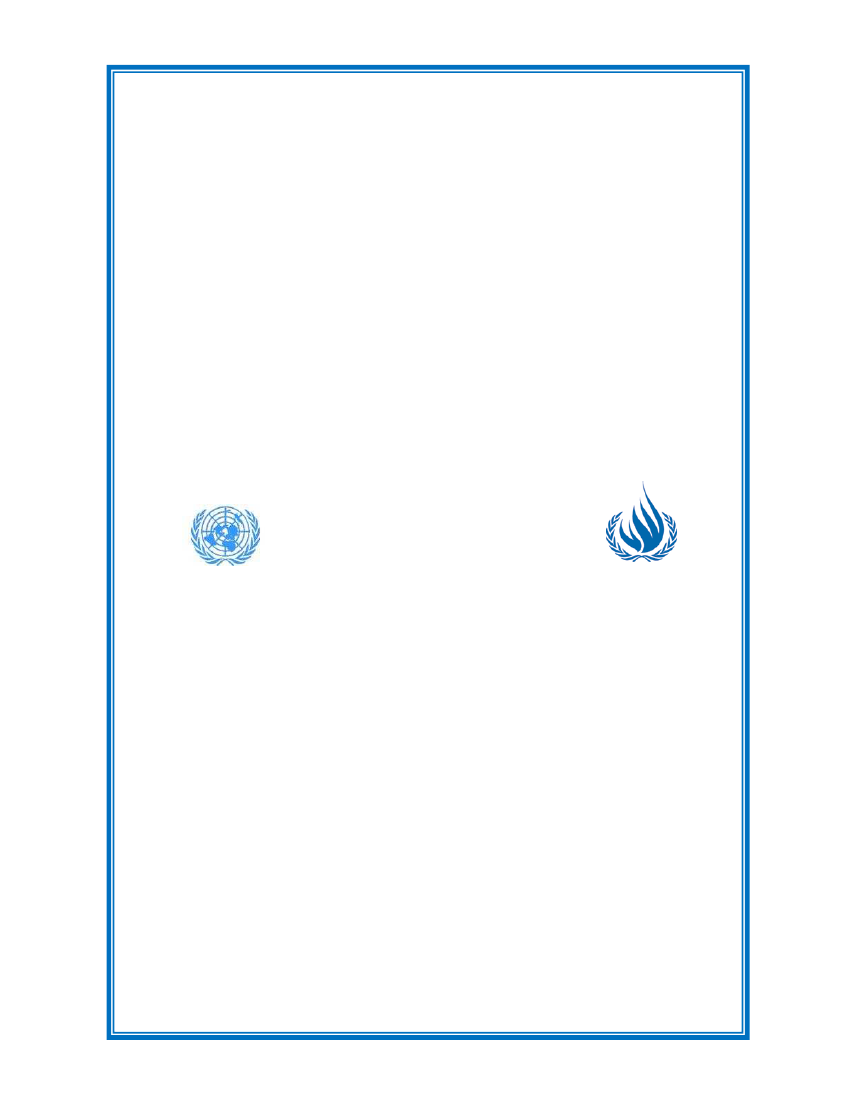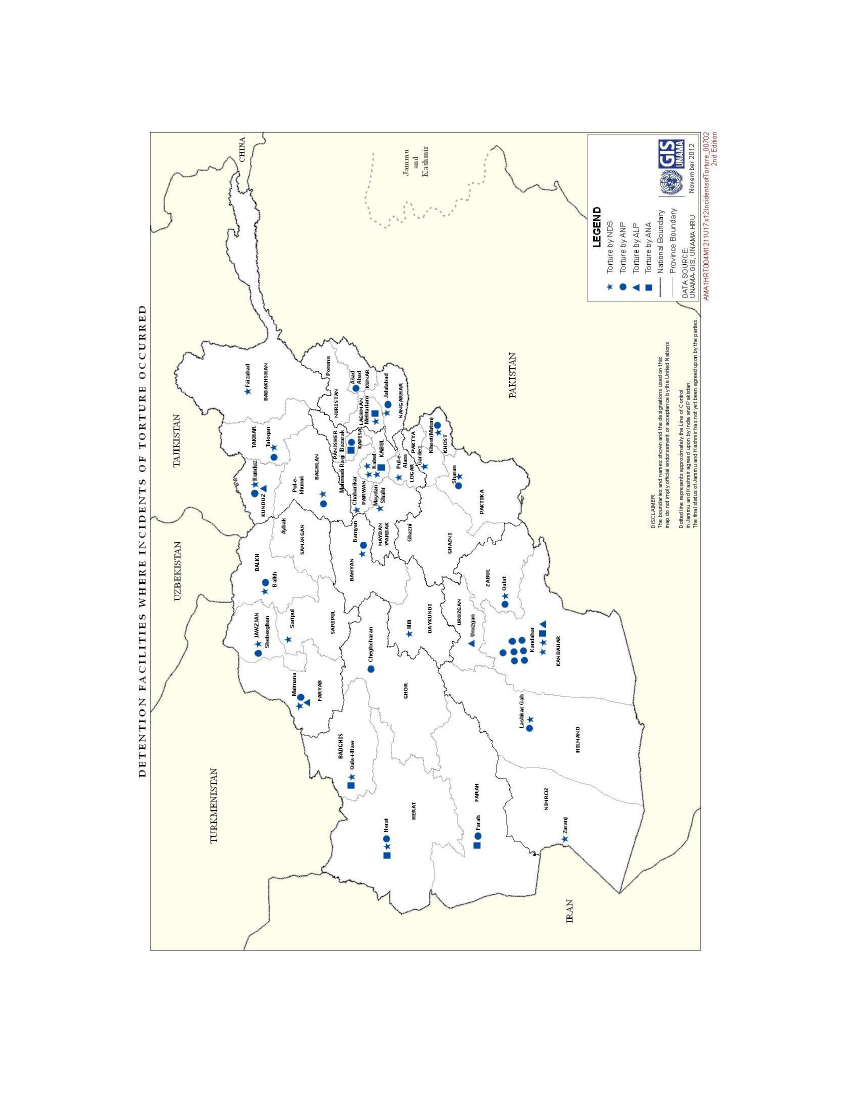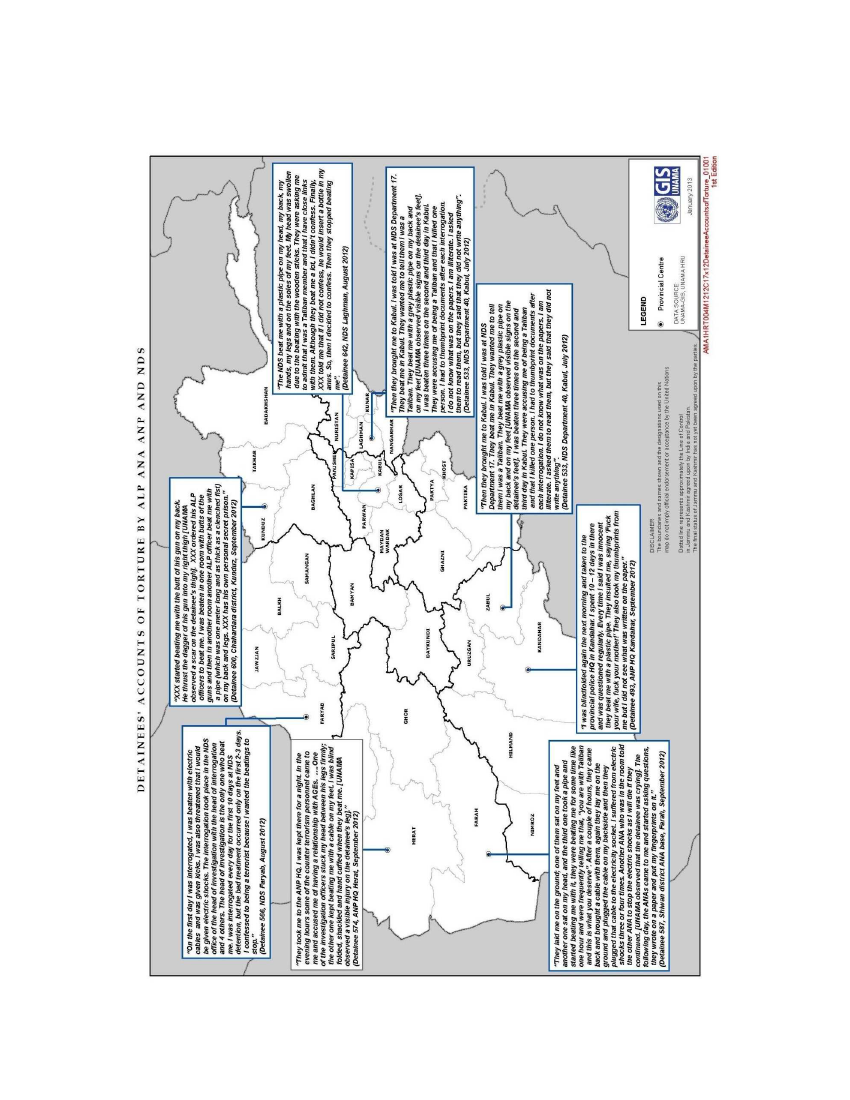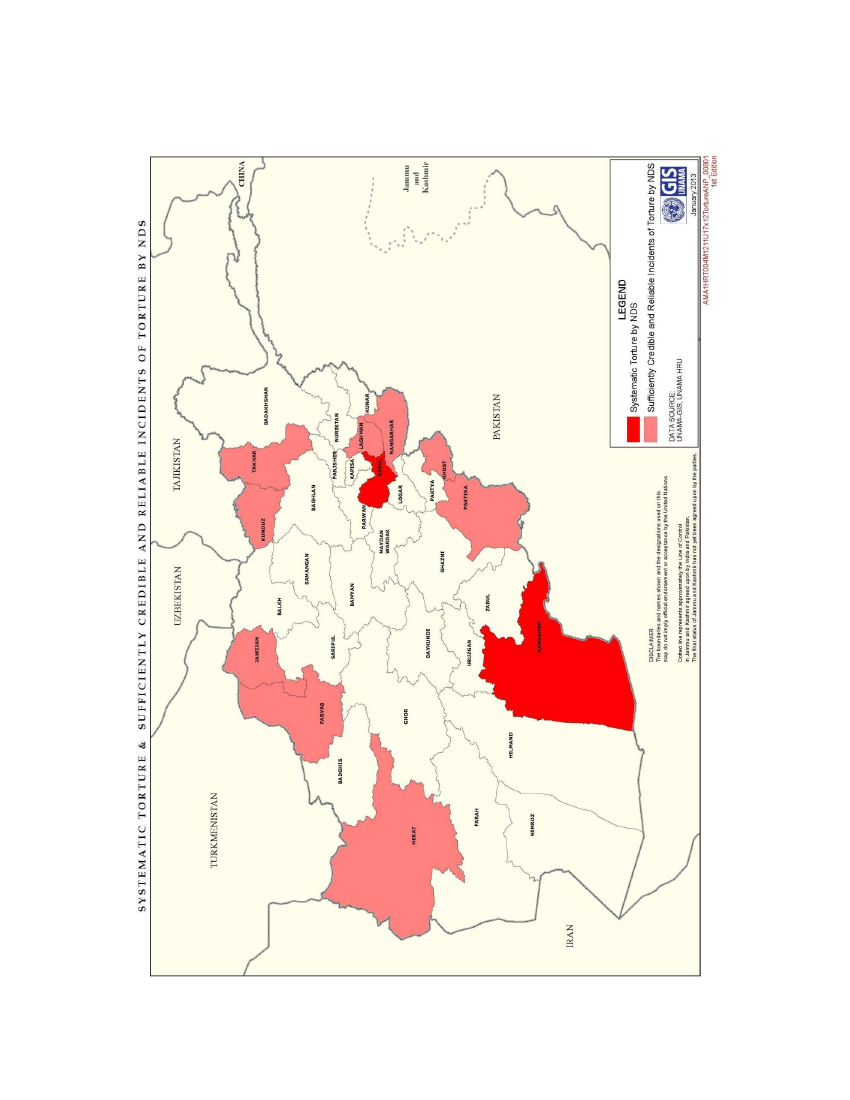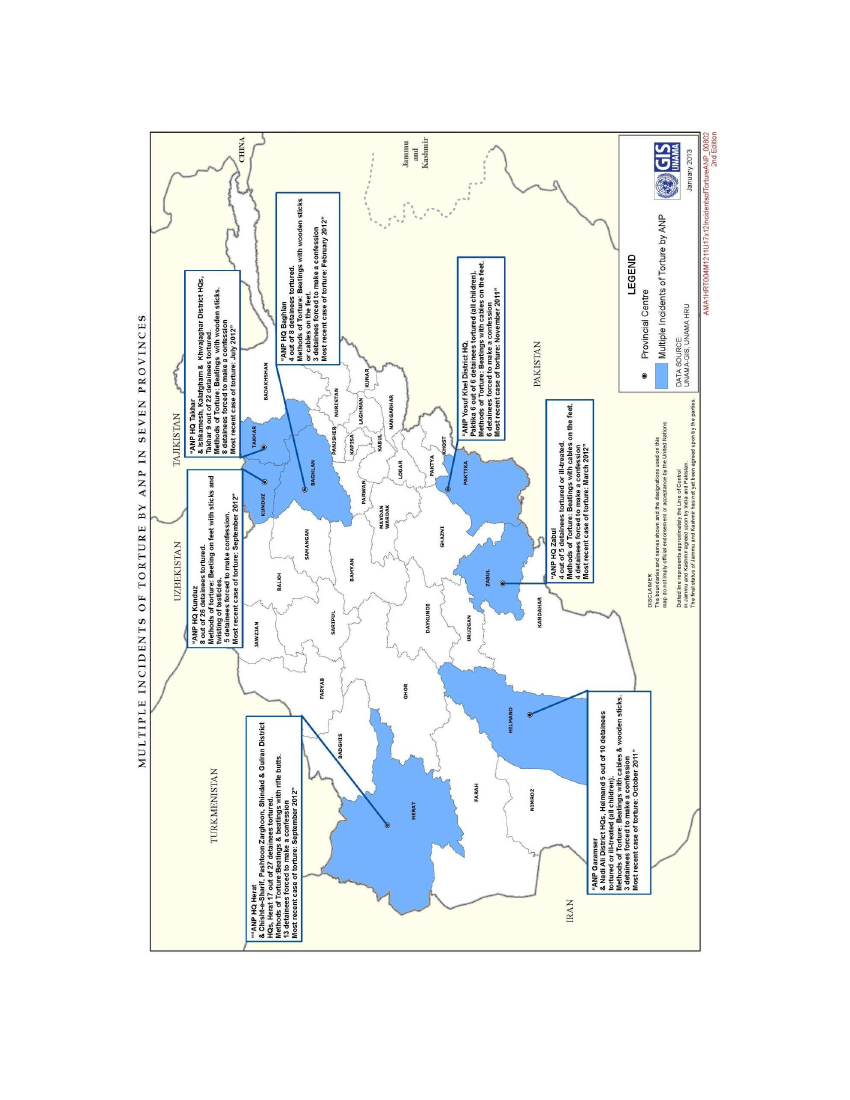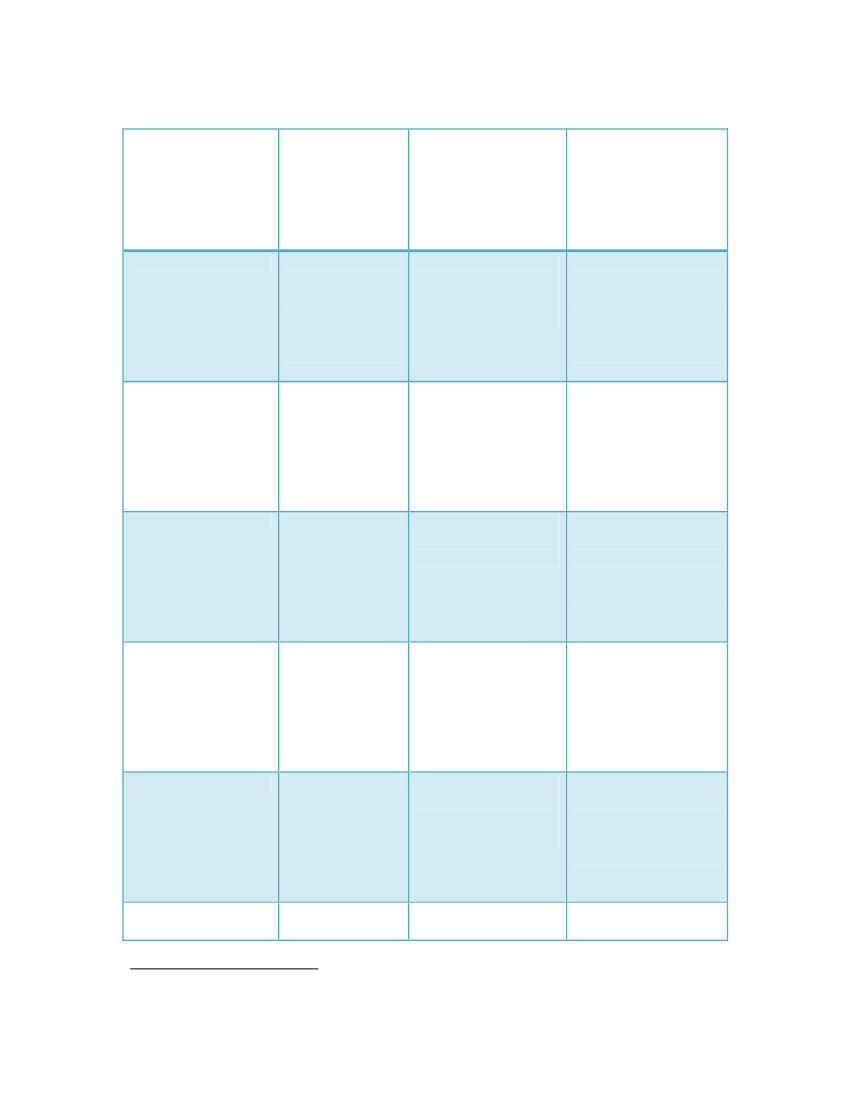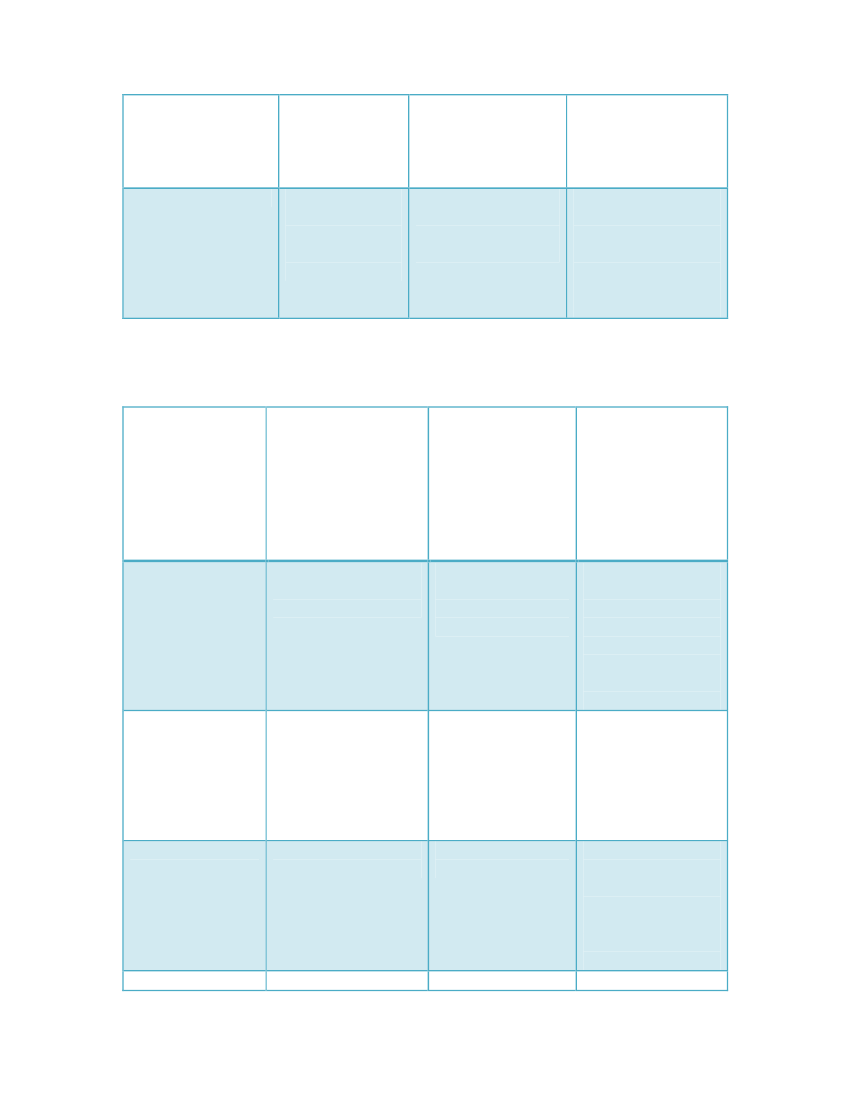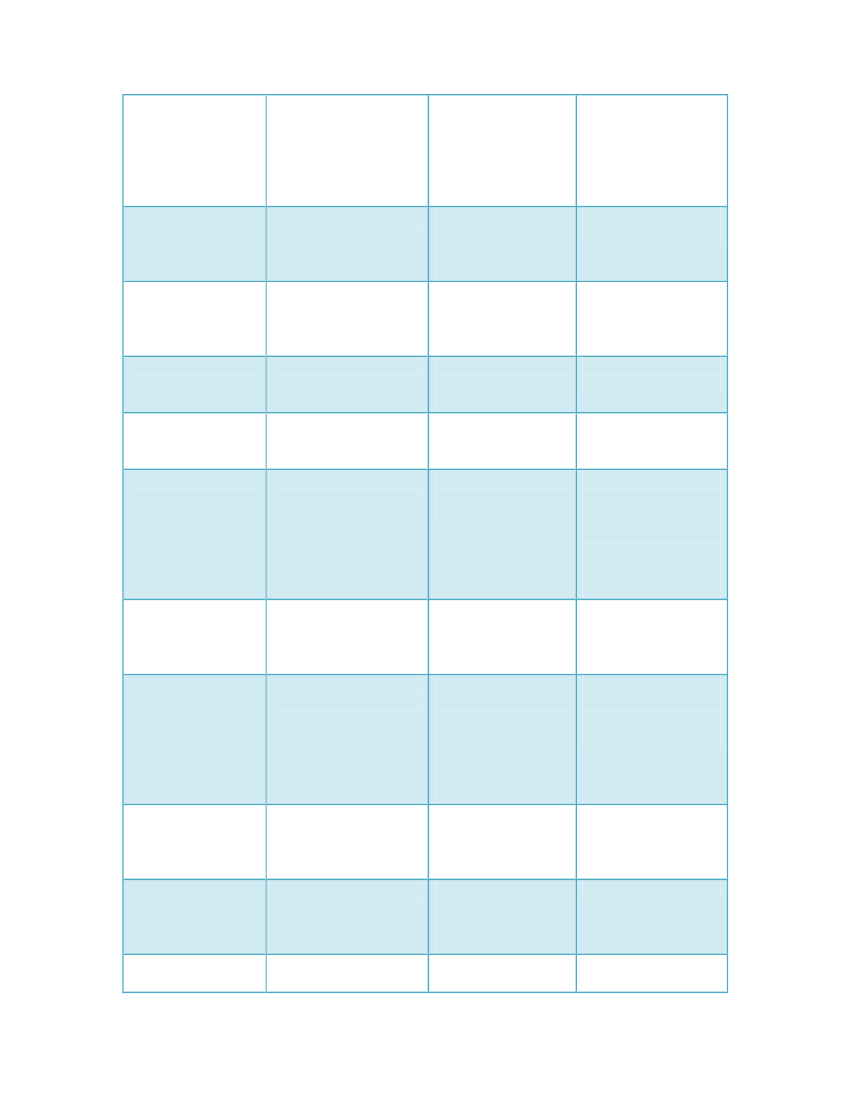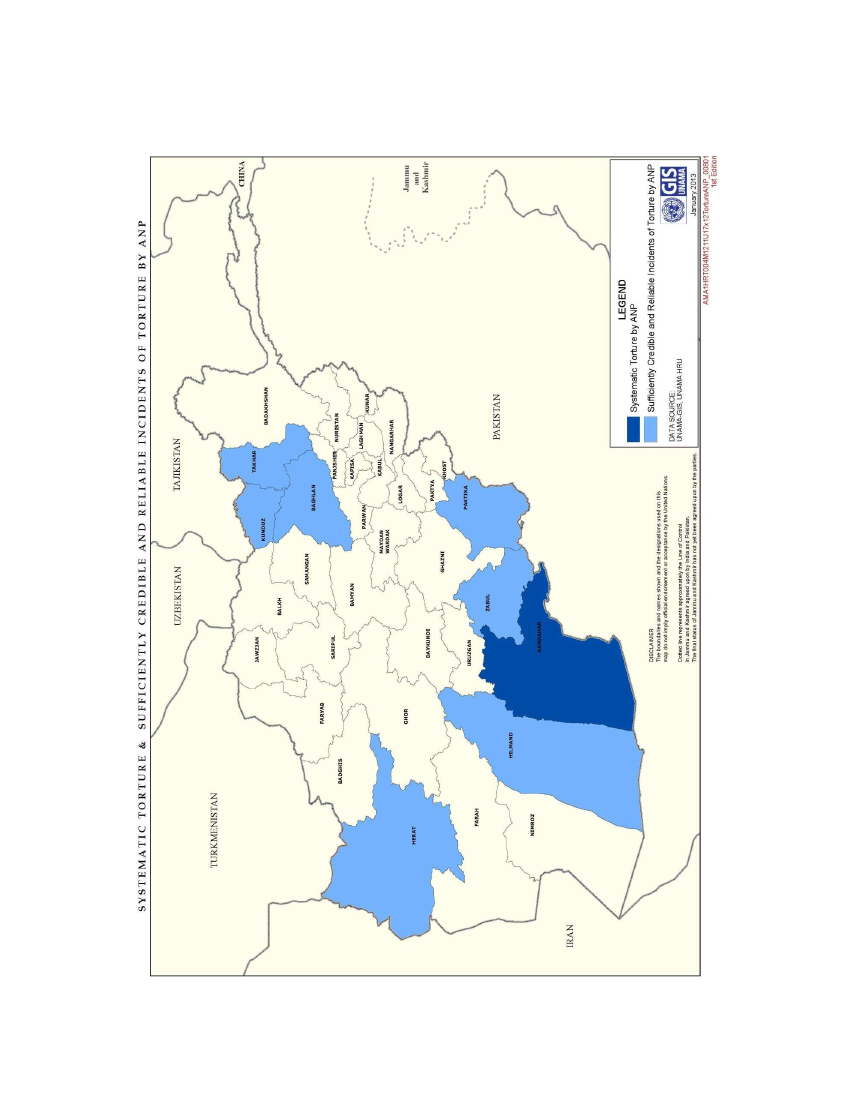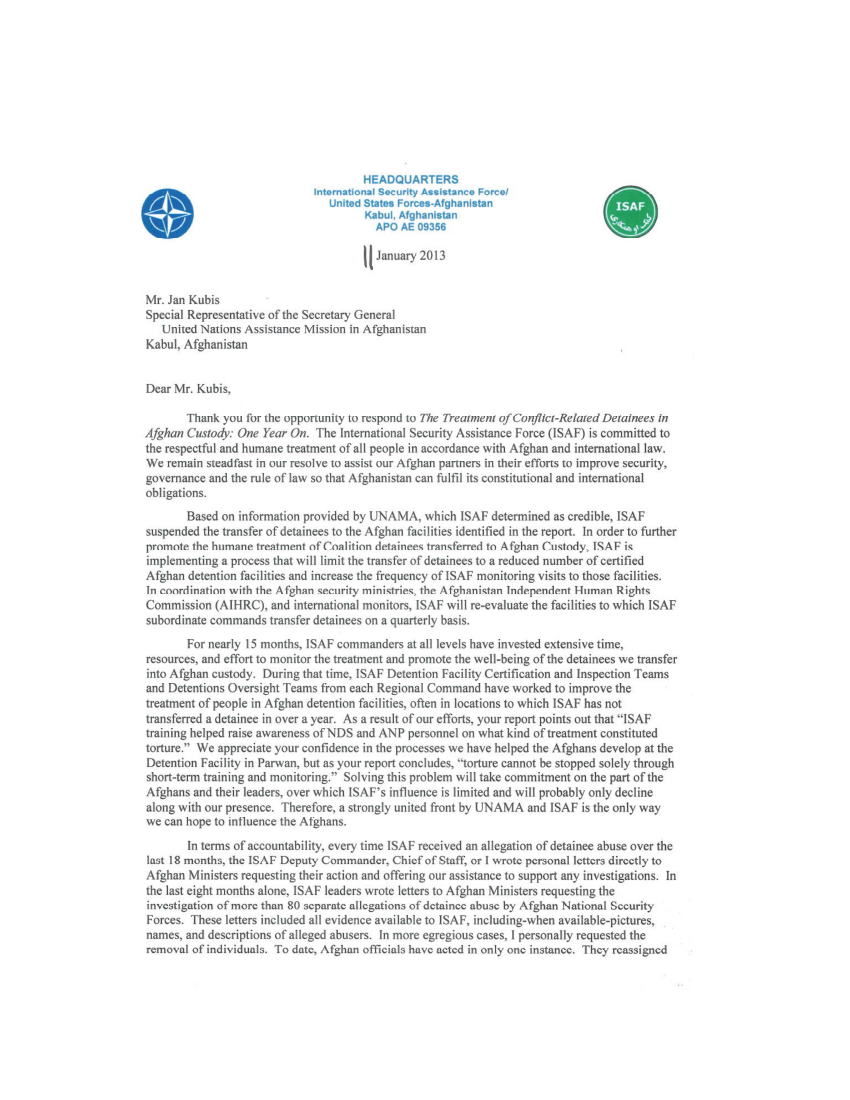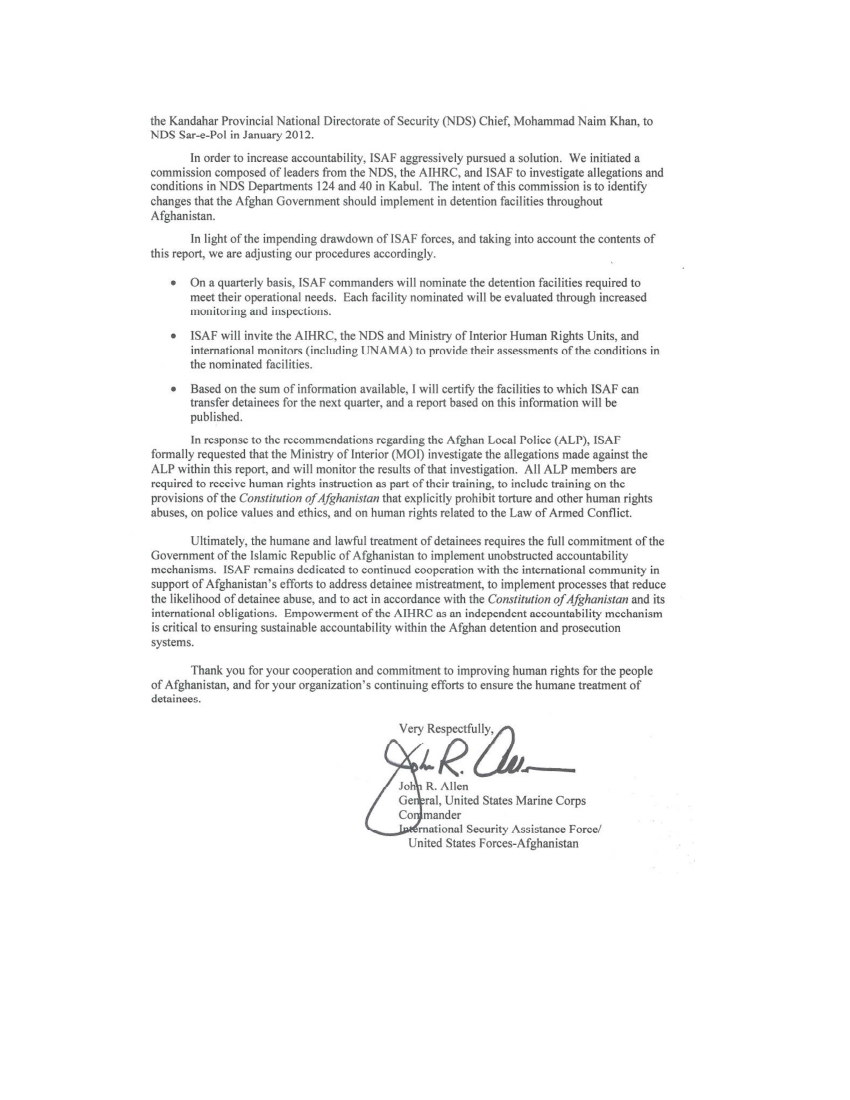Forsvarsudvalget 2012-13
FOU Alm.del Bilag 79
Offentligt
Treatment of Conflict-RelatedDetainees in Afghan Custody
One Year On
United Nations Assistance Mission in AfghanistanUnited Nations Office of the High Commissioner for Human RightsJanuary 2013Kabul, Afghanistan
ContentsGlossary ........................................................................................................................................................... iUNAMA’s Mandate ......................................................................................................................................iiAccess and Methodology ..........................................................................................................................iiExecutive Summary.................................................................................................................................... 1Map 1: Detention Facilities Visited by UNAMA.............................................................................. 26Map 2: Detention Facilities where Incidents Occurred.............................................................. 27Map 3: Detainee Accounts of Treatment in ALP, ANA, ANP and NDS Locations ................ 28Treatment of Detainees by the National Directorate of Security ........................................... 29Map 4: Multiple Incidents in NDS Custody in Ten Provinces ................................................... 42Map 5: Systematic and Sufficiently Credible and Reliable Incidents in NDS Custody ..... 45Treatment of Detainees by the Afghan National Police and Afghan National BorderPolice ............................................................................................................................................................ 46Map 6: Multiple Incidents in ANP Custody in Seven Provinces ............................................... 55Map 7: Systematic and Sufficiently Credible and Reliable Incidents in ANP Custody..... 60Treatment of Detainees by the Afghan National Army .............................................................. 61Treatment of Detainees by Afghan Local Police ........................................................................... 61Treatment of Detainees Transferred to NDS and ANP by International Military Forces63Measures Taken by the Government of Afghanistan to Address Torture and Ill-Treatment................................................................................................................................................... 65Due Process and the Criminal Justice System’s Response ........................................................ 72ISAF’s Detainee Facility Inspection Programme .......................................................................... 76International Support to the NDS and the Ministry of Interior ............................................... 81Way Forward: Proposal for Future Detention Monitoring ....................................................... 83Recommendations................................................................................................................................... 85ANNEX I: UNAMA’s Detention Observation Programme 2010-12 .......................................... 91ANNEX II: Status of Implementation of UNAMA’s Recommendations from October 2011Report .......................................................................................................................................................... 93ANNEX III: Applicable Law .................................................................................................................... 97ANNEX IV: Response of the Government of Afghanistan, National Directorate of Securityand Ministry of Interior to this Report dated 14 January 2013 ............................................103ANNEX V: Letter of Commander ISAF to UNAMA dated 11 January 2013..........................125
GlossaryAcronymsAIHRCALPANAANBPANPANSFCIDCoPCPDCRCHQICPCICRCISAFJRCMoIMoJMoUNDSNPMsOHCHRUNAMAUNDPAfghanistan Independent Human Rights CommissionAfghan Local PoliceAfghanistan National ArmyAfghanistan National Border PoliceAfghanistan National PoliceAfghanistan National Security ForcesCriminal Investigations DepartmentChief of PoliceCentral Prisons DirectorateConvention on the Rights of the ChildHeadquartersInterim Criminal Procedure CodeInternational Committee of the Red CrossInternational Security Assistance ForceJuvenile Rehabilitation CentreMinistry of InteriorMinistry of JusticeMemorandum of UnderstandingNational Directorate of SecurityNational Preventive MechanismsOffice of the High Commissioner for Human RightsUnited Nations Assistance Mission in AfghanistanUnited Nations Development Programme
Arabic, Dari and Pashto wordsHawzaShuraTalibanTaqninCadastral zone within a cityConsultation or council of community eldersArmed opposition group fighting against the Government ofAfghanistan and International Military ForcesMoJ Department of Legislative Drafting
i
UNAMA’s MandateSince 2004, the United Nations Security Council has mandated the United NationsAssistance Mission in Afghanistan (UNAMA) to support the establishment of a fair andtransparent justice system, including the reconstruction and reform of the prison sector,and to work towards strengthening the rule of law. UNAMA includes a Human RightsUnit with field staff across the country, supported technically by the UN Office of theHigh Commissioner for Human Rights (OHCHR).UN Security Council Resolution 2041 (2012)1mandates UNAMA to improve respect forhuman rights in the justice and prisons sectors as follows:37.Reiteratesthe importance of the full, sequenced, timely and coordinatedimplementation of the National Priority Programme on Law and Justice for All, by all therelevant Afghan institutions and other actors in view of accelerating the establishmentof a fair and transparent justice system, eliminating impunity and contributing to theaffirmation of the rule of law throughout the country;38.Stressesin this context the importance of further progress in the reconstruction andreform of the prison sector in Afghanistan, in order to improve the respect for the ruleof law and human rights therein,emphasizesthe importance of ensuring access forrelevant organizations, as applicable, to all prisons and places of detention inAfghanistan,andcalls forfull respect for relevant international law includinghumanitarian law and human rights law, noting the recommendations containedin the report of the Assistance Mission dated 10 October 2011.
OHCHR in AfghanistanThe UN Human Rights Council in decision 2/113 of 27 November 2006 mandatesOHCHR to address the human rights situation in Afghanistan, and urges its continuedcooperation as follows:The Council requests the High Commissioner to continue, in cooperation with theUnited Nations Assistance Mission in Afghanistan, to monitor the human rights situationin Afghanistan, provide and expand advisory services and technical cooperation in thefield of human rights and the rule of law, and report regularly to the Council on thesituation of human rights in Afghanistan.2
Access and MethodologyFrom October 2010 to August 2011, in response to repeated concerns and reports abouttorture and ill-treatment of conflict-related detainees from communities acrossAfghanistan and in consultation with the Government of Afghanistan, UNAMAconducted an intensive programme of observation of conflict-related detaineesthroughout Afghanistan. UNAMA produced a public report on its findings with 25recommendations to relevant authorities entitledTreatment of Conflict-Related
UN Security Council Resolution 2041, S/RES/2041 (2012) was adopted on 22 March 2012.Report of the Human Rights Council to the 62ndSession of the General Assembly,Supplement No. 53,A/62/53, Decision 2/113, 28 November 2006.12
ii
Detainees in Afghan Custodyreleased in October 2011.3See Annex 1 of this report for asummary of the findings and Annex II for information on the status of implementationof recommendations from UNAMA’s October 2011 report.Current ReportThis report presents findings from UNAMA’s observation of conflict-related detentionfor the period October 2011 to October 2012. Government officials from the ANP,Afghan National Border Police, NDS, Ministry of Interior (MoI) and other departmentscooperated with UNAMA during the period of detention observation.From October 2011 to October 2012, NDS provided access to detainees at NDS facilitiesthroughout Afghanistan, except the national detention facility of NDS Counter-Terrorism Department 124 (formerly known as Department 90) in Kabul to whichUNAMA has not been permitted access.The Ministry of Interior provided access to all ANP and ANBP lock-ups and detentionfacilities. The transfer of responsibility for prisons through the Central PrisonsDirectorate (CPD) from the Ministry of Justice to the Ministry of Interior on 10 January2012 caused some obstacles for UNAMA in accessing several CPD prisons and ininterviewing detainees.4Sample of DetaineesBetween October 2011-2012, UNAMA interviewed 635 pre-trial detainees andconvicted prisoners detained by the ANP, ANBP, Afghan National Army (ANA), AfghanLocal Police (ALP) and/or by NDS. Detainees were interviewed at ANP or ANBP lock-ups or ANP provincial centers or at NDS provincial headquarters, a Central PrisonsDirectorate (CPD) prison or a juvenile rehabilitation centre (JRC). UNAMA’s interviewscovered treatment of detainees interviewed in 89 facilities in 30 provinces acrossAfghanistan (detainees held in Wardak and Nimroz were interviewed following transferto Kabul and Farah respectively).5Map 1 provides an overview of detention facilitiesvisited by UNAMA between October 2011 and October 2012.
of Conflict-Related Detainees in Afghan Custody(UNAMA/OHCHR, October 2011) available athttp://unama.unmissions.org/Portals/UNAMA/Documents/October10_%202011_UNAMA_Detention_Full-Report_ENG.pdf.4Directors of some provincial CPD prisons informed UNAMA they had received instructions from theMinistry of Interior to seek authorization from the provincial chief of police prior to permitting any visits.This occurred in Kandahar when UNAMA sought to visitSarpoza Prisonin December 2011 and January2012 when authority for CPD facilities was initially transferred from the Ministry of Justice to theMinistry of Interior (MoI). UNAMA resolved the issue by referring the matter to the Head of CPD in Kabul,General Jamshed who intervened and authorized UNAMA’s access. It remains unclear, however, whetherthe MoI or the CPD has overall authority to grant access to independent monitoring bodies/organizationsto prisons. CPD directors have indicated that the chief prosecutor, the Head of NDS and the Chief of Policeare the authorities that UNAMA should contact to authorize monitoring visits. UNAMA is concerned thatthis lack of clarity may jeopardize efforts to continue to observe and report on detainee treatment andcompliance with due process obligations by Afghan authorities.5NDS provincial facilities UNAMA visited: Faizabad (Badakhshan), Qala-e-Naw (Badghis), Pul-e-Khumri(Baghlan), Mazar (Balkh), Bamyan city (Bamyan),Nili (Daikundi), Farah city (Farah), Maimana (Faryab),Herat city (Herat), Sherbergan (Jawzjan), Kabul (Departments 1 and 40), Kandahar city (Kandahar),Mahmud-e-Raqi (Kapisa), Khost city (Khost), Asad Abad (Kunar), Kunduz city (Kunduz), Mehtarlam(Laghman), Jalalabad (Nangarhar), Sharan (Paktika), Gardez city (Paktya), Chaharikar (Parwan), Sari Pulcity (Sari Pul), Taloqan (Takhar), and Qalat (Zabul). ANP provincial facilities UNAMA visited: Faizabad(Badakhshan, Pul-e-Khumri (Baghlan), Mazar (Balkh), Bamyan city (Bamyan), Nili (Daikundi), Farah city
3Treatment
iii
At almost all of these detention facilities, UNAMA met with detaining authorities andother relevant Government officials, visited parts of each detention facility andexamined its registry. At some NDS facilities, UNAMA was denied access to the registryor logbook and/or access to all parts of the detention facility. When this occurred, thematter was first referred to the senior management of the facility concerned and then tothe NDS human rights department at NDS headquarters in Kabul. After intervention bythe NDS human rights department, UNAMA was granted access to logbooks in all NDSfacilities visited.Of 635 detainees UNAMA interviewed, 552 were held on suspicion of or were convictedof offences related to the armed conflict. UNAMA found that ANP counter terrorismunits and/or NDS had detained another 78 detainees who were categorized as suspectsfor “common crimes.” Many had been arrested for kidnapping or abduction, classified asa common crime which NDS is responsible for investigating; many of these detaineeswere also suspected members of Anti-Government Elements (AGEs) or relatives ofsuspected AGEs. UNAMA included these detainees in the sample because NDS and ANPtreated them as conflict-related detainees and held them with other conflict-related orpolitical detainees.UNAMA found that 330 out of 552 conflict-related detainees were alleged to be Talibansupporters and 57 were alleged to be members of other Anti-Government armedgroups. Among the 552, 87 were alleged to have been in possession of explosives andother lethal devices, 18 were alleged to have committed murder or assault, 13 werealleged to have participated in failed suicide attacks, seven were alleged to havecommitted abduction, two were accused of forgery, two detainees were detained forbeing the relative of an accused suspect, one was accused of human trafficking and 16were alleged to have committed other crimes. A further 19 detainees did not know thespecific crime for which they were detained.Of the 635 detainees, 514 were held or had been held in NDS detention facilities6, 286were held or had been held in ANP facilities, nine were held or had been held by ANBP7,34 had been held in ANA detention facilities8, 12 detainees were held or had been held(Farah), Maimana (Faryab), Herat city (Herat), Sherbergan (Jawzjan), Kabul city (Kabul), Mahmud-e-Raqi(Kapisa), Kandahar city (Kandahar), Khost city (Khost), Asad Abad (Kunar), Kunduz city (Kunduz city),Mehtarlam (Laghman), Jalalabad (Nangarhar), Sharan (Paktika), Gardez (Paktya), Chaharikar (Parwan),Taloqan (Takhar) and Qalat (Zabul). CPD provincial prisons that UNAMA visited: Faizabad (Badakhshan),Qala-e-Naw (Badghis), Pul-e-Khumri (Baghlan), Mazar (Balkh), Bamyan city (Bamyan), Nili (Daikundi),Farah city (Farah), Maimana (Faryab), Chaghcharan (Ghor), Herat city (Herat), Sherbergan (Jawzjan),Pul icharkhi(Kabul),Sarpoza(Kandahar), Mahmud-e-Raqi (Kapisa), Khost city (Khost), Asad Abad (Kunar),Kunduz (Kunduz), Mehtarlam (Laghman), Jalalabad (Nangarhar), Chaharikar (Parwan), Sari Pul city (SariPul), Taloqan (Takhar) and Qalat (Zabul). JRCs that UNAMA visited: Faizabad (Badakhshan), Qala-e-Naw(Badghis), Pul-e-Khumri (Baghlan), Farah city (Farah), Lashkar Gah (Helmand) Herat city (Herat), Kabulcity (Kabul), Kandahar city (Kandahar), Mahmud-e-Raqi (Kapisa), Khost city (Khost), Kunduz city(Kunduz), Mehtarlam (Laghman), Pul-e-Alam (Logar), Jalalabad (Nangarhar), Sharan (Paktika), Taloqan(Takhar) and Qalat (Zabul).6Out of 514 detainees, 68 detainees were held in two NDS detention facilities at different times, 18 wereheld in three NDS detention facilities at different times and three detainees were held in four NDSdetention facilities at different times totaling 601 instances of NDS detention in the sample.7Out of 286 detainees, 61 detainees were held in two ANP detention facilities at different times and twodetainees were held in three ANP detention facilities at different times totalling 347 instances of ANPdetention in the sample.8Out of 34 detainees, three detainees were held in two ANA detention facilities at different times in thesample.
iv
by ALP and 79 detainees had been captured and/or held by international military forcesor foreign government intelligence agencies either alone or with Afghan security forcesand transferred to NDS or ANP custody. The number of detainees held by both NDS andANP or ANBP at different times was 151. The total number of detainees appears higherthan 635 because numerous detainees were detained by both NDS and ANP or ANBPand/or by ANA, Afghan Local Police and/or international military forces.Of the 635 detainees UNAMA interviewed, 267 individuals were arrested by NDS (actingalone); 212 arrested by ANP and/or ANBP; 79 captured or arrested by internationalmilitary forces (operating alone or jointly with ANSF or campaign forces); 31 capturedby ANA (acting alone), 26 by others (Afghan Local Police, MoI Criminal InvestigationDivision or local commanders); and five detainees captured by ANSF (acting alone).Fifteen of the 635 detainees were unable to reliably identify the capturing or arrestingauthority in their case.Of the 79 detainees initially arrested or captured by international military forces orforeign government intelligence agencies acting alone or jointly with Afghan forces, 52were initially transferred to NDS custody, 20 were transferred to ANP, four weretransferred to ANA, one was transferred to a MoI prison, one was transferred to aDistrict Governor’s office and one detainee was transferred to a Juvenile RehabilitationCentre (JRC).UNAMA interviewed three female detainees held on conflict-related offences. In general,Afghan authorities detain very few women for such offences. 105 child detainees wereinterviewed who were under the age of 18 years at the time of their detention.9UNAMA also interviewed and met frequently with members of the judiciary,prosecutors, defence counsel, medical personnel, humanitarian and human rightsorganizations and other relevant interlocutors over the observation period.The focus of UNAMA’s interviews with the 635 detainees was on their treatment by NDSand ANP or ANBP personnel, as well as ANA and ALP officials. Every detaineeinterviewed was asked about their treatment at each detention facility in which theywere held. UNAMA also observed the Government’s compliance in detainee’s cases withits due process obligations under Afghan and international human rights law.10Interview Safeguards, Modalities and Standard of ProofUNAMA randomly selected detainees held on conflict-related offences and interviewedthem in private in their mother tongue (Pashto or Dari) without the presence ofdetention facility staff, other Government officials, or other detainees. All detaineesinterviewed provided their informed consent to be interviewed.UNAMA interviewers visited the same detention facilities on numerous occasions and atdifferent times over the course of the 12-month observation period. A significantnumber of visits were conducted unannounced; however, visits to detention facilities inKabul and Kandahar were conducted by a protocol arrangement with visits carried outby prior appointment.Under theConvention on the Rights of the Child(CRC) the legal definition of a child is any person underthe age of 18 years (0-17 years).10UNAMA’s Rule and Law and Child Protection Units provided expert research and analysis support toUNAMA’s detention observation programme and preparation of this report.9
v
UNAMA used internationally accepted best practices and standards in designing andcarrying out its detention observation programme and interviews with detainees.UNAMA issued detailed guidance notes and instructions to all interviewers andtranslators.11These documents incorporated instructions from the UN Office of the HighCommissioner for Human Rights (OHCHR) training manual on interviewing detaineesand visiting detention facilities.12All UNAMA interviewers received standardized training on how to conduct interviews,assess credibility, protect confidentiality and corroborate and cross-check informationon matters of detention, torture and ill-treatment with extensive supervision andoversight from experts and supervisors in UNAMA’s Human Rights Unit. Interviewersavoided leading questions and asked each detainee to tell his story in an open-endedmanner (interviews ranged in length from 30 minutes to two and half hours with anumber of detainees interviewed on multiple occasions).13For each interview, UNAMAinterviewers recorded a detailed verbatim transcript and note of the interview whichwas assessed for credibility and cross checked.Where UNAMA was not satisfied about the credibility or veracity of a detainee’saccount, it was not included in the sample of sufficiently credible and reliable cases oftorture or ill-treatment. UNAMA’s sample of 635 detainees included detainees who didnot allege torture or ill-treatment and whose allegations of torture or ill treatment werenot assessed as credible or verified. Of the 635 detainees interviewed, 377 detaineesalleged they were subjected to torture or ill-treatment, while 258 did not allege tortureor ill-treatment.14UNAMA did not find the accounts of 51 of the 377 detainees whoalleged torture and ill-treatment to be sufficiently credible and reliable. UNAMA verified
See UN endorsed guidelines: http://www1.umn.edu/humanrts/monitoring/chapter9.html#C1.OHCHR Training Manual on Human Rights Monitoring (2011). Available athttp://www.ohchr.org/Documents/Publications/training7Introen.pdf.13Expert practitioners in obtaining and verifying detainee accounts of treatment in detention havedetermined that the most reliable way to uncover false allegations is to obtain the "true version" of adetainee’s statement and subject it to detailed analysis. The true version is a detainee’s statement of thealleged incident in his or her own words without interruption, as opposed to a version provided inresponse to a series of questions. The true version better enables and supports expert analysis of whetherthe account is being provided through a real memory. With a falsified, embellished or enhanced account,the detainee will have memorized details and will be recalling them in response to questions. However, atrue story will be described using the senses and displaying other characteristics associated with a realmemory. Comparative analysis of detainee accounts has determined that real memories tend to reflectand include greater sensory detail (such as colours, size, shape and sound), greater mention of geographicdetail, more mention of cognitive or other internal processing e.g. thoughts, emotions, reactions andfewer verbal qualifications or hedges. For this detention study, UNAMA interviewers asked questions thatallowed detainees to tell their stories in their own words and at their own pace. Initial questions wereopen-ended providing the best possible means of assessing the veracity of a detainee’s statements. Once adetainee had provided the basic information in response to these open-ended questions, interviewersfollowed up with closed-ended questions to elicit further details or clarify areas of a detainee’s account.For further information, see Gudjonnsen (1992) and Schooler, Gerhard and Loftus (1986) referenced inOHCHR’s Training Manual.14UNAMA’s sample of 635 detainees included 326 detainees who made allegations of torture or ill-treatment (125 by ANP or ANBP, 178 by NDS, 10 by ALP and 13 by ANA totaling 326) found to besufficiently credible and reliable. UNAMA observed that six detainees were tortured or ill-treated by bothANP and NDS and one detainee was ill-treated by both ANA and ANP.12
11
vi
as sufficiently reliable and credible allegations of torture and ill-treatment of 326 of the377 detainees who alleged torture.15Interviewers exercised due diligence to corroborate information from detaineesthrough various methods including interviews with relatives, community members,defence lawyers, local experts, humanitarian agencies, medical personnel and othernational and international interlocutors directly involved in the detainee’s case or thedetention facility, and through inspections of physical evidence and review of otherrelevant material. UNAMA also obtained photographic and other evidence of tortureand ill-treatment of detainees from a range of interlocutors and sources.16UNAMA interviewers observed injuries, marks and scars on numerous detainees thatappeared to be consistent with torture and ill-treatment and/or bandages and otherevidence of medical treatment for such injuries.1758 of the detainees interviewedreported they required medical treatment due to injuries sustained during theirinterrogation and detention.Standard of ProofWhile UNAMA interviewed individual detainees and made determinations on theplausibility of allegations of torture, UNAMA does not purport to be an alternative to thecriminal justice system. UNAMA’s detention observation programme is designed toprovide sufficiently credible and reliable information on the occurrence of torture thatrequires impartial, credible and independent criminal investigations by the Governmentof Afghanistan together with appropriate remedial actions.UNAMA weighed all available information (including individual accounts and relatedcorroborating evidence) to determine whether the information obtained was“sufficiently credible and reliable” to permit UNAMA to make findings, raise concernsabout specific facilities and recommend criminal investigations and other measures.18The standard of “sufficiently credible and reliable” information was also used as thebasis to determine whether consistent patterns of torture and ill-treatment as definedunder international law had occurred within the detention system.19This reportThis sample of 51 detainee accounts included 31 from NDS: Detainees 130, 134, 135, 142, 195, 216,254, 318, 371, 399, 406, 409, 412, 416, 430, 444, 453, 531, 536, 548, 551, 552, 583, 585, 591, 606, 612,614, 635, 641, 661; Nine from ANP: Detainees 44, 168, 231, 339, 455, 496, 510, 617, 623; Five from ALP:Detainees 65, 197, 233, 568, 598; Five from ANA: Detainees 238, 372, 576, 599, 604 and one (detainee220) who had been held by international military forces totaling 51.16The Government of Afghanistan in its response to this report dated 14 January 2013 (attached as AnnexIV) commented on the structure and methodology of this report and statedUNAMA Human Rights Unit forpurposes of establishing facts in preparing the report only used interviews with accused persons andsuspects and some staff which is not sufficient to prove their claims.UNAMA indicates as outlined above therange of sources it used to make its findings.17Detainees 3, 24, 71, 74, 219, 270, 288, 306, 458, 485, 508, 511, 553, 578, 605, 610 and 627.18Stephen Wilkinson,Standards of Proof in International Humanitarian and Human Rights Fact-Findingand Inquiry Missions(2012), Geneva Academy of International Humanitarian Law and Human Rights, pp.32.19Under Article1(1) of theConvention against Torture,torture means any act by which severe pain orsuffering, whether physical or mental, is intentionally inflicted on a person for such purposes as obtainingfrom him or a third person information or a confession, punishing him for an act he or a third person hascommitted or is suspected of having committed, or intimidating or coercing him or a third person, or forany reason based on discrimination of any kind, when such pain or suffering is inflicted by or at theinstigation of or with the consent or acquiescence of a public official or other person acting in an official15
vii
indicates those facilities where “sufficiently credible and reliable” information wasfound in multiple cases establishing that torture was very likely used on conflict-relateddetainees.In facilities identified as using systematic torture,20numerous detainees interviewedwho had been held in the specific detention facility provided sufficiently credible andreliable information meeting the standard of proof above. This indicated that numerousdetainees in the particular facility were very highly likely subjected to torture meaningthat facility directors and investigators must have known, ordered or acquiesced to theuse of torture. As such, it can be concluded that torture was an institutional policy orpractice of the specific facility and was not used by a few individuals in isolated cases orrarely.While all claims of torture should be investigated, UNAMA has chosen to use“sufficiently credible and reliable” as a standard of proof rather than a basic “reasonablesuspicion” standard (which is regularly used to trigger investigations within thecriminal justice system).21Due to the gravity of torture and the vulnerability of victimsof such gross human rights violations, the higher standard of proof is intended to ensurethat UNAMA is in the best position possible to recommend well-founded and concreteactions to stop its use.UNAMA did not take or use cameras, cell phones, video equipment or recording devicesin interviews with detainees in compliance with NDS instructions.Data from all interviews with detainees as well as findings from all meetings andinterviews with third party witnesses and Afghan and international officials weredocumented and recorded in a dedicated database.For reasons of security and confidentiality, this report refers to detainees by number. Inthis context, to protect the identity of individual detainees, the term “detainee” refers topersons suspected, accused or convicted of crimes.Questions about UNAMA’s Methodology and UNAMA’s ResponseNDS and ANP officials and international interlocutors have raised questions andcomments about UNAMA’s methodology outlined below. UNAMA addressed thesequestions about methodology by analyzing patterns of allegations in the aggregate andat specific facilities which permitted conclusions to be drawn about abusive practices at
capacity. It does not include pain or suffering arising only from, inherent in or incidental to lawfulsanctions. Torture distinguishes itself from other cruel, inhuman and degrading treatment (ill-treatment)due to the severity of pain inflicted, the intentionality of the infliction of pain and the fact that severe painis inflicted for a specific purpose, namely obtaining a confession, intimidation or coercion. Both tortureand ill-treatment are prohibited under international law, including by the International Covenant on Civiland Political Rights and the Convention against Torture (both ratified by Afghanistan).20For purposes of this report, UNAMA uses the term “systematic” to reflect the presence of a policy orpractice within an individual facility. This report does not argue that the use of torture and ill-treatmentwas part of a systematic national or institutional Government policy. In its comments to this report dated14 January 2013 (attached as Annex IV), the Government of Afghanistan noted that UNAMA said in thisreport thattorture and harassment of detainees was part of the policy and procedure of Government legaland arresting bodiesand that UNAMA had not properly defined the purpose and use of the termsystematic torture. UNAMA addresses these matters in this and the previous footnote.21Ibid, pp. 49-52.
viii
specific facilities and suggested fabricated accounts were uncommon as summarizedbelow.Questions/Comments of Afghan authorities(1) There is a high likelihood of lying or false allegations of torture from detaineeshighlighting the training some insurgents receive in making false allegations ofill-treatment as a form of anti-Government propaganda.22(2) The Taliban provide members with instructions or code of conduct that directmembers detained by Afghan authorities to offer a bribe to be released and/orto allege torture when seen by foreigners during detention.UNAMA’s Response•The nation-wide pattern of allegations from the large sample size (635 detaineesat 89 facilities) is inconsistent with a substantial proportion of detaineesinterviewed having been trained prior to their capture and detention in what liesto tell about their treatment if detained. First, the nature of the ill-treatmentreported was generally distinctive and specific to the facility at which it wasalleged to have occurred. It is improbable that training would be so well tailoredto specific facilities. Second, the same forms of ill-treatment at the same facilitieswere reported by different detainees interviewed at different times and oftenmonths apart. Interviewees also belonged to a variety of networks, such as localkidnapping gangs and a range of insurgent groups. Training is unlikely to havebeen provided consistently across this diverse range of groups, and the patternof allegations of ill-treatment did not correspond with any identifiableideological agenda.The Taliban’s most recent Code of Conduct orLahyaof 30 May 2010 does notinclude a directive instructing members to bribe Afghan detaining authoritiesand allege torture to foreign observers.UNAMA received a copy of an alleged Taliban manual on detentions andinvestigations (undated in Pashto and English). Independent expert analysis ofthe document indicates that it is unlikely the document is an authentic Talibantext. In addition, while the document discusses members paying money to NDS toget detainees released it does not appear to directly instruct members to allegeor lie about being tortured to foreign observers.At facilities visited and observed, UNAMA ruled out the possibility of collectivefabrication – where a group of detainees would share stories of real or rumoredill-treatment and, either spontaneously or by design, arrive at and deliver acommon account. When a significant portion of interviews regarding a facilitywas conducted at that facility, knowledge of that facility’s practices forsegregating detainees made it possible for UNAMA to ascertain that specificdetainees who provided highly similar accounts had not had any opportunity tocommunicate since arriving at the facility.UNAMA conducted numerous interviews with detainees at various locations andfacilities who had previously been detained at the same NDS facility over periodsof time before transfer to different locations. It is highly unlikely these detainees
••
•
•
See Annex II to UNAMA’s October 2011 report:Comments of the Government of Afghanistan, theNational Directorate of Security and the Ministry of Interiorto UNAMA’s report onTreatment of Conflict-Related Detainees in Afghan Custodydated 6 October 2011.22
ix
•
•
collectively or individually fabricated similar accounts of their treatment at thesame facility during their different detention periods.At facilities where UNAMA interviewed substantial numbers of detaineeswithout receiving any allegations of ill-treatment, no detainees within thesegroups alleged physical ill-treatment. This finding further suggests that detaineesgenerally gave truthful accounts, free from collusion, sharing of stories andcollective fabrication.Even if some portion of detainees were trained to lie about being tortured,UNAMA’s methodology, guidance and training to interviewers is designed todetect and weed out fabrication as explained above. UNAMA assessed as notcredible 51 allegations of torture and ill-treatment by detainees.
Question/Comment of Afghan authorities(3) UNAMA did not share evidence with NDS of torture allegations made bydetainees at the time when the allegations were made. NDS did not thereforehave an opportunity to verify and follow up on specific allegations of torture orill-treatment received.23UNAMA’s Response•Throughout UNAMA’s 12-month detention observation, UNAMA regularlyrequested meetings with provided relevant information about allegations oftorture and ill-treatment to NDS and ANP interlocutors permitting them to act asthey determined appropriate. In some instances, NDS advised UNAMA that it hadundertaken investigations into specific allegations/cases or to specific facilitiesincluding those referred by UNAMA and reported that it had found no torture orill-treatment in all such instances.As noted in the 11 January 2013 letter of Commander ISAF to UNAMA (attachedas Annex V to this report), over the last 18 months, ISAF reported 80 allegationsof detainee abuse to Afghan authorities requesting action and offering assistanceto support investigations with Afghan officials acting on only one case to date.
•
Question/Comment of Afghan authorities(4) UNAMA did not produce evidence of methods of specific acts of torture by NDS,in particular electric shocks, sexual threats and beatings to sexual organs e.g.pulling of testicles.24UNAMA’s Response•Since NDS and ANP did not permit UNAMA to take cameras into interviews it wasoften difficult for UNAMA to obtain direct first hand photographic evidence ofelectric shocks to detainees’ bodies or other evidence of beatings to sexualorgans. In some cases, detainees were not able to receive medical treatment forinjuries sustained during interrogation and medical providers were reluctant toprovide UNAMA with information or records regarding such injuries, often forsecurity reasons.
2324
Ibid.Ibid.
x
xi
Executive Summary“NDS has several secret places in which they detain and torture people. The office waslocated inside the NDS HQ compound in XXX25and I can tell you that all tortureddetainees were taken out of their cells that are located in one building and they weretransferred to another building inside the same compound to hide them….from anydelegation visiting NDS HQ.”(NDS Official, April 2012)26“I was arrested 12 days ago at a checkpoint in Panjwayi district on the outskirts ofKandahar city by the ANP. I am accused of being a Talib. I was taken directly to KandaharANP HQ. I was interrogated on the first day of my arrival in the ANP counter-terrorismdepartment. Four ANP officers beat me with a cable on my back and on my legs. Theinterrogation lasted two hours. The next day, I was given electric shocks on my arms andlegs. Another time, they threatened me with a gun saying that they would kill me if I didnot confess. I was forced to put my thumb print on a document and I was not interrogatedagain.”(Detainee 509, ANP HQ Kandahar, September 2012)27Further to its mandate from the United Nations Security Council to assist theGovernment of Afghanistan to improve respect for the rule of law and human rightsincluding in the prison sector, the United Nations Assistance Mission in Afghanistan(UNAMA) visited 89 detention facilities in 30 provinces between October 2011 andOctober 2012 to observe treatment of conflict-related detainees and the Government’scompliance with due process obligations under Afghan and international human rightslaw.28During these visits, UNAMA interviewed 635 pre-trial detainees and convictedprisoners including 105 children detained by the Afghan National Police, NationalDirectorate of Security, Afghan National Army or Afghan Local Police for nationalsecurity crimes or crimes related to the armed conflict.29All references to names and individuals (alleged perpetrators and detainees) that could lead toidentification of sources have been omitted to preserve security and confidentiality of sources.26UNAMA interview with NDS official, April 2012, Kabul. The reference to the location of the NDSdetention facility has been omitted for security reasons.27All dates referenced in the accounts of detainees refer to the month of torture and not to the month oftheir interview(s) with UNAMA.28UN Security Council Resolution 2041 (2012) paragraph 38:Stresses in this context the importance offurther progress in the reconstruction and reform of the prison sector in Afghanistan, in order to improve therespect for the rule of law and human rights therein, emphasizes the importance of ensuring access forrelevant organizations, as applicable, to all prisons and places of detention in Afghanistan, and calls for fullrespect for relevant international law including humanitarian law and human rights law, noting therecommendations contained in the report of the Assistance Mission dated 10 October 2011.See the sectionof this report on UNAMA’s mandate. See Map 1 for overview of detention facilities visited by UNAMAbetween October 2011 and October 2012. UNAMA does not currently visit the Detention Facility inParwan (DFIP) run by the United States Government or the Afghan National Detention Facility at Parwanso these facilities were not included in UNAMA’s sample and detention observation. The AfghanistanIndependent Human Rights Commission and the International Committee of the Red Cross visit thesefacilities. On 9 March 2012, the Governments of the United States and Afghanistan signed a Memorandumof Understanding reaffirming the transfer of Afghan nationals detained at Detention Facility in Parwan(DFIP) to Afghan control with most transfers completed at the time of writing.29Of the 635 detainees UNAMA interviewed, 514 had been held in NDS custody in 32 detention facilitiesin 30 provinces. 286 of the 635 detainees had been held by ANP in one of 37 facilities in 24 different25
1
The National Directorate of Security and the Ministry of Interior cooperated withUNAMA and provided access to almost all detention facilities and detainees. UNAMAregularly requested meetings with the National Directorate of Security and the Ministryof Interior/Afghan National Police and met numerous times with officials in Kabul andacross the country over the 12-month observation period to share appropriateinformation, and discuss concerns and follow up measures.The International Security Assistance Force (ISAF), other international military forcesand foreign intelligence agencies continue to have a role in detention of individuals forconflict-related offences through involvement in the capture and transfer of detainees toAfghan custody. In September 2011, ISAF launched a six-phase detention facilitymonitoring programme that initially covered 16 NDS and ANP facilities. DuringUNAMA’s 12-month observation period, UNAMA met with ISAF officials to discussISAF’s detention programme and related matters.Using internationally accepted methodology, standards and best practices, UNAMA’sdetention observation from October 2011 to October 2012 found that despiteGovernment and international efforts to address torture and ill-treatment of conflict-related detainees, torture persists and remains a serious concern in numerousdetention facilities across Afghanistan.30UNAMA found sufficiently credible and reliable evidence that more than half of 635detainees interviewed (326 detainees31) experienced torture and ill-treatment in
provinces. Nine of the detainees interviewed had been held by Afghan National Border Police (ANBP), 34had been detained in facilities operated by the ANA, 12 had been detained by the ALP and 79 detaineeshad been initially captured and held by either international military forces or other internationalgovernment agencies acting alone or together with Afghan security forces and transferred to NDS or ANPcustody. The total number of detainees as noted is higher than 635 because numerous detainees weredetained by both NDS and ANP or ANBP and/or by ANA, Afghan Local Police and/or international militaryforces. The majority of detainees were alleged to be members, supporters and foot soldiers of the Talibanor other Anti-Government armed groups. See theAccess and Methodologysection of this report. Under theConvention on the Rights of the Childthe legal definition of a child is any person under the age of 18 years(0-17 years). UNAMA made no assumptions or conclusions on the guilt or innocence of those detainees itinterviewed for crimes of which they were suspected, accused or convicted.30Other organisations also documented and reported on the use of torture and ill treatment in Afghandetention facilities during the observation period. For example, in March 2012, the AfghanistanIndependent Human Rights Commission and Open Society Foundations released a report that foundcredible evidence of torture and ill-treatment at nine NDS and several ANP detention facilities, andwidespread and deliberate violations of detainees’ fundamental due process rights. The report alsoexamined the transfer of detainees from international military and security forces to Afghan authoritiesand noted the lack of monitoring of transfer of detainees by US Special Forces outside ISAF’s chain ofcommand. SeeTorture, Transfers, and Denial of Due Process: The Treatment of Conflict-Related Detainees inAfghanistan,Afghanistan Independent Human Rights Commission/Open Society Foundations, 17 March2012. Available athttp://www.aihrc.org.af/media/files/AIHRC%20OSF%20Detentions%20Report%20English%20Final%2017-3-2012.pdf.31Of the 635 detainees interviewed, 377 made allegations of torture or ill-treatment. UNAMA found theaccounts of torture and ill-treatment of 326 of the 377 detainees to be sufficiently credible and reliable.To address concerns about the likelihood of lying and false allegations of torture as a form of Anti-Government propaganda, UNAMA analysed patterns of allegations of torture and ill-treatment in theaggregate and at specific facilities to corroborate allegations, to identify abusive practices at specificfacilities and to detect and rule out fabricated accounts. In addition to interviews with detainees and arange of interlocutors and sources, UNAMA obtained or reviewed documentary and photographic
2
numerous facilities of the Afghan National Police (ANP), National Directorate of Security(NDS), Afghan National Army (ANA) and Afghan Local Police (ALP) between October2011 and October 2012.32This finding is similar to UNAMA’s findings for October 2010-11 which determined that almost half of the detainees interviewed who had been heldin NDS facilities and one third of detainees interviewed who had been held in ANPfacilities experienced torture or ill-treatment at the hands of ANP or NDS officials.33(SeeMap 2).UNAMA’s new study noted that while the incidence of torture in ANP or ANBP facilitiesincreased compared to the previous period, detainees interviewed in NDS custodyexperienced torture and ill-treatment at a rate that was slightly lower than the previousperiod. UNAMA observed that of the 105 child detainees interviewed, 80 children (76percent) experienced torture or ill-treatment, an increase of 14 percent compared toUNAMA’s previous findings.34UNAMA also interviewed a small number of detainees who had been held by ALP orANA forces and found sufficiently credible and reliable evidence that 10 of the 12detainees held by the ALP experienced torture or ill-treatment. One third (13) of the 34detainees interviewed who were held in ANA custody experienced torture or ill-treatment.UNAMA found sufficiently credible and reliable evidence that 25 of the 79 (31 per cent)detainees interviewed who had been transferred by international military forces orforeign intelligence agencies to Afghan custody experienced torture by ANP, NDS orANA officials. This represents an increase of seven percent compared to UNAMA’sfindings for the prior one-year period when 22 of 89 detainees (24 percent) transferredby international military forces experienced torture. This situation raises continuing
evidence of torture and ill-treatment. Such material was appropriately shared with Government officialsincluding at the highest levels. See the section of this report onAccess and Methodology.32This report uses the definition of torture in theConvention against Torture (CAT) article 1:For thepurposes of this Convention, the term “torture” means any act by which severe pain or suffering, whetherphysical or mental, is intentionally inflicted on a person for such purposes as obtaining from him or athird person information or a confession, punishing him for an act he or a third person has committed oris suspected of having committed, or intimidating or coercing him or a third person, or for any reasonbased on discrimination of any kind, when such pain or suffering is inflicted by or at the instigation of orwith the consent or acquiescence of a public official or other person acting in an official capacity. It doesnot include pain or suffering arising only from, inherent in or incidental to lawful sanctions. Thisdefinition includes four elements: (1) the act of inflicting severe pain or suffering (2) the act is intentional(3) the act is for such purposes as obtaining information or a confession, punishment, intimidation orcoercion, or discrimination and (4) the perpetrator is a public official or other person acting in an officialcapacity. The “elements of intent and purpose . . . do not involve a subjective inquiry into the motivationsof the perpetrators, but rather must be objective determinations under the circumstances.” Committeeagainst Torture, General Comment No. 2 (“Implementation of article 2 by States parties”), CAT/C/GC/2(24 January 2008), Para. 9.33See UNAMA’s October 2011 reportTreatment of Conflict-Related Detainees in Afghan Custody(UNAMA/OHCHR, 10 October 2011). Available athttp://unama.unmissions.org/Portals/UNAMA/Documents/October10_%202011_UNAMA_Detention_Full-Report_ENG.pdf. Also see Annex I of this report for a summary onUNAMA’s Detention ObservationProgramme 2010-12.34UNAMA observed that 33 child detainees experienced torture by NDS, 45 by ANP, one by ANA and oneby ALP totalling 80 child detainees.
3
concerns about States’ legal obligations prohibiting them from transferring detainees toanother State’s custody where a substantial risk of torture exists.35ISAF rules also stipulate that consistent with international law, individuals should notbe transferred under any circumstances where there is a risk they will be subjected totorture and ill-treatment. Addressing concerns about transfer to a risk of torturerequires international military forces to conduct rigorous oversight and monitoring ofall transfers of detainees to Afghan custody and to suspend transfers to facilities withcredible reports and risks of torture in compliance with their legal obligations.Where torture occurred, it generally took the form of abusive interrogation techniquesin which NDS, ANP, ALP or ANA officials deliberately inflicted severe pain and sufferingon detainees during interrogations aimed mainly at obtaining a confession orinformation. Such practices amounting to torture are among the most serious humanrights violations under international law and are crimes under Afghan law.36Described methods of torture and ill-treatment were similar to practices previouslydocumented by UNAMA. Fourteen different methods of torture were described.Detainees said they experienced torture in the form of suspension (hanging from theceiling by the wrists or from chains attached to the wall, iron bars or other fixtures sothat the victim’s toes barely touch the ground or he is completely suspended in the airwith his body weight on his wrists for lengthy periods), prolonged and severe beatingwith cables, pipes, hoses or wooden sticks (including on the soles of the feet), punchingand kicking all over the body, twisting of genitals, and threats against the detainee ofexecution and/or sexual violence.Other forms of torture and ill-treatment reported included increased incidents ofelectric shock, stress positions, prolonged standing, standing and sitting down orsquatting repeatedly and forced standing outside in cold weather conditions for longperiods. Many detainees interviewed reported they had been subjected to severalmethods of torture often inflicted with escalating levels of pain particularly when theyrefused to confess to the crime they were accused of or failed to provide or confirminformation.UNAMA found that multiple credible and reliable incidents of torture and ill-treatmenthad occurred particularly in 34 facilities of the ANP, ANBP and NDS. UNAMA foundsufficiently credible and reliable evidence that NDS officials at two facilities
Article 3 of theConvention against Tortureonnon-refoulementobliges States not to transfer “a personto another State where there are substantial grounds for believing that he would be in danger of beingsubjected to torture.” Further, “If a person is to be transferred or sent to the custody or control of anindividual or institution known to have engaged in torture or ill-treatment, or has not implementedadequate safeguards, the State is responsible, and its officials subject to punishment for ordering,permitting or participating in this transfer contrary to the State’s obligation to take effective measures toprevent torture.” See Committee against Torture, General Comment No. 2 (“Implementation of article 2 byStates parties”), CAT/C/GC/2 (24 January 2008), Para. 19.36The Government of Afghanistan ratified theConvention against Torturein June 1987. Article 29 of theConstitution of Afghanistanprovides “No one shall be allowed to or order torture, even for discovering thetruth from another individual who is under investigation, arrest, detention or has been convicted to bepunished.” TheAfghan Penal Codecriminalizes torture and article 275 prescribes that public officials(including all NDS and ANP officials) found to have tortured an accused for the purpose of obtaining aconfession shall be sentenced to imprisonment in the range of five to 15 years.”
35
4
systematically tortured detainees mainly to obtain confessions and information.37Multiple credible and reliable cases of torture and ill-treatment were documented in tenother NDS facilities. The systematic use of torture was found in six ANP facilities andone ANBP location. In 15 other ANP provincial headquarters and district police stations,UNAMA found numerous credible and reliable cases of torture or ill-treatment.38UNAMA observed more conflict-related detainees detained and interrogated by the ANPin several regions with an increase in reports of torture by ANP. UNAMA also receivedsufficiently reliable and credible information that in some NDS facilities, officials hiddetainees from international observers and held them in underground or otherlocations. Multiple credible reports were received about the existence of unofficialdetention facilities in a few locations. Similar to previous findings, UNAMA observedthat credible and reliable evidence of torture was most prevalent in NDS and ANPfacilities in Kandahar.UNAMA also received credible reports of the alleged disappearance39of 81 individualswho reportedly had been taken into ANP custody in Kandahar province from September2011 to October 2012 and whose status remains unknown.Over the one-year period, UNAMA observed early improvement in some NDS facilitieswith a decrease in allegations of torture. This reduction corresponded with a decreasein transfers by international military forces and increased monitoring including by ISAF.However, after ISAF resumed transfers to these facilities and reduced its monitoring,UNAMA observed an increase and resumption in incidents of torture.Government Measures to Address Torture and Ill-TreatmentFrom October 2011 to October 2012 and in response to UNAMA’s October 2011 report,the Government of Afghanistan instituted a range of measures aimed at addressingtorture and ill-treatment in Afghan detention facilities.40The NDS and the Ministry ofInterior continued to provide UNAMA and international and national organizations withaccess to most facilities, stating they investigated allegations of torture and ill-See the section in this report onAccess and Methodologyfor the definition used in this report of asystematic practice or pattern of the use of torture within specific detention facilities.38See Map 3 for a sample of detainees’ accounts of torture by location.39International Convention for the Protection of All Persons from Enforced Disappearancedefines “enforceddisappearance” under article 2: “the arrest, detention, abduction or any other form of deprivation ofliberty by agents of the State or by persons or groups of persons acting with the authorization, support oracquiescence of the State, followed by a refusal to acknowledge the deprivation of liberty or byconcealment of the fate or whereabouts of the disappeared person, which place such a person outside theprotection of the law”. Afghanistan has not signed or ratified the convention. Multiple sources sharedconcerns with UNAMA that following arrest, some detainees may have been killed while in police custody.40In October 2011, UNAMA released a report entitledTreatment of Conflict-Related Detainees in AfghanCustody.Based on in depth interviews from October 2010 to August 2011 of 379 detainees at 47 facilitiesin 22 provinces, the report found the use of interrogation practices by ANP and NDS officials thatconstituted torture and ill-treatment under international law and crimes under Afghan law. The reportalso found compelling evidence that a number of detainees whom international military forces hadtransferred to NDS or ANP custody had been tortured by NDS or ANP officials. The report made 25recommendations to the NDS, Ministry of Interior, the Government of Afghanistan and Afghan judicialinstitutions, troop contributing countries and ISAF. Annex II of the report is the Government’s commentsto UNAMA’s October 2011 report available athttp://unama.unmissions.org/Portals/UNAMA/Documents/October10_%202011_UNAMA_Detention_Full-Report_ENG.pdf.37
5
treatment, implemented training programmes on prevention of detainee ill-treatmentand issued policy directives to their officials throughout Afghanistan which stated thattorture of detainees is a violation of Afghan law.41In 2012, NDS also created a sub-directorate of human rights charged with investigatingallegations of torture and ill-treatment that reports directly to the Director of NDS.42Former NDS Director Rahmatullah Nabil informed UNAMA that he participated directlyin several internal investigations into human rights violations in NDS facilities.43Insome instances, NDS advised UNAMA that it had investigated specific allegations andreports of torture and ill-treatment or investigated specific facilities including thosereferred by UNAMA. NDS informed UNAMA that in all such instances it found no tortureor ill-treatment. NDS officials also told UNAMA that it had reassigned several provincialNDS chiefs although the reasons for reassignment were not made clear.44While NDS and ANP acknowledged problems in their facilities, they stopped short ofrecognizing that their officials were responsible for torture.45To UNAMA’s knowledge,these internal investigations have not resulted in the prosecution or loss of jobs of NDSofficials for involvement in torturing detainees or for having failed to prevent the use oftorture. UNAMA is not aware of any instance in which an ANP officer has beenprosecuted in recent months for abusing detainees.On 17 September 2012, the NDS issued a statement46indicating that NDS welcomedand supported all organizations interested in observing and scrutinizing conditions ofdetainees and detention facilities. The NDS statement noted that NDS was working on anew mechanism to create a timetable for human rights organizations to visit NDSdetention facilities and detainees and that NDS was planning training programmes onhuman rights for NDS employees throughout Afghanistan. The statement asked allnational and international institutions to help and support NDS in this regard andreiterated NDS’s commitment to protecting the rights of detainees.
UNAMA meetings with Ministry of Interior Gender, Human Rights and Child Rights Department, 9 May2012, Kabul, and UNAMA meeting with NDS Human Rights Department, 14 May 2012, Kabul. Copies ofthe orders of the Ministry of Interior and NDS are on file with UNAMA.42Letter from NDS Human Rights Department to UNAMA dated 2 January 2012.43See Annex II: Comments of the Government of Afghanistan, the NDS and the Ministry of Interior toUNAMA’s October 2011 reportTreatment of Conflict-Related Detainees in Afghan Custody(UNAMA/OHCHR, 10 October 2011). Available athttp://unama.unmissions.org/Portals/UNAMA/Documents/October10_%202011_UNAMA_Detention_Full-Report_ENG.pdf.Asadullah Khalid was appointed Director of NDS on 3 September 2012 andRahmatullah Nabil was appointed deputy advisor of the National Security Council of Afghanistan.44As a result of some of these investigations, the Ministry of Interior and NDS improved hygiene inseveral facilities. UNAMA noted that physical conditions, including cleanliness, availability of basicmedical care, and quality of nutrition improved in some detention facilities. While these humanitarianissues were not the focus of UNAMA’s detention observation, such improvements are welcome.45See Annex II: Comments of the Government of Afghanistan, the NDS and the Ministry of Interior toUNAMA’s October 2011 report on theTreatment of Conflict-Related Detainees in Afghan Custody(UNAMA/OHCHR, October 2011). Available athttp://unama.unmissions.org/Portals/UNAMA/Documents/October10_%202011_UNAMA_Detention_Full-Report_ENG.pdf.45 Press Statement by NDS dated 27/06/1391 (17 September 2012). On 7 December 2012, a deputydirector of NDS, Hisamuddin Hisam was named as acting director of NDS following an attack on NDSDirector Assadullah Khalid requiring a period of medical treatment.
41
6
Government of Afghanistan Response to Findings of this ReportIn response to this report’s findings, the Government of Afghanistan, the NDS and theMinistry of Interior prepared a detailed written response and comments dated 14January 2013 attached as Annex IV to this report.47The response notes that while theGovernment “does not completely rule out abuse and ill-treatment by detention centerstaff due to lack of capacity and sound training in these institutions, the level of allegedtorture reflected in this report is exaggerated.” The Afghan authorities outlinenumerous measures they have undertaken to address allegations of ill-treatment todate including expanded training, investigations into a range of human rights concerns,issuance of orders and policy directives, and inspections.48Both the Ministry of Interior and NDS stated they reject the existence of systematictorture in their facilities and NDS noted that it rejects reports of hidden and alternatedetention centers. The Government together with NDS and the Ministry of Interiorstated they are ready to consider all recommendations for the consolidation of law andorder in detention centers, ensuring rights of detainees and the realization of justice.International Security Assistance Force (ISAF) Measures to Address Torture and Ill-TreatmentIn September 2011, ISAF suspended detainee transfers to 16 NDS and ANP locationswhich UNAMA had identified as practicing systematic torture.49As noted above, ISAFalso designed and rolled out a six-phase detention facility monitoring programme tosupport Afghan authorities in reforming their interrogation and detainee treatmentpractices prior to resumption of international transfers. The programme requiredregular inspections of facilities and interviews with detention center personnel anddetainees as the primary means of identifying abusive detention practices by NDS andANP. Inspections were accompanied by training seminars for detention facilitymanagers and investigative staff focused on humane treatment of detainees, includingnon-coercive interview techniques.Following training and a second round of unannounced facility inspections, NDS andANP facilities were considered for certification that permits international militaryResponse of the Islamic Republic of Afghanistan on Draft Annual Report of Human Rights Section ofHuman Rights of UNAMA (Office of National Security Council, Ministry of Interior and NationalDirectorate of Security), 14 January 2013 attached as Annex IV to this report. The Government providedits response to UNAMA in the Dari language which UNAMA’s translation unit translated into English.48In their 14 January 2013 response to this report, the Ministry of Interior and NDS stated they havetaken measures to identify perpetrators of human rights violations and punish them, but reject thatincidents of torture and ill-treatment were discovered in their investigations. The Ministry of Interiorstated “In line with its legal obligations, the Ministry of Interior of the Islamic Republic of Afghanistan hastaken legal actions against dozens of national police personnel who violated their legal terms of referenceand, in some cases, dismissed the violators and referred them to prosecutors’ offices.” NDS stated they donot “…claim perfection in our work…,” but attributed “flaws and faults” because of a “…lack of adequatework experience of our officials in some regions, because of insecurity in some regions and due to theirinability to access crime scenes and lack of technical equipment to prove material evidence of crimes…Insuch cases, the leadership of NDS has applied serious legal measures.” UNAMA notes this informationdoes not indicate what violations were committed particularly any torture and ill-treatment of detaineesor the reasons NDS and the Ministry of Interior took the stated actions.49ISAF suspended transfers on 4 September 2011 to NDS national counter-terrorism department 124 inKabul, NDS provincial facilities in Laghman, Kapisa, Takhar, Herat, Khost and Kandahar District 2 NDSoffice, and ANP district facilities in Kandahar including Daman, Arghandab, District 9 and Zhari, ANPdistrict facility in Dasht-e-Archi, Kunduz and ANP headquarters in Khost, Kunduz and Uruzgan.47
7
forces to resume transfers of detainees to specific facilities. Once certified, internationalmilitary personnel made regular monitoring visits to facilities where they transferreddetainees to track their treatment through the pre-trial process. ISAF’s position is thataccountability of perpetrators of torture of detainees is the sole responsibility of Afghanauthorities, and that ISAF’s role is limited to sharing information from their inspectionsand monitoring with the relevant Afghan authority on its follow up action. According toISAF, over the last 18 months, it reported 80 allegations of detainee abuse to Afghanauthorities requesting action and offering assistance to support investigations withAfghan officials acting on one case to date.50The Commander of ISAF began certifying facilities on 8 November 2011 and by 8 March2012 ISAF announced that it had fully or conditionally certified 14 of the 16 detentionfacilities that UNAMA named as locations where torture had occurred permittingresumption of international transfers to the facilities.51To UNAMA’s knowledge, ISAFcertification was not an endorsement by the Commander of ISAF that a facility was“torture-free” or a guarantee that the personnel of such facilities had been thoroughlyre-trained not to use abusive interrogation methods. Rather certification reflected thatNDS or ANP facilities had completed the first three stages of ISAF’s remediationprogramme and that ISAF was not aware of further torture or ill-treatment.In response to new credible reports of torture at several NDS and ANP facilitiesincluding from UNAMA, on 24 October 2012, ISAF de-certified and suspended for asecond time detainee transfers to NDS Department 124 in Kabul, NDS Laghman, NDSKhost, NDS Herat, ANP headquarters in Khost and ANP headquarters in Kunduz and forthe first time suspended detainee transfers to NDS Department 40 in Kabul.52ISAF alsoinformed UNAMA that it was reviewing its detention facility monitoring programme tostrengthen monitoring and undertaking a new round of detention facility inspectionsand investigations including joint investigations of facilities with NDS and Ministry ofInterior officials with representation from the Afghanistan Independent Human RightsCommission.53Further Measures Needed to Address Torture and Ill-TreatmentThe Government’s efforts to address torture and those of ISAF, although significant,have not resulted in a marked improvement and reduction in the use of torture. Thisraises concerns at a time when the Government is taking over almost full responsibilityfor conflict-related detainees from international military forces.
Letter of Commander ISAF to UNAMA dated 11 January 2013 attached as Annex V to this report.UNAMA interviews with ISAF personnel, March 2012, Kabul. By 8 March 2012, ISAF had resumedtransfers to 14 facilities: NDS national counter-terrorism department 124 in Kabul, NDS provincialfacilities in Laghman Kapisa, Takhar, Herat, Khost and ANP district facilities in Kandahar includingDaman, Arghandab, District 9 and Zhari, ANP district facility in Dasht-e-Archi, Kunduz and ANPheadquarters in Khost, Kunduz and Uruzgan. ISAF resumed transfers to NDS Takhar in March 2012 butsuspended transfers to the facility a second time on 6 August 2012 following multiple credible accounts oftorture resulting from NDS Takhar’s investigations of alleged poison attacks on girl’s schools in May 2012.ISAF has not resumed transfers to NDS Department 2, NDS Headquarters and ANP Headquarters’detention facilities in Kandahar. Also note ISAF’s suspension of detainee transfers to seven facilities on 24October 2012 referenced in the text above.52UNAMA meeting with ISAF personnel, 24 October 2012, Kabul.53UNAMA meetings with ISAF HQ personnel, October - December 2012, Kabul. Also see the letter ofCommander ISAF to UNAMA dated 11 January 2013 attached as Annex V to this report.51
50
8
Similar to previous findings, UNAMA found a persistent lack of accountability forperpetrators of torture with few investigations and no prosecutions or loss of jobs forthose responsible for torture or ill-treatment. The findings in this report highlight thattorture cannot be addressed by training, inspections and directives alone but requiressound accountability measures to stop and prevent its use. Without effective deterrentsand disincentives to use torture, including a robust, independent investigation processor criminal prosecutions, Afghan officials have no incentive to stop torture. A wayforward is clear.To bolster current measures underway to address torture, UNAMA recommends thecreation of an independent preventive body, similar to the national preventivemechanism model prescribed in theOptional Protocol to the Convention against Torture.Such a mechanism could be considered possibly within the Afghanistan IndependentHuman Rights Commission with authority to inspect all detention facilities, conductfollow up investigations and make recommendations for action including prosecution ofperpetrators of torture by criminal justice institutions or other bodies. Establishing sucha mechanism requires concerted and sustained international support.54This initiative could be reinforced through explicit instructions from the AttorneyGeneral’s Office and Supreme Court to all judges and prosecutors requiring them in allcases to actively investigate and reject any confessions gained through torture or ill-treatment. Failure to do so should result in professional sanctions and/or criminalprosecutions of such officials. UNAMA stands ready to continue to work constructivelywith Afghan authorities, and international and national partners to end and prevent theuse of torture in Afghan detention facilities.Continuing Torture and Ill-treatment of Detainees by NDS, ANP, ALP and ANA(October 2011-October 2012)The 635 detainees UNAMA interviewed from October 2011 to October 2012 represent a59 percent increase over the total sample of 379 detainees UNAMA interviewed in 2011.UNAMA increased the total number of detainees interviewed to improve the analyticaland statistical validity of the overall data and the sub-samples.55The new studyinterviewed twice as many NDS detainees and two and a half times the number ofdetainees held in ANP facilities than the previous year.
A joint press statement issued by President Obama and President Karzai on strengthening the enduringUS-Afghan partnership was issued on 11 January 2013, stating “Building upon significant progress in2012 to transfer responsibility for detentions to the Afghan Government, the Presidents committed toplacing Afghan detainees under the sovereignty and control of Afghanistan, while also ensuring thatdangerous fighters remain off the battlefield. President Obama reaffirmed that the United Statescontinues to provide assistance to the Afghan detention system. The two Presidents also reaffirmed theirmutual commitment to the lawful and humane treatment of detainees, and their intention to ensureproper security arrangements for the protection of Afghan, U.S., and coalition forces.”http://president.gov.af/en/news/1645.55The margin of error for the 2012 total sample of 635 detainees is plus or minus 3.7 percent, while themargin of error for the 2011 total sample of 379 detainees was plus or minus 4.8 percent. The 2012 and2011 studies are considered statistically comparable, taking into account the small difference in themargins of error. For the 2012 sub-sample of 514 NDS detainees, the margin of error is plus or minus 3.9percent, and for the sub-sample of 286 ANP or ANBP detainees, the margin of error is plus or minus 5.3percent. These margins of error are based on an estimated total detainee population of 5,000 and aresubject to a 95 percent confidence rating, i.e. 19 times out of 20.54
9
The new study found sufficiently reliable and credible evidence that 125 of arepresentative sample of 286 conflict-related detainees held in ANP or ANBP facilities,or 43 percent, had been tortured or ill-treated while in custody, compared with 35percent in the previous 12-month period.UNAMA determined that 178 out of 514 detainees held in NDS facilities, or 34 percent,experienced torture or ill-treatment, down 12 percent from the previous year, when 46percent reported torture or ill-treatment in NDS custody.56This reduction may be partlyexplained by the lower number of detainees found in NDS facilities including severalNDS facilities in ISAF’s inspection programme namely NDS Laghman, NDS Takhar, NDSKapisa and NDS Herat.UNAMA found sufficiently credible and reliable evidence of torture by ALP in fourprovinces. 10 of the 12 detainees UNAMA interviewed who had been held by the ALPreported torture or ill-treatment: seven of the 10 were in Chahardara district in Kunduzprovince, while the remaining cases occurred in districts of Faryab, Kandahar andUruzgan. Although ALP are allowed to hold individuals temporarily as part of theirmandate to “conduct security missions in villages” they have no role in or powers of lawenforcement and lack the authority to arrest and detain. The inferred power to holdsuspects temporarily is not defined in scope or timeframe.57Regarding ANA, UNAMA found sufficiently credible and reliable evidence that 13 of the34 detainees interviewed who were held in ANA custody experienced torture or ill-treatment in seven provinces. Nine of the 13 incidents occurred inChisht-e-Sharif ANAbase, Shindand ANA base(Herat),Shiwan ANA base, Bala Buluk, Bekwa (Farah) and BalaMurghab (Badghis)in the western provinces (five in Farah, two in Herat and two inBadghis) with the remainder occurring in Kabul, Kapisa, Kandahar and Laghman.Detainees interviewed in NDS, ANP, ALP and ANA detention reported that torture or ill-treatment took place during interrogation sessions, often in separate interrogationrooms, or in corridors and hallways of smaller facilities. During these sessions,interrogators, officers or prosecutors usually wanted detainees to confess to beingmembers or supporters of the Taliban or other anti-government groups, confirm namesof alleged Taliban or Anti-Government Elements, admit to planting or makingimprovised explosive devices, having weapons, being failed suicide attackers orotherwise assisting the Taliban. In most cases, the main reason for the use of torturewas to obtain a confession or information and to intimidate detainees. As noted above,NDS, ANP, ALP and ANA officials used a range of torture methods including prolongedbeatings often with cables, pipes or hoses, suspension and electric shocks.The replication or pattern of torture methods consistently used on detainees suggeststhe use of torture was systematic at two NDS facilities.58These were the NDSheadquarters in Kandahar city and NDS Counter-terrorism Department 124 in Kabul(formerly known as NDS Department 90).
The total number of detainees noted is higher than 635 because numerous detainees were detained byboth NDS and ANP or ANBP and/or by ANA, Afghan Local Police and/or international military forces. SeetheAccess and Methodologysection of this report and footnote 29.57Afghan Local Police Establishment Procedure adopted August 2010 and adjusted January 2012.58See theAccess and Methodologysection of this report for a full definition of a systematic pattern,practice or use of torture within a detention facility.56
10
UNAMA found sufficiently reliable and credible cases of torture at ten other NDSfacilities - Herat, Khost, Laghman, Takhar, Faryab, Kunduz, Nangarhar, Paktika, NDSDepartment 40 in Kabul and NDS provincial headquarters in Sherbeghan (Jawzjanprovince).UNAMA found the systematic use of torture in six ANP facilities including ANPprovincial headquarters andhawza(district) police stations 3, 8 13, 15 in Kandaharcity, in ANP headquarters in Panjwayi district, and one ANBP location in Spin Boldakdistrict in Kandahar province.UNAMA documented numerous credible and reliable cases of torture at five ANPprovincial headquarters in Pul-e-Khumri (Baghlan), Herat city (Herat), Kunduz city(Kunduz), Taloqan (Takhar) and Qalat (Zabul) and at 10 district ANP facilities inIshkamesh, Kalafgham, Khwajaghar (Takhar), Chisht-e-Sharif, Pashtoon Zarghoon,Shindad, Gulran (Herat), Yosuf Khel (Paktika), Garamser and Nadi Ali (Helmand) in fourprovinces.UNAMA found torture was most prevalent in NDS and ANP facilities in Kandahar. Half ofthe 79 detainees UNAMA interviewed in various Kandahar detention facilities provideddetailed descriptions of torture by NDS, ANP or ANBP interrogators59. Detaineesprovided detailed and consistent accounts of the use of interrogation techniques thatwere similar to patterns and practices previously documented in Kandahar. One third ofall credible and reliable cases of torture and ill-treatment involving ANP originated infacilities in Kandahar province.Of most concern, were multiple reports of the alleged disappearance60of dozens ofindividuals whom ANP had taken into their custody in Kandahar province betweenSeptember 2011 and October 2012. Multiple sources shared concerns that somedetainees may have been killed in police custody following arrest.61Fewer Conflict-related Detainees in NDS and Increased Role of ANP inInterrogations of Conflict-related DetaineesWith the exception of Kandahar, UNAMA observed a marked decline in the number ofconflict-related detainees held in NDS custody in several locations. This decrease wasmost notable in NDS facilities where UNAMA had previously documented the systematicor frequent use of torture, particularly in NDS Herat, NDS Laghman, NDS Takhar andNDS Kapisa. The reduction in the detainee population coincided with the internationalmilitary’s suspension of detainee transfers and the launch of ISAF’s programme ofdetention facility inspections.UNAMA recognized that cessation of international detainee transfers in many locationsand the onset of a winter lull in fighting may have partly accounted for reducedUNAMA interviewed 79 detainees in Kandahar. 37 had been held by NDS and 63 had been detained byANP or ANBP. Twenty-one detainees had been held by both NDS and ANP or ANBP.60International Convention for the Protection of All Persons from Enforced Disappearancedefines “enforceddisappearance” under article 2: “The arrest, detention, abduction or any other form of deprivation ofliberty by agents of the State or by persons or groups of persons acting with the authorization, support oracquiescence of the State, followed by a refusal to acknowledge the deprivation of liberty or byconcealment of the fate or whereabouts of the disappeared person, which place such a person outside theprotection of the law.” Afghanistan has not signed or ratified the convention.61UNAMA interviews with confidential sources, May 2012, Kandahar.59
11
numbers of conflict-related detainees in NDS facilities. In spite of the lower number oftransfers, however, NDS and ANP continued to arrest significant numbers of individualson suspicion of conflict-related crimes. UNAMA also received multiple credible reportssuggesting that in some NDS facilities, detainees were hidden from internationalobservers and detained in underground or other locations.UNAMA’s monitoring found that ANP also took a greater role in arresting andinterrogating suspects in conflict-related crimes particularly in Kandahar and Heratthan observed in October 2010-11. In Herat, for example, while the NDS facilitiesmaintained a very low detainee population, UNAMA observed a rise in the number ofdetainees suspected of conflict-related activities held in the provincial ANPheadquarters in Herat.62This situation raised concerns that ANP and NDS possiblycoordinated to ensure that conflict-related detainees were not held or interrogated infacilities where international and national organizations and ISAF were conductingregular visits.Unofficial Detention FacilitiesIn some locations, particularly Kandahar, UNAMA received multiple reports of the use ofalternative or unofficial sites where detainees were interrogated and tortured or ill-treated prior to their detention in the NDS or ANP headquarters.63One such locationreported was inside the provincial governor’s compound in Kandahar city. Severaldetainees described in detail being subjected to torture during their interrogations inthis location by ANP and ANBP officials, including by a high-ranking ANBP commanderin some instances, and held long-term in this location in extremely poor conditions.Such cases raised concerns that alternative locations were used possibly to hide theinterrogation and torture of conflict-related detainees from organizations conductingobservation visits to official detention facilities.Transfer of Detainees to NDS, ANP and ANA by International Military Forces andISAF’s Detention Monitoring ProgrammeUNAMA’s detention observation included interviews with 79 detainees who reportedthe involvement of international military forces or foreign intelligence agencies eitheralone or with Afghan security forces in their capture and transfer to NDS, ANA or ANPcustody.64UNAMA found sufficiently reliable and credible evidence that 25 of the 79 (31per cent) detainees transferred by international forces experienced torture in NDS, ANPor ANA facilities.Thirteen of the 25 detainees suffered torture in NDS facilities, 10 in ANP custody andtwo in ANA facilities. NDS locations65where the 13 detainees experienced tortureincluded NDS headquarters in Kandahar, Panjwayi district, Khost, Baghlan, Balkhmeeting with Herat NDS chief prosecutor, 6 March 2012, Herat.Detainees 14, 22, 23, 214, 262, 283, 284, 286, 287, 291, 292, 319, 321 and 544 and UNAMA meetingswith confidential sources in May June 2012.64Detainees 9, 13, 14, 17, 18, 20, 22, 23, 24, 43, 44, 45, 49, 64, 75, 111, 131, 132, 133, 134, 135, 137, 172,173, 174, 175, 176, 177, 178, 182, 187, 208, 222, 230, 234, 239, 246, 247, 248, 249, 261, 266, 267, 270,283, 284, 286, 287, 288, 289, , 301, 316, 318, 326, 384, 400, 403, 440, 446, 449, 484, 485, 486, 492, 493,494, 524, 540, 575, 580, 585, 592, 615, 616, 630, 646, 650, 656 and 657. International military forces inthis context includes ISAF, Special Forces associated with ISAF, Special Operations Forces associated withparticular countries and foreign intelligence agencies in particular the US Central Intelligence Agency.65Detainees 14, 17, 75, 111, 247, 284, 286, 287, 291, 440, 449, 484 and 646.6362UNAMA
12
(Mazar-i-Sharif) and in NDS Department 124 in Kabul. UNAMA notes with concern thatreports of torture in NDS Khost and NDS Department 124 occurred in September 2012and July 2012 respectively after ISAF had resumed transfers to both detention facilities.UNAMA found that ten66of the 79 (12 per cent) detainees experienced torture by ANPin Kandahar provincial HQ, the ANP district facility in Panjwayi, ANP provincial HQ inZabul and ANP provincial HQ in Paktika. Two67of these 25 detainees experiencedtorture or ill-treatment by ANA in Bala Murghab (Badghis).ISAF’s resumption of transfers to NDS provincial headquarters in Kandahar whereUNAMA found systematic torture remains pending. ISAF also has not resumed transfersto ANP provincial headquarters in Kandahar where the Afghanistan IndependentHuman Rights Commission and Open Society Foundations also identified torture.68As noted above, ISAF suspended for a second time transfers to seven facilities on 24October 2012 following credible reports of torture, increased the frequency of visits ofinspection teams to facilities, reinitiated human rights training and undertookengagement with key leaders at the NDS and the Ministry of Interior.69Noting that some detainees who were transferred by international forces experiencedtorture after ISAF had certified a facility, resumed transfers and trained detentionfacility personnel raises serious concerns about the effectiveness of internationalassistance to the Government in ending and preventing torture in the longer term.UNAMA observed that ISAF’s detention facility monitoring regime of targetedinspections, monitoring and assistance to NDS and ANP officials appeared to result in adecrease in allegations of torture in the 16 facilities in the programme. The use oftorture, however, resumed in most of the facilities after ISAF had certified them,restarted transfers and reduced its monitoring.70While ISAF’s programme helped to improve awareness among NDS and ANP personnelof the prohibition of torture and appropriate treatment of detainees, the programme didnot prevent the use of torture in all cases including for all transferred detainees. Thelimitations of ISAF’s programme reinforces UNAMA’s view that ending and preventingtorture cannot be addressed by training, directives and inspections alone and requireseffective accountability measures.UNAMA also highlights that it is not ISAF’s role to end the use of torture in Afghan-runfacilities. Solutions to the problem of torture identified in a number of NDS, ANP andANA facilities and by ALP require sustained and focused action by the GovernmentDetainees 18, 230, 270, 288, 289, 384, 486, 492, 493 and 494.Detainees 656 and 657.68SeeTorture, Transfers, and Denial of Due Process: The Treatment of Conflict-Related Detainees inAfghanistan”AIHRC/Open Society Foundations, 17 March 2012. Available at:http://www.aihrc.org.af/media/files/AIHRC%20OSF%20Detentions%20Report%20English%20Final%2017-3-2012.pdf,and footnote 30.69ISAF correspondence with UNAMA, 24 October 2012.70Of the 16 detention facilities identified by UNAMA under ISAF's inspection programme, seven facilitieswere certified or conditionally certified by ISAF with NDS Kapisa, ANP Arghandab, ANP Daman, ANPZharay, ANP Dast-e-Archi and ANP HQ Uruzgan certified and ANP District 9 conditionally certified. On 6August 2012, ISAF revoked certification of NDS Takhar. On 24 October 2012, ISAF de-certified sixdetention facilities: NDS Department 124, NDS Herat, NDS Khost, NDS Laghman, ANPHQ Kunduz and ANPHQ Khost. Transfer of detainees to NDS HQ and NDS District 2 in Kandahar remained suspended.6766
13
including criminal prosecutions of responsible officials and, above all, the fullcommitment of the NDS, the Ministry of Interior and the courts to end such practices.Lack of Accountability of NDS and ANP Officials for Torture and Ill-Treatment ofDetaineesUNAMA observes that part of the reason why torture has persisted is inadequateoversight and lack of accountability of the institutions and officials concerned. Despiteinternal investigations into torture that NDS stated it has undertaken, to UNAMA’sknowledge, no NDS officials, particularly investigators alleged responsible for usingtorture, have been prosecuted. NDS removed some directors but transferred theindividuals to similar jobs in NDS facilities elsewhere. This included the transfer orreassignment of the directors and deputy directors of NDS Kandahar, Department 124,NDS Khost, NDS Laghman and NDS Kapisa.71It is unclear whether these directors wereremoved for alleged or proven use of torture or for some other reason. Independent,credible and impartial investigations of NDS officials alleged to have tortured or ill-treated detainees have not been undertaken to date.NDS instituted its sub-directorate for human rights in 2012, but this mechanism isinadequately staffed. It is an internal mechanism that appears to lack the authority orindependence to conduct rigorous investigations, ensure penalties are imposed forabusive conduct or to refer cases of torture for prosecution. UNAMA is not aware of anycases where the sub-directorate has found the use of torture. Instances have occurred inwhich NDS sub-directorate inspectors have reportedly threatened detainees againstmaking complaints. In one instance, a member of the sub-directorate told a detaineewho was providing information of ill- treatment,“Be careful. I may be a human rightsofficer, but don’t forget I am NDS first!”72Such an example shows the limits of an entirelyinternal oversight mechanism.Similarly, the Ministry of Interior reported it investigated the use of torture in ANPfacilities throughout Afghanistan. According to the MoI Human Rights Department, fewreports of torture and ill-treatment were received and there were no prosecutions ofANP police officers. UNAMA’s October 2011 report noted several internal oversightoffices within the MoI structure, but highlighted that these mechanisms were notcoordinated or coherent in how they fulfilled their mandates. While these offices mayprovide a level of oversight, they have not proven an effective deterrent to policetorture, ill-treatment and misconduct. MoI appears to have addressed this concernthrough the issuance of new directives and policies prohibiting torture within theirexisting structures. However it is unclear how or whether leadership of the Ministry ofInterior has enforced these directives.
In NDS Kandahar, Director General Dr. Muhammad Naeem and the Deputy Director Col Abdul Wahabwere temporarily replaced by Isa Muhammad and Muhammad Ishaq respectively on 27 September 2011.In January 2012, Director of NDS Kandahar General Momin became the NDS director for Saripul provincewho was replaced in Kandahar by Faiz Mohd Khan. In NDS Khost, Director Akhtar Mohammad Ibrahimiwas replaced by Deputy Director Mr. Abdul Qader (OIC) in August 2011. In Department 124, Director Dr.Zia was replaced by General Mohammad Halim in September 2011. In NDS Laghman, Director NoorKhayder as replaced by General Mohammad Qasim Ebadi in June 2011. In NDS Kapisa, Director GeneralJamuallah was replaced by Colonel Ahmad Gul Massoud in February 2011.72Detainee 219.
71
14
Plans to create an independent police ombudsman’s office, with the cooperation of theEuropean Union Police Assistance Mission (EUPOL) and the Afghanistan IndependentHuman Rights Commission are underway. This mechanism was to be introduced overnine months ago, however the Ministry of Interior has delayed implementation creatingconcerns the office will not be established.The absence of meaningful deterrents and disincentives to use torture means that itsuse will continue. Rigorous external (and internal) oversight mechanisms are not inplace to monitor NDS, ANP or ANA personnel and ensure that allegations of torture areinvestigated, prosecuted and reported. The lack of a robust, independent investigationprocess or the real possibility of criminal prosecutions, leaves NDS and ANP officialswith little incentive to stop torture. No accountability means that torture will persist.Lack of Due Process Protections and Widespread Arbitrary DetentionTorture also continues to be used because NDS and ANP officials consider it the mosteffective way to obtain a confession to convict individuals for conflict-related crimesand in their view get them off the battlefield. Afghanistan’s criminal justice system reliesalmost entirely on confessions as the primary basis to prove a case and justify aconviction.Afghanistan’s Constitution and Interim Criminal Procedure Code contain due processguarantees that protect detainees from the use of torture. Many of these provisions,however, are routinely ignored, such as the time limits for holding detainees in police orNDS custody, for prosecutor’s investigations and filing of indictments, and the generalprohibition against using evidence gained through torture as the basis for prosecutionor conviction at trial.UNAMA notes that confessions are rarely examined at trial or challenged by the judge orprosecutor as having been coerced.73This practice violates Afghan law andAfghanistan’s obligations under international law, including the prohibition againstusing evidence gained through torture inthe Convention against Torture.74In addition,the acceptance of forced confessions fails to consider the breadth of academic andexpert research that shows information obtained through torture is manifestlyunreliable and non-probative of an individual’s guilt or innocence.75UNAMA was not
While UNAMA recognizes that prosecutors are unlikely to challenge the validity of a confession gainedthrough torture at trial, prosecutors nevertheless do have an obligation not to move forward with an indictmentin cases where they are aware or suspect that the information upon which an indictment is based was gainedthrough torture. Many prosecutors noted to UNAMA that they are often not involved until the very latest stageof criminal investigations when they have ceded their investigatory authority to NDS under the MoU that existsbetween the Attorney General’s Office and NDS. Additionally, many detainees stated that they never spoke toan NDS prosecutor prior to the beginning of their trial, thus making it extremely unlikely that a detainee couldhave alerted a prosecutor that their confession was made under duress or due to torture. This further raises thepossibility that prosecutors, by prosecutors ceding their investigatory authority to NDS in many cases makesthem complicit in torture that has occurred.74Article 15 states “Each State party shall ensure that any statement established to have been made as aresult of torture shall not be invoked as evidence in any proceedings, except if the statement is usedagainst a person accused of torture as evidence that the statement was made.”75Report of the Special Rapporteur on Torture and Other Cruel Inhuman and Degrading Treatment orPunishment, Juan E Mendez, to the UN Human Rights Council February 2011, and UNAMA’s October 2011report,Treatment of Conflict-Related Detainees in Afghan Custodyat page 7. See generally recent(December 2012) statements of US Senator Feinstein, Chair of the US Senate Intelligence Committee on
73
15
able to gather information on the subsequent use by Afghan or international forces ofany information obtained through torture or the reliability or result of having suchinformation.Although figures varied depending on the institution UNAMA found that the averagetime suspects undergoing preliminary investigations spent in the custody of all lawenforcement authorities far exceeded the 72 hour legal time limit indicating widespreadarbitrary detention.76For conflict-related detainees – in custody for preliminaryinvestigations – the average length of detention observed was as follows:77••Detainees in provincial NDS facilities were held for an average of 19.6 days.In NDS Department 124 – where “high value” suspects, including personssuspected of being Anti-Government commanders or involved in high-profileattacks – suspects were held for an average of 9.5 days, representing a decline of5.5 days from the previous 12-month period.In NDS Department 40, which focuses on investigations, detainees were held foran average of 55 days, representing a steep decrease from the previous one-yearperiod where UNAMA found detainees were held for an average of 126 days.In NDS Kandahar, detainees were held for an average of 21 days.Detainees were held in ANP facilities for an average of seven days.78Detainees were held by international military forces on average for 3.6 days.
••••
Not complying with legal time limits for holding detainees also frustrates the role ofcourts in prohibiting torture. One judge told UNAMA that it was difficult to referdefendants who allege torture to medical examiners to verify claims a confession wascoerced because NDS held the defendant beyond the legal limits for pre-trial detention.By the time the courts were able to refer a defendant to a medical doctor, all physicalsigns of torture or ill-treatment had faded. Most judges and prosecutors interviewedreported that in the absence of physical signs of torture on detainees, they had no wayto provide evidence of torture or ill-treatment.Some judges and prosecutors also highlighted the sensitive relationship betweenjudicial personnel and the NDS, raising concerns of personal security and risk ofretaliation in handling allegations of torture by NDS officials. Defence lawyers andmedical staff voiced the same concerns when representing or examining alleged torturevictims.
the Committee’s Study of the US Central Intelligence Agency’s Detention and Interrogation and use ofenhanced interrogation techniques and its negative consequences.http://www.feinstein.senate.gov/public/index.cfm/2012/12/feinstein-statement-on-cia-detention-interrogation-report.76NDS and ANP are allowed by law to detain suspects for up to 72 hours after which time they are legallyrequired to transfer detainees to a facility managed by the Central Prisons Directorate now under theMinistry of Interior.77These figures are based on official arrest and transfer dates gathered from detainees, registries,prosecutors, and judges and include information on the cases of 552 conflict-related detainees and 78common crime detainees for whom UNAMA was able to gather information.78In its 14 January 2013 response to this report attached as Annex IV, the Ministry of Interior stated thatof 6,177 accused persons detained in police detention facilities “only 88 were kept in [police custody]longer than 72 hours.” MoI did not provide details on the timeframe or basis of their figures (i.e. whetherthe figure represented the number of persons presently detained or a total figure compiled over a giventime period).
16
Afghan law gives detainees the right to access to defence counsel at the time of arrest,yet in practice UNAMA found that NDS almost never allowed counsel to visit clientsuntil after completion of the initial investigation. Only two of the detainees interviewedreported they had access to defence counsel during interrogation.79UNAMA observedthat in almost all NDS facilities it visited detainees were permitted to have family visitstwice a week but only after NDS had completed its investigation.A number of defence lawyers informed UNAMA they had received complaints of torturefrom clients who cited the NDS as a source of ill-treatment, stating that while complaintsof torture by the ANP continued to be received, they had observed some improvementin access to detainees in some ANP facilities.80As torture in Afghanistan most oftentakes place duringincommunicadodetention,81access to a lawyer at all stages ofcriminal proceedings, including preliminary investigation, can serve as a deterrent totorture and ill-treatment.A further concern is that although torture is a criminal offence under the Afghan PenalCode, it is not defined in the Penal Code or in any other Afghan legislation. While“torture” is prohibited, the law does not explicitly define the elements of the crime.Several judges and prosecutors told UNAMA that the lack of a full definition makes itdifficult for them to prove or find torture. As yet, the international definition of torturedoes not appear to have been incorporated into Afghan law or policy.82These routine violations of due process obligations by Afghan officials continue tofrustrate the Constitutional prohibition against torture. The failure of the criminaljustice system to dismiss forced confessions or to investigate and prosecute torturecases enables NDS, ANP, ANA and ALP officers to continue to use torture with impunity.The Way ForwardMonitoring and inspections of detention facilities by independent monitors are anessential element in creating a culture of accountability and humane treatment ofdetainees. International human rights standards and best practices provide aframework for such mechanisms, particularly theOptional Protocol to the InternationalConvention against Torture and Cruel, Inhuman and Degrading Treatmentwhichrequires member states to create and fund “National Preventative Mechanisms(NPMs).” In most cases, these expert investigative bodies are necessarily national incharacter, independent of the Government, and coordinated by a national human rightsSee the section in this report onDue Process and the Criminal Justice System’s Responsefor detailedfindings on detainee’s access to defence counsel. Several UN bodies and standards reinforce a detainee’sright to family visits from an early stage of detention.80A low number of defence lawyers are practicing in Afghanistan compared to the number of detaineesrequiring legal representation. According to the Afghanistan Independent Bar Association, 1,406 defencelawyers were registered in Afghanistan as of 4 September 2012. Defence lawyers are working in only 31of 34 provinces in Afghanistan (Nuristan, Uruzgan and Zabul do not have any defence lawyers registered).According to Central Prisons Directorate (CPD) monthly statistics, approximately 24,027 detainees andprisoners were held in CPD prisons in Afghanistan as of October 2012. Ministry of Justice monthlystatistics indicated 976 juvenile detainees and prisoners were held in JRCs in Afghanistan as of 20October 2012.81See Report of UN Special Rapporteur on Torture and other Cruel, Inhuman or Degrading Treatment orPunishment, 17 December 2002: E/CN.4/2003/68, at § 26(g).82Article 7.3 of the new draft Criminal Procedure Code, currently before parliament, includes some elements ofa definition to the crime of torture including a distinction of physical and psychological forms of torture. Theserevisions, however, still fall short of the international definition of torture.79
17
institution. The mechanism should have a mandate ensuring free and open access to allplaces of detention codified by law with funding from the Government and a budgetsafeguarded from political interference.83Afghanistan is a State party to theConvention against Torturebut has not yet becomeparty to itsOptional Protocol (OPCAT).As a first step in this direction, the Governmentand international donors could explore and prepare for the creation of a nationalpreventative mechanism (NPM) to strengthen monitoring and inspection of detentionfacilities together with other efforts to prevent torture. Such a mechanism could becreated under the auspices of the Afghanistan Independent Human Rights Commission(AIHRC) which could take a coordination role or, if properly resourced, assume the roleof the mechanism. NPMs in line with OPCAT have been established successfully innational human rights institutions in other countries. The AIHRC’s existing capacitywould need to be strengthened as a platform for such a dedicated detention monitoringunit. International donor support could be solicited to start up the platform and provideappropriate personnel, training, inspectors and other support.UNAMA and civil society could also provide support to the mechanism by secondingexisting Afghan experts (of diverse background and focus such as investigation, medicaland forensic personnel) in its initial stages to facilitate its operation. These inspectorsshould be empowered to conduct full inspections and to engage regularly with theGovernment providing recommendations on how to improve treatment, conditions andwhere to refer complaints about torture and ill-treatment to ensure and encourageaccountability.Response of the Government of Afghanistan to Report FindingsIn response to this report’s findings, the Government of Afghanistan, the NDS and theMinistry of Interior prepared a detailed written response and comments dated 14January 2013 attached as Annex IV to this report.84Their response noted that while theGovernment does not completely rule out abuse and ill-treatment by detention centerstaff due to lack of capacity and sound training in these institutions, the level of allegedtorture reflected in this report is exaggerated. Afghan authorities outlined a range ofmeasures they stated they taken to address allegations of torture to date includingexpanded training, investigations into a range of human rights concerns, issuance oforders and policy directives, inspections and new or reinforced human rights units.Both the Ministry of Interior and NDS stated they reject the existence of systematictorture in their facilities and NDS noted that it rejects reports of hidden and alternatedetention centers. The Government together with NDS and the Ministry of Interiorstated they are ready to consider recommendations for the consolidation of law andorder in detention centers, ensuring rights of detainees and realization of justice.85Examples of countries that have ratified theOptional Protocoland established a national preventivemechanism on torture include Albania, Azerbaijan, Croatia, Kazakhstan, Mali, Nicaragua, Serbia, Slovenia,Macedonia, Tunisia and Turkey.84Response of the Islamic Republic of Afghanistan on Draft Annual Report of Human Rights Section ofHuman Rights of UNAMA (Office of National Security Council, Ministry of Interior and NationalDirectorate of Security), 14 January 2013 attached as Annex IV to this report.85In its response to this report dated 14 January 2013 attached as Annex IV, NDS states their “interest inimproving their investigative affairs” and made assurances of its commitment to “ensure the rule of law inits detection and investigation processes.” The Ministry of Interior stated it “believes that to completely83
18
ObservationsThe use of torture mainly for purposes of obtaining confessions or information is a long-established practice in Afghan detention facilities. Changes in this practice will require aconcerted effort by the Government with sustained support from international partners.Since the release of UNAMA’s October 2011 report, the Government and internationalactors have focused on skills training, awareness-raising and inspection/monitoringmechanisms as the primary means to root out torture and abusive detention practices.This has produced only marginal improvements in preventing the use and prevalence oftorture.UNAMA notes that a majority of NDS and ANP officials do not accept that torture isineffective and counter-productive as a tool to obtain strategically valuable andactionable intelligence to fight terrorism and conflict-related activities, let alone aserious crime under Afghan and international law. This situation demonstrates the needfor more focused training on modern and effective interrogation techniques, but also,more critically, rigorous monitoring and accountability measures.Torture, ill-treatment and arbitrary detention of conflict-related detainees by Afghanauthorities are not only serious human rights violations and crimes but can serve asobstacles to peace and reconciliation processes. Such abuses arguably contribute to anentrenched lack of confidence in Government institutions and in some casesradicalization of former detainees and communities.86Torture will only stop once there are effective deterrents to its use. Without the risk oflosing one’s job or prosecution, it is likely that torture will continue in spite of efforts ofNDS, ANP and ANA officials and international donors and agencies to address torture.The culture of torture in Afghan detention facilities can only be addressed by takingseveral short-term and long term steps to ensure that police and NDS investigators areretrained, augmented by new professionals, and held accountable by independent andcivilian inspection and oversight mechanisms. Judges and prosecutors have a centralrole as evaluators of evidence and enforcers of due process safeguards in the AfghanConstitution. As such, judges and prosecutors should also be held accountable for failingto dismiss evidence and confessions gained through torture.It is critical to reinforce the Government’s obligations under Afghan and internationallaw to investigate promptly all acts of torture and other ill-treatment, prosecute thoseresponsible, provide redress to victims and prevent further acts of torture. TheGovernment’s obligation isnon-derogable– meaning that no exceptional circumstanceswhatsoever, whether a state of war or a threat of war, internal political instability or anyother public emergency can be invoked to justify torture. United Nations mechanismsalso emphasise that effective counter-terrorism measures require compliance witheliminate violations and ill-treatment of detainees, to improve their living conditions and to ensure fullenforcement of legal provisions in prisons, more time is required.”86See pages 9-10 of UNAMA’s reportTreatment of Conflict-Related Detainees in Afghan Custody(UNAMA/OHCHR, 10 October 2011) available athttp://unama.unmissions.org/Portals/UNAMA/Documents/October10_%202011_UNAMA_Detention_Full-Report_ENG.pdf. A Taliban spokesperson, Zabihullah Mujahid, issued a statement on 12 October 2011 inresponse to UNAMA’s October 2011 report which claimed “torture has been rife in detention facilities ofthe Kabul regime.” The Taliban called on the UN and human rights groups “to prevent and pay attentionto this matter” and that such attention was long overdue.
19
human rights and that torture and ill-treatment by State officials undermine nationalsecurity.87UNAMA again calls on the Afghan authorities to take all necessary measures to end andprevent torture and provide accountability for all acts of torture.
Key RecommendationsUNAMA made 25 recommendations to the Government of Afghanistan and internationalpartners in its October 2011 report. Annex II sets out the current status ofimplementation of these recommendations. Two of 14 recommendations to Afghanauthorities have been fully implemented over the last year (NDS changing its policypermitting access of detainees to family members and ANP issuing andimplementing/training officials on legal obligations on the prohibition against torture)with eight partially implemented and four not implemented. All four recommendationsto troop contributing countries and concerned States have been implemented.UNAMA reinforces its existing recommendations and offers further recommendationsto assist the Government and international partners to address torture and ill-treatmentin detention facilities and arbitrary detention.To the National Directorate of Security (NDS)••Take measures to stop and prevent torture and ill-treatment at all NDS facilities andparticularly at facilities where such practices have been used as a method ofinterrogation.Investigate all reports of torture and ill-treatment at provincial NDS facilities inFaryab, Herat, Jawzjan, Kandahar, Khost, Kunduz, Laghman, Nangarhar, Paktika,Takhar and NDS Department 124 and NDS Department 40. Such investigationsshould be credible, effective and impartial and focus on alleged criminal conduct ofNDS officials.Permit independent oversight of these investigations and publicly report on findingsand remedial actions.Remove, discipline and punish, including referral of to military prosecutors, thoseofficials found responsible for torture or ill-treatment of detainees includingsuspension and loss of pension and other benefits.Cease the use of and close all unofficial places of detention.Permit full, regular and unhindered access of independent monitors (includingAIHRC, UNAMA and others) to all NDS facilities (including NDS Department 124);Require that all interrogations are audio or video recorded (where CCTV isavailable) and to be made available to prosecutors, judges or any independentoversight and complaints mechanisms that request access.Establish an electronic centralized register and record of all detainees held in NDScustody and ensure that it is openly accessible to independent monitors (includingAIHRC, UNAMA and others) and is updated regularly and in a transparent manner.Strengthen existing policies and practices for determining the age of detainees at thetime they are taken into custody to ensure that children – persons under 18 years of
•••••••
Seethe UN Global Counter-Terrorism Strategy and Plan of Actionand work of theUN Special Rapporteuron Promotion and Protection of Human Rights and Fundamental Freedoms while Countering Terrorism.Available at http://www.un.org/terrorism/terrorism-hr.shml.87
20
•
age – are given legally required considerations and protections while they undergocriminal investigation and processing, and transfer to juvenile facilities.Ensure that child detainees are held in wholly separate locations from adultdetainees from the moment of capture with appropriate consideration given to theirlegal status as children.
To the Ministry of Interior (MoI) and Afghan National Police (ANP)••Take steps to stop and prevent torture and ill-treatment by ANP and ALPparticularly at facilities and locations where such practices have been used as amethod of interrogation.Investigate all reports of torture and ill-treatment by ANP and ALP at the provincialANP detention facilities in Baghlan, Helmand, Herat, Kandahar, Paktika, Takhar andZabul and in districts where ALP are deployed in Faryab, Kunduz, Kandahar andUruzgan.Cease the use and close all unofficial places of detention.Remove, discipline and punish, including referral of to military prosecutors, all ANPand ALP officers and their superiors found responsible for committing or condoningsuch practices including suspension and loss of pension and other benefits.Permit independent oversight of these investigations and publicly report on findingsand remedial actions.Permit full, regular and unhindered access of independent monitors to all ANP andMinistry of Interior CPD prisons including the AIHRC, UNAMA, and others.Issue transparent and legally-binding guidelines regulating ALP powers to detainand ensure that ALP units receive full training on such guidelines.Require that all interrogations are audio or video recorded (where CCTV isavailable) and to be made available to prosecutors, judges, or any independentoversight and complaints mechanisms that request access.Change policies and practices on access of defence lawyers to detainees. Permitdefence lawyers to visit all detention facilities and offer their services to anydetainee from the point of arrest and at all stages of the process (including duringinterrogation) as required by Afghan law.Ensure that all ANP investigators/interrogators participate in mandatory training inlawful and alternative interrogation and interview techniques.Establish an electronic centralized register and record of all detainees held in ANPcustody and ensure that it is openly accessible to independent monitors (includingAIHRC, UNAMA and others) and is updated regularly and in a transparent manner.Establish a commission consisting of senior representatives within the Ministry ofInterior and key international partners (including ISAF, UNAMA, and keyinternational agencies and donors) to review implementation of measures -including the recommendations in this report - aimed at eradicating the use oftorture in the ANP and ALP.Strengthen existing policies and practices for determining the age of detainees at thetime they are taken into custody to ensure that children – persons under 18 years ofage – are given legally required considerations and protections while they gothrough criminal investigation, processing, and transfer to appropriate juvenilefacilities.
•••••••
•••
•
21
•
Ensure that child detainees are held in wholly separate locations from adultdetainees from the moment of capture with appropriate consideration given to theirlegal status as children.
To the Afghan National Army (ANA)•••••Take steps to stop and prevent torture and ill-treatment at all places where ANAholds detainees, particularly those locations where such practices have been usedduring interrogation.Investigate all reports of interrogators using torture and ill-treatment in Farah,Herat, Badghis, Kabul (Surobi), Laghman and Kandahar.Discipline, court-martial and punish all ANA personnel and their superiors foundresponsible for committing or condoning such practices including suspension andloss of pension and other benefits.Permit independent oversight of these investigations and publicly report on findingsand remedial actions.Permit full, regular and unhindered access of independent monitors to all ANAplaces where conflict-related detainees are held, including the AIHRC, UNAMA, andothers.
To the Government of Afghanistan•Establish an independent oversight and accountability mechanism modelled on thenational preventive mechanism (NPM) in the Optional Protocol to the Conventionagainst Torture (OPCAT) – possibly within the Afghanistan Independent HumanRights Commission – with the power (1) to conduct regular unannounced visits todetention facilities, (2) to authorize independent forensic medical examinations toconfirm allegations of torture, (3) to conduct impartial and transparentinvestigations into alleged torture in NDS and ANP facilities, and (4) to makerecommendations to detaining authorities and other institutions on the best meansto redress torture and ill-treatment in detention facilities, including the referral ofcases to the Attorney-General’s Office for investigation – possibly by anti-corruptionprosecutors.Require all medical personnel and detention facility managers to disclose medicalevidence of torture to the external, independent oversight and accountabilitymechanism and that appropriate professional penalties and financial sanctions arein place – administered by the oversight and accountability mechanism -- to enforcethese obligations.Make the legal framework and procedures regulating NDS public and transparent,and ensure legal procedures provide for the external investigation and prosecutionof allegations of serious criminal conduct, including torture and ill-treatment ofdetainees by NDS officials in the civilian criminal justice system.Ensure that sufficient legal aid is available in all provinces, including independentlegal aid providers, and that their access to conflict-related detainees held in NDSand ANP facilities is ensured within the constitutionally-mandated timeframes.Require that all conflict-related detainees receive a full medical examination uponarrival at NDS and ANP facilities.Sign and ratify the Optional Protocol to the International Convention against Tortureand Cruel, Inhuman and Degrading Treatment or Punishment (OPCAT).Invite the UN Special Rapporteur on Torture to visit Afghanistan.22
•
•
••••
••
Complete and file the initial State report of Afghanistan with the expert UNCommittee against Torture on Afghanistan’s implementation of the Conventionagainst Torture.Revoke the MoU between NDS and the AGO to ensure that prosecutors retain theirinvestigative authority and can interview detainees still in NDS detention beforetransfer to a CPD prison.
To the Supreme Court•Issue instructions requiring primary and appeal court judges to investigate routinelyall allegations of torture and coerced confessions and enforce strictly theprohibitions on the use of evidence obtained through torture as required by theConstitution of Afghanistan and Interim Criminal Procedure Code.Develop detailed guidance to primary and appeal court judges defining the crime oftorture to include all elements of the international definition of torture within CAT.Direct judges to reject confessions obtained through torture as permissibleevidence.88Remove and/or dismiss judges that continue to accept confessions obtained throughtorture or coercion as admissible evidence of guilt at trial in court.
•••
To the Parliament•••Ensure that the crime of torture is properly defined, including all elements of theinternational definition of torture within CAT, in the draft revisions of the CriminalProcedure Code and the Penal Code currently underway.Stipulate that the burden of proof in cases where detainees allege that torture hasoccurred rests with the prosecutor who should be able to show that evidence wasgained in a lawful manner without resort to torture or coercion to gain a confession.Revise Afghan legislation to guarantee the right of detainees to challenge the legalityof their arrest and detention in Afghan courts.
To the Attorney General’s Office••••Issue mandatory instructions to all prosecutors to reject confessions obtainedthrough torture as permissible evidence upon which to base an indictment or aprosecution at trial.Ensure that any Supreme Court instruction to judges regarding the definition oftorture and the elements of that crime are transmitted to prosecutors at all levels.Remove and/or dismiss prosecutors which fail in their duties to impartially and fullyinvestigate allegations brought to their knowledge of torture and ill-treatment ofdetainees by Afghan officials of the NDS, ANP and ALP.Conduct independent, impartial investigations into allegations of torture and ill-treatment of detainees by Afghan officials of NDS, ANP and ALP. Consider assigninganti-corruption prosecutors from the High Office of Oversight and Anti-Corruptionto conduct such investigations and prosecutions.
88
It should be noted that the draft Criminal Procedure Code contains specific references to the obligationsto reject the use of torture as a basis of evidence in criminal cases, including Article 22 on the prohibitionof use of evidence obtained through coercion and torture; Articles 150-153 on coerced confessions). It isalso notable that Article 4(36) provides definition of “confession” as a voluntary admission “and in asound state of mind without duress before an authorized court”.
23
•
Stipulate that the burden of proof in cases where detainees allege that torture hasoccurred rests with the prosecutor who should be able to show that evidence wasgained in a lawful manner without resort to torture or coercion to gain a confession.
To the International Assistance Security Force (ISAF)•Suspend transfer of detainees to those NDS and ANP units and facilities wherecredible allegations or reports of torture and ill-treatment have been made pendinga full assessment in compliance with their obligations under international law andother national legal frameworks.Review monitoring practices at each NDS and ANP facility where detainees aretransferred and revise as necessary to ensure no detainees are transferred to a riskof torture.Review and strengthen the effectiveness, where appropriate, of its detention facilitymonitoring programme and implementation of its six-phase Programme,particularly the communication and accountability components.Monitor measures to stop and prevent torture and ill-treatment by ALP particularlyin those locations where such practices have been used as a method of interrogationor abuse including in Faryab, Kunduz, Kandahar and Uruzgan.Ensure that ALP units are properly trained in the prohibitions against torture and inthe transparent legal guidelines governing their powers to detain suspects.Strengthen technical and financial support to Afghan governmental and non-governmental institutions to bolster their oversight and monitoring capacityparticularly in detention facilities where the use of torture has persisted despiteregular inspections and monitoring by international organizations and nationalhuman rights institutions.Consider conditioning all forms of financial and technical assistance provided to NDSand the Afghan National Police and Afghan Local Police on their production ofconcrete and measurable results to improve oversight and accountability in theirranks, particularly in preventing, prohibiting and punishing the use of tortureeffectively in their detention facilities.
•••••
•
To Troop Contributing Countries and Concerned Donor States••••Establish or reinforce currently existing or planned detainee monitoring schemes fortracking treatment of detainees transferred by national contingents to Afghanfacilities.Ensure that the use of torture is considered when making determinations on fundingof projects or providing overall support or assistance to implicated Afghaninstitutions or ministries.Include, as a matter of urgency, the need to hold perpetrators of torture accountableas a key progress and conditionality indicator under Area 2 of the Tokyo MutualAccountability Framework on Governance, Rule of Law and Human Rights.Continue or increase funding for legal aid providers and related legal defencecounsel support projects as a means of assisting the observance of due processguarantees and safeguards against torture and inadmissibility of evidence gainedthrough its use.Ensure that all training schemes and projects supporting the NDS, the NDS Academy,Ministry of Interior, or the ANP target investigative officers and their staff and24
•
•
•
including mandatory practical skills training on non-coercive interview andinterrogation techniques as well as on training on human rights, particularlypractical examples of how the prohibition of torture has been implemented.Strengthen technical and financial support to Afghan governmental and non-governmental institutions to bolster their oversight and monitoring capacityparticularly in detention facilities where the use of torture has persisted despiteregular inspections and monitoring by international organizations and nationalhuman rights institutions.Consider conditioning all forms of financial and technical assistance provided to NDSand the Afghan National Police on their production of concrete and measurableresults to improve oversight and accountability in their ranks, particularly inpreventing, prohibiting and punishing the use of torture effectively in theirdetention facilities.
25
Map 1: Detention Facilities Visited by UNAMA
26
Map 2: Detention Facilities where Incidents Occurred
27
Map 3: Detainee Accounts of Treatment in ALP, ANA, ANP andNDS Locations
28
Treatment of Detainees by the National Directorate ofSecurityNDS derives its mandate from theNational Security Lawgoverning its functions,conduct and activities which include “ensuring national security” and “fighting againstterrorism”.89Headed by the National Security Director, who reports directly to thePresident of Afghanistan, NDS is responsible for all intelligence and informationgathering including foreign intelligence, counter espionage, terrorism and all otherissues relating to national security and foreign affairs.OverviewBetween October 2011 and October 2012, UNAMA interviewed 514 persons held by theNDS in 32 detention facilities in 30 provinces90. Sixty-eight detainees were held in twoNDS detention facilities at different times, 18 were held in three NDS detention facilitiesat different times and three detainees were held in four NDS detention facilities atdifferent times totalling 601 instances of NDS detention in the sample. 151 of 514 werealso held by ANP or ANBP. 178 of 514 detainees (34 per cent) reported they had beentortured or ill-treated while in NDS custody.Reported forms of torture included beatings (with cables, pipes or wooden sticks),electric shocks, and suspension (being hung by the wrists from chains attached to thewall, iron bars or other fixtures for lengthy periods). Other forms of torture and ill-treatment reported included stress positions (such as forced prolonged standing,standing and sitting down repeatedly and standing outside in cold weather conditionsfor long periods) and threats of sexual violence. Detainees often reported being eitherblindfolded or hooded when being moved from room to room or facility to facility.UNAMA found that detainees in provincial NDS facilities were held for an average of19.6 days beyond the 72 hour time limit as prescribed by the Police Law 200591.Evidence of systematic torture at two NDS FacilitiesBased on rigorous analysis and corroboration of evidence, UNAMA found sufficientlycredible and reliable evidence of systematic torture92in the national facility of the NDSCounter-Terrorism Department 124 in Kabul and at the provincial headquarters ofKandahar. See map 5).Sufficiently Credible and Reliable Incidents of Torture at ten other NDS FacilitiesIn four other NDS provincial facilities in Herat, Khost, Laghman, and Takhar thatUNAMA previously identified in October 2011, UNAMA documented sufficientlycredible and reliable incidents of torture.
Issued by an unpublished Presidential decree on 4 November 2001 (Decree no. 89, 13/12/1380),article 6.90Badakhshan, Badghis, Baghlan, Balkh, Bamyan, Daikundi, Farah, Faryab, Ghor, Helmand, Herat, Jawzjan,Kabul, Kandahar, Kapisa, Khost, Kunar, Kunduz, Laghman, Logar, Nangarhar, Nimroz, Paktika, Paktya,Parwan, Sari Pul, Takhar, Uruzgan, Wardak and Zabul.91Article 25 of theAfghan Police Law 2005states that police can hold a suspect in custody for up to 72hours after which time they are required to transfer detainees to a facility of the Central PrisonsDirectorate.92See the section onAccess and Methodologyfor a definition of systematic use of torture.
89
29
UNAMA also found sufficiently credible and reliable incidents of torture in theprovincial facilities of Faryab, Kunduz, Nangarhar, Paktika and the national facility ofNDS Department 40 in Kabul. (See map 5).Other NDS FacilitiesUNAMA interviewed numerous detainees who had been held at 16 other NDS facilities.These include the provincial NDS facilities in Badakhshan, Badghis, Baghlan, Balkh,Bamyan, Daikundi, Helmand, Kabul Department 1, Logar, Nimroz, Paktya, Parwan, SariPul, Wardak and Zabul. Twenty-one out of the 108 (19 per cent) detainees interviewedwho were held in these 16 facilities reported that they had been ill-treated or tortured.At the time of writing, UNAMA had yet to establish the credibility of these allegationsbased on the number of interviews conducted and the need to corroborate allegationssatisfactorily.Facilities where no evidence of torture was foundIn two NDS facilities – Farah and Ghor - no evidence of torture was found at the time ofUNAMA’s visits. In the case of NDS Paktya, where UNAMA found no evidence of ill-treatment in the October 2011 report, UNAMA found one detainee who reported that hewas ill-treated during interrogation.93Decline in number of detainees in some NDS facilitiesFollowing the publication of UNAMA's report in October 2011, UNAMA observed amarked decline in the number of detainees held in some NDS provincial detentionfacilities. In Herat provincial NDS facility, for example, UNAMA had previously foundbetween 13 and 33 detainees during visits, but only six detainees were held on averagein the facility over seven visits conducted by UNAMA from October 2011 to September2012. According to the Director of NDS Herat, the decline in the detainee populationwas part of a policy to prevent overcrowding in the NDS detention facility, which wasagreed with the local NDS prosecutor’s office.94UNAMA observes, however, that ANP, in particular, have taken on a much greater role inarresting and detaining conflict-related detainees. Once arrested, these detainees arenot transferred to NDS, as had been past practice, but are held at the ANP facilities andinvestigated and interrogated by NDS. In some cases, it appears that ANP were chargingthese detainees with regular common crimes, rather than national security crimes. Thisraises serious questions suggesting a possible attempt by NDS to reduce the level ofscrutiny that they received from UNAMA and other organizations inspecting andobserving treatment of detainees.From November 2011 to October 2012, UNAMA made 19 visits to detention facilities(NDS, Central Prisons Directorate (CPD) prisons and Juvenile Rehabilitation Centres(JRC)) in Laghman, finding 17 conflict-related detainees in custody to interview duringthis 12 month period. Over a two-month period, UNAMA found 5 out of 17 detaineesreported torture or ill-treatment by NDS (the most recent report dates back to August2012).95By comparison, during a five-month period in 2011 (January to May) UNAMAconducted eight visits to Laghman and found a total of 21 detainees present in the NDSDetainee 333.UNAMA meeting with NDS chief prosecutor, 4 April 2012, Herat.95Detainees 90, 95, 98, 588 and 642.9394
30
facility, CPD prison and the JRC. Throughout the period in which UNAMA visited thefacility, NDS appears to have made few conflict-related arrests.96During the late autumnand winter months, the conflict proceeded at a low intensity in the province. TheDirector of NDS Laghman also claimed to have received instructions from NDSleadership in Kabul to arrest suspects only when they had obtained sufficient evidenceto justify it; he suggested that implementation of this order was a factor contributing toa lower detainee population.97A marked decline in the number of detainees held in NDS Takhar was observed. Whilepreviously an average of 11 detainees had been held in this location during UNAMA’svisits, after October 2011, UNAMA consistently found very few detainees duringsubsequent visits. For example, during visits to NDS Takhar in November 2011, UNAMAfound only one suspect in detention with six detainees in December 2011 and sevendetainees in March 2012. The NDS prosecutor confirmed a reduction in the number ofarrests by NDS over that period, citing weather factors and other reasons for the lownumber of detainees.98At the same time, UNAMA noted an increase in the number of arrests of suspects ofnational security crimes by the ANP counter-terrorism unit (CTU).99This gave rise toconcerns that other law enforcement agencies were possibly colluding with NDSspecifically because of the treatment of conflict-related detainees, while NDS Takharwas under scrutiny by ISAF, UNAMA and other organizations.UNAMA is unable to make a determination whether torture continued to be a concern inNDS Kapisa, as too few detainees were in the facility to make a conclusion. BetweenNovember 2011 and September 2012, UNAMA found nine detainees at the CPDdetention centre in Kapisa who had been detained previously by NDS in Kapisa100. Overan 11 month period, three out of nine detainees reported they had been tortured or ill-treated by NDS (the most recent report dates back to December 2011).101On everymonitoring visit conducted by UNAMA, NDS Kapisa contained no detainees. The NDSDirector explained that detainees were never detained for more than 72 hours (incompliance with the Interim Criminal Procedure Code (ICPC) and then transferred tothe main MoI prison. He stated that “high profile” detainees, such as alleged keycommanders of anti-Government groups and alleged suicide attackers, were transferredto NDS in Kabul for investigation immediately following their arrest and were not keptovernight at NDS Kapisa.102NDS interrogation in Unofficial NDS locationsUNAMA observed over the 12-month period that the ANP took on a much greater role inarresting and detaining conflict-related detainees. Once arrested, many detaineesDuring the reporting period, there were 23 suspected AGE’s arrested according to various securityreports tracked by UNAMA and in those cases not all persons arrested were detained further or chargedby NDS or ANP with criminal activity.97UNAMA meeting with NDS Director in Laghman, 7 December 2011, Laghman.98UNAMA meeting with NDS chief prosecutor of Takhar province, 1 February 2012, Takhar.99According to the logbooks (MoI prison in Takhar, ANP detention facility in Taloqan and the NDSprosecutor), 24 conflict-related prosecutions occurred from October to December 2011 and 18 of the 24were arrested and detained by ANP.100Detainees 102, 103, 197, 198, 233, 234, 330. 388 and 389.101Detainees 103, 388 and 389.102UNAMA Central Region meeting with NDS Director of Kapisa, 29 November 2011, Kapisa.96
31
interviewed were not transferred to NDS, as had been past practice; rather they wereheld in ANP-run facilities but investigated by NDS officials. In some cases, it appearedthe ANP was charging these detainees with common crimes, rather than nationalsecurity. In Kandahar, for example, UNAMA found that 14 out of the 29 detainees thatwere not tortured by NDS in Kandahar reported they had been tortured by ANP orANBP in Kandahar before being transferred to NDS103A further two detainees statedthey were tortured at an unofficial facility (known asMullah Omar’s house)before beingtransferred to NDS.104Torture to obtain confessions“First an interrogator asked two others to tie my hands. They tied my hands behind myback and left the room. The interrogator asked me if I was a Taliban and I said no…Theinterrogator told me to accept my guilt while he beat me and emphasized, “You are aTalib, and you should accept it. You should accept your guilt or we’ll continue to beat you”.They beat me on my feet, my legs and my back and I still have pain in my legs. They used adark white cable around one metre long. I was beaten for two days by the NDSinterrogator and after these two days they asked me to thumb print papers. I thought thatif I don’t thumb print the papers they will kill me. After I thumb printed, the beatingstopped. I signed the papers but I don’t know what was written because I cannot read andthey didn’t read it to me. The interrogator who beat me up is a short man with a black andshort beard; he is around 30 years old and I think he is from XXX province. If I see him, Iwould be able to recognize him. One of the other two who tied my hands is XXX.”(Detainee 579, NDS Khost, September 2012)UNAMA’s findings highlight that torture and ill-treatment almost always took placeduring interrogations and was aimed at obtaining a confession or information. Tortureand ill-treatment was generally inflicted early in the interrogation process – with moresevere techniques used during the interrogation to ‘break’ the detainee and force aconfession.Of the 178 detainees who reported they had been tortured or ill-treated at the hands ofNDS officials, 137 stated they had made a confession during their interrogation to stoptorture. All detainees reported that the torture ceased as soon as they confessed.Of the 514 detainees held in NDS custody interviewed by UNAMA, only 60 stated theywere literate; 92 detainees were forced to thumb-print documents while in NDScustody, 50 of whom stated they had no knowledge of the contents as the statementsmade were not read out to them. One detainee, whose account was consistent withothers received by UNAMA, stated:“They beat me in Kabul. They wanted me to tell them I was a Taliban. They beat me with agrey plastic pipe on my back and feet[UNAMA observed visible marks on detainee’s feetconsistent with injuries described].I was beaten three times on the second and third dayin Kabul. ….They accused me of being a Taliban and that I killed one person. I had tothumbprint documents after each interrogation. I do not know what was on the papers. Iam illiterate. I asked them to read them, but they refused”.(Detainee 533, NDS Department 40, July 2012)
103104
Detainees 21, 22, 23, 26, 225, 228, 276, 279, 285. 482, 483, 486, 489 and 492.Detainees 214 and 287.
32
Torture of Children by NDS“I am 16 years old. I am from xxx district. I was arrested by NDS. They beat me for the firsteight days. After they forced me to confess, then the last four days passed without anyproblems. One day, they took me for an interrogation to their office and they asked me tosit on a chair. When I sat on the chair, they chained me with that chair. There were twointerrogators this time. One of them told me to call to my Allah to rescue me from them.The interrogator told me that no one can help me at this stage. I was forced to admit that Iwas a Taliban but I did not want to say that. Then, he told me that he has many otherpossible ways for obtaining a confession from me. He grabbed a one metre long yellowplastic pipe that was under the table and two thick sticks, almost one metre long each, anda glass bottle. He threatened to beat me with the pipe and the sticks and if I did not confessthat I am a Talban member, then the last resort would be pulling down my trousers andpushing a bottle into my anus. I could tolerate the beatings but not the insult. They told meto think and decide to confess, or I will face very bad consequences. The next day, it was myseventh day; they took me again to the interrogation room. There were three interrogatorswho asked me if I had decided to confess. When I said “no”, the three of them attacked meand started punching and kicking me all over my body. The other interrogator told themto beat me on the parts of my body that I will not be able to show to others. He asked theother interrogator to bring the bottle and then pull my trousers down. The otherinterrogator went to the office to take the bottle while he was beating me. I realized that Icould not do anything else except to accept what the interrogators wanted me to admit.The interrogators asked me to write with my own handwriting. I was writing all what hewas telling me. After this, he asked me to sign the paper. When I did, the beating stopped.This place[JRC]is like a paradise compared to the NDS.[UNAMA observed visible injuries on the back of the child detainee consistent with thetreatment described. The sizes of the marks were compatible with the size of the pipedescribed used to beat him].(Detainee89, NDS XXX, January 2012)105UNAMA’s observation found that of the total number detainees who experiencedtorture by the NDS, 33 (18 per cent) were children, under the age of 18.106In NDSKandahar, for example, six of the 19 detainees that were subjected to torture werechildren.107All six child detainees described being beaten with cables or sticks on thesoles of their feet until they agreed to thumb-print confessions against their will, atwhich point the ill-treatment ceased.108
All identifying details have been omitted to preserve confidentiality and security.Child detainees provided consistent accounts of torture in the following NDS-run facilities: Kandahar,six children (detainees 214, 268, 269, 282, 283, & 440); Faryab, one child (detainee 303); Khost, threechildren (detainees 136, 141 & 327); Kunduz, three children (detainees 60, 217, 390); Nangarhar, twochildren (detainees 89, 97); Takhar, three children (detainees 59, 464, 465); Nimroz, one child (detainee159); Balkh, one child (detainee 188); Kabul Department 1, one child (detainee 441); Badakhshan, onechild (detainee 439); Kabul Department 40, two children (detainees 213 and 438); Kapisa: two children(detainees 388, 389); Paktika: six children (detainees 213, 380, 381, 382, 386, 387).107Detainees 268, 268, 269, 282, 283 and 440.108Detainees 214, 268, 269, 282, 283 and 440. On 30 January 2011, the Government of Afghanistan (theMinistries of Interior, Justice and Defence and NDS) and the UN signedan Action Plan between the IslamicGovernment of Afghanistan and the UN Country Task Force on Monitoring and Reporting regarding ChildrenAssociated with National Security Forces in Afghanistan.The baseline report on action plan106
105
33
UNAMA also interviewed nine child detainees held at the NDS provincial facility inSharan (Paktika province).109Credible evidence led UNAMA to find that six of the ninedetainees interviewed were tortured while in NDS detention.110All detainees were agedbetween 15 and 17 years of age who recounted serious forms of torture and ill-treatment; including being beaten with cables111and slapped and kicked duringinterrogation.112One detainee reported being subjected to threats of sexual assault.113UNAMA documented that all six were forced to make a confession.
Systematic Torture by NDSNDS Department 124“A joint team of Afghan National Security Forces and international military forcesarrested me from a shop in XXX area of XXX city on XXX. They handcuffed and hooded meand took me directly to NDS Department 124. I was interrogated every day (total ninetimes in nine days). On the first night, immediately after my arrival, while I was stillhandcuffed, they took me into the interrogation room and an NDS officer put a list of mymobile calls and also played my recorded phone conversations. Indeed I had called Talibanmembers because I am an XXX. They threatened me and said I had to confess that I was aTaliban. I denied the allegation. Then the NDS officer threatened that he would take meout to another room to beat me up if I did not confess to the charges. Then he slapped metwice on my face. He shouted at me to confess. He said if I did not confess he would kill meby squeezing my testicles. He also threatened that I would receive electric shocks…On thesecond day at the Department. 124, the same interrogator came and took me again to theinterrogation room. He called another NDS soldier and told him to bring pipes and apower cable of a computer to beat me if I did not confess. I said to him again that I wasinnocent. They kicked me and threw me on the floor. Then they beat me with the powercable and pipe all over my body continuously for about 25 minutes. It was the XXX beatingme the most of the time. After that, they took me back to the interrogation room and toldme to confess or face more beatings. I said I am ready to accept any accusations, includingmy relation with XXX to prevent further beatings. I did not have any more courage to bearthe pain. Thus, I confessed to all the charges and I put my thumbprints everywhere theywanted me to.”(Detainee 633, NDS Department 124, August 2012)114UNAMA continues to be concerned about the systematic use of torture by NDS inDepartment 124 in Kabul. UNAMA interviewed 44 persons115at other facilities who hadpreviously been detained at NDS Department 124. Forty of 44 of those interviewed saidimplementation requires NDS to investigate any cases of ill-treatment of detainees under 18 years of ageby NDs officials and sanction perpetrators.109Detainees 213, 380, 381, 382, 383, 384, 385, 386 and 387.110Detainees 213, 380, 381, 382, 386 and 387.111Detainees 213 and 380.112Detainees 382, 386 and 387.113Detainee 381.114NDS has not granted UNAMA access to NDS Counter-Terrorism Department 124 in Kabul. Treatmentof detainees at this NDS-run detention facility was assessed by interviewing detainees at other detentionfacilities (NDS Department 40 and NDS Department 1, Central Prisons Department prisons and JuvenileRehabilitation Centers) who had previously been detained at NDS Department 124.115Detainees 105, 196, 200, 201, 202, 214, 216, 217, 218, 219, 252, 253, 254, 256, 257, 258, 259, 260,261, 281, 293, 294, 333, 438, 539, 540, 572, 589, 590, 591, 592, 595, 596, 611, 633, 634, 635, 636, 637,638, 644, 645, 646 and 650.
34
they had been arrested by NDS with four detainees stating they had been captured byinternational “special forces” working with Afghan National Security Forces (ANSF).116Detainees had been held in NDS Department 124 for an average of 9.5 days.117This isapproximately half the number of days that UNAMA previously reported in October2011.118This finding suggests a reduction in the number of days that NDS initiallydetained persons at Department 124; however, it still exceeds 72 hours (the maximumtime allowed by law for the arresting authority to detain suspects).Out of the 44 persons interviewed, 22 detainees provided detailed accounts ofinterrogation methods amounting to torture by NDS officials which UNAMA determinedto be sufficiently credible and reliable119. Two additional detainees reported that NDSinvestigators threatened them with torture during interrogation to force them toconfess120.Methods of TortureUNAMA found that NDS officials in Department 124 continued to use the same methodsof torture that had been documented in the October 2011 Report, such as suspensionand beatings, including on the soles of the feet with plastic pipes. Five of the 22detainees reported being suspended121while being held at NDS Department 124.122Detainees described being hung for prolonged periods from an iron bar with their legsbarely touching the ground. They were hung from their wrists by their handcuffsattached to iron barred windows or doors. Ten of the 22 detainees reported havingbeen beaten with cables, plastic pipes and water pipes or hoses123. Eleven of the 22detainees reported being punched, slapped and kicked124(including in the genitalarea125) and four detainees reported receiving physical threats of electric shocks126andextracting fingernails.127Some detainees reported being forced into stress positions. Fourteen of the 22detainees that were tortured reported being forced to thumb print confessions.128Eleven detainees provided descriptions of their perpetrators.129Four of these detaineeswere forced to thumb print documents that they had no knowledge of the contents.130
116117
Detainee 261, 540, 592 and 646.This data is not based on official NDS statistics on the length of detention. Rather it is derived from theaccounts of detainees UNAMA interviewed who had been detained in NDS Department 124.118Page 20,Treatment of Conflict-Related Detainees in Afghan Custody,UNAMA, October 2011.119Detainees 196, 200, 201, 202, 218, 219, 252, 253, 257, 258, 259, 281, 293, 333, 438, 539, 572, 595,596, 633, 644 and 646.120Detainees 253 and 256.121Detainees 219, 257, 259, 252 and 438.122Detainee 252.123Detainees 200, 201, 202, 257, 258, 259, 539, 572, 595 and 633.124Detainees 196, 200, 218, 219, 252, 259, 281, 293. 596, 644 and 646.125Detainee 572.126Detainee 258, 333. 596 and 646.127Detainee 293.128Detainees 196, 200, 201, 202, 218, 257, 258, 259, 281, 293, 333. 572, 644 and 646.129Detainees 196, 201, 218, 219, 257, 258, 293, 333. 633, 644 and 646.130Detainees 201, 202, 218 and 646.
35
One detainee described being hooded during torture and interrogation sessions andwas unable to identify any perpetrators.131Hiding detaineesMany detainees provided similar descriptions of Department 124 and the locations ofwhere they were detained and interrogated. Nine detainees described being detained ina corridor.132Three detainees described being taken “underground” or “downstairs”and three others detailed being hidden when visitors, such as ISAF, embassy officials orAIHRC, came to the facility because they had visible marks of ill-treatment.133Onedetainee described being hidden in October 2011134and another detainee stated he washidden in November 2011.135The third detainee’s account of being hidden was reportedin April 2012.136ISAF’s Detention Facilities Monitoring Programme at Department 124ISAF’s training for NDS interrogators and staff at NDS Department 124 was completedon 13 February 2012.137The training was conducted at the NDS Academy andsupported and delivered by instructors and trainers from the UK embassy. Unlike thetraining by ISAF in provincial NDS detention facilities, for NDS Department 124, thetraining was a one week course on human rights and detainee procedures. The trainingto all NDS Department 124 staff was completed over a three-week period and the NDSDirector of NDS Department 124 agreed to send all personnel on the course. Despite theremedial training, UNAMA found four detainees had been tortured by NDS after thetraining was completed in February 2012.ISAF conditionally certified NDS Department 124 on 8 March 2012. While the overallnumber of detainees that made sufficiently reliable and credible claims of torturereduced over time, UNAMA found eight detainees who reported that NDS investigatorsin Department 124 used interrogation methods that amounted to torture after itsconditional certification by ISAF. The most recent report of torture was from August2012. On 24 October 2012, ISAF announced it had de-certified and stopped transfers fora second time to NDS Department 124.NDS Kandahar“I was taken to the interrogation department - Two NDS personnel cross-examined me andstarted to beat me with a black cable and they told me that I have to confess that I used toplant IED’s and that I kidnapped and killed people. They told me several times that I haveto confess to these crimes otherwise they will continue to beat me. But I did not confess.Still, they prepared a statement and wanted to force me to sign the paper. I refused to sign.I was beaten up as a consequence of the refusal. Then they took me to an underground cell.I was alone in the cell. The next day, they took me once more to the interrogation roomlocated on the ground floor. Same questions, same beatings. They stated that it does notreally matter if I confess or not – they will force me to sign the statement anyway. I did not131132
Detainee 200.Detainees 200, 201, 202, 252, 253, 257, 258, 281 and 293.133Detainees 219, 259 and 281.134Detainee 219.135Detainee 259.136Detainee 281.137ISAF Media Roundtable, 15 February 2012, Kabul.
36
confess. On the third day of interrogations, the same scenario, the same interrogators andthe same questions followed by harsh beatings and the only difference was that I told themthat I will sign whatever they want me to sign with my fingerprint. They brought a hugedocument and I put my fingerprint on all the pages.(Detainee 573, NDS HQ, Kandahar, September 2012)In UNAMA’s October 2011 report, NDS provincial headquarters in Kandahar wasidentified as a location where torture was used systematically. UNAMA found in itsprevious report compelling evidence that NDS officials had subjected two-thirds of theconflict-related detainees interviewed to beatings, suspension, and stress positions toforce a confession. In response to these findings, NDS launched their own investigationin Kandahar. Both the Director and Deputy Director of NDS Kandahar were removedfrom Kandahar and transferred to other positions within NDS after the investigationalthough the reasons for these transfers remained unclear.NDS officials also claimed that the head investigator for the province had beenreassigned to other duties that would prevent him from interacting with detainees. ISAFproceeded to implement its six-phase remedial programme, inspecting the NDSprovincial HQ and another NDS facility in Police District 2 in Kandahar city wheretorture was used systematically as found by UNAMA. A variety of trainings of NDSinvestigative staff took place, including several sessions delivered by ISAF trainers. Inspite of these measures, ISAF has not certified NDS in Kandahar and not resumedtransfers of detainees to the facility.UNAMA continues to be concerned about the systematic use of torture by NDSauthorities in Kandahar. UNAMA interviewed 48 detainees138at the main NDS detentionfacility or in other premises, including the CPDSarpozacentral prison and the JuvenileRehabilitation Center (JRC), where they were held after a period in the NDS premisesbetween October 2011 and September 2012. UNAMA found that the average length ofdetention in NDS was 21 days. Previously it was 22 days.UNAMA found sufficiently credible and reliable evidence that 19 out of the 48 detaineesinterviewed suffered torture by NDS officials for the purpose of obtaining a confessionor information.139Detainees provided detailed and consistent descriptions ofinterrogation techniques being used by NDS investigators in Kandahar similar toprevious patterns and practices documented by UNAMA. Eighteen out of the 29remaining detainees who did not report torture indicated to UNAMA that they wereeither too uncomfortable or too afraid to share information about their treatment whilein NDS custody due to the risk that NDS officials would retaliate against them.UNAMA found that 14 of the 29 detainees who were not tortured by NDS in Kandaharreported they had been tortured by ANP or ANBP in Kandahar before being transferredto NDS.140Four out of these 29 detainees not tortured by NDS in Kandahar reportedthey were tortured atMullah Omar’s housebefore being transferred to NDS.141Two
14, 15, 16, 17, 21, 22, 23, 24, 25, 26, 214, 222, 223, 224, 225, 226, 227, 228, 229, 268, 269,275, 276, 278, 279, 262, 263, 264, 282, 283, 284, 285, 286, 287, 291, 292, 440, 482, 483, 484, 486, 489,491, 492, 498, 544, 573 and 651.139Detainees 14, 15, 17, 214, 224, 227, 229, 262, 268, 269, 282, 283, 284, 286, 287, 291, 292, 440 and 573.140Detainees 21, 22, 23, 26, 225, 228, 276, 279, 285. 482, 483, 486, 489 and 492.141Detainees 214, 284, 287 and 544.
138Detainees
37
detainees identified NDS as the alleged perpetrators atMullah Omar’s house.142Fifteenof the 19 tortured detainees made confessions as a result of being tortured.143In nineout of these 15 cases, NDS had forced these detainees to thumb print confessionswithout knowing the content.144Child DetaineesSix out of the 19 detainees that suffered torture in NDS Kandahar were under 18 yearsof age.145All six of these children described being beaten with cables or sticks on thesoles of their feet until they agreed to thumb-print confessions against their will, atwhich point NDS stopped the ill-treatment.146A 14-year-old detainee’s account epitomizes torture used by NDS officials in Kandahar:“The next morning I was transferred to NDS HQ in Kandahar by a ranger. I arrived thatevening and I was blindfolded and handcuffed. I was interrogated that evening, theblindfold was taken off and I saw that there were two men in the room; one fat and onethin. I was interrogated for half an hour and was beaten with a stick on the hands andsoles of my feet. I was held there for a week and was interrogated two more times…..Afterthat I was transferred to the JRC.”(Detainee 282, NDS HQ Kandahar, March 2012)Methods of TortureConsistent with previous reports, UNAMA documented consistent and detailedinformation that NDS officials in Kandahar continued to torture detainees in theircustody to obtain confessions. NDS investigators routinely used electrical cables orplastic pipes, to beat detainees on the soles of their feet, hands, and/or backs. Detaineesprovided detailed accounts of having been kicked in the head or body to the point oflosing consciousness, as well as being suspended, forced into stress positions forprolonged periods, subjected to electric shocks on their ears, nose, head, toes and legs,and, in one case, threatened with sexual assault. Detainees also reported sensorydeprivation (routine blindfolding during and after interrogations).BeatingsNDS officials in Kandahar consistently used plastic pipes, electric cables, and sticks tobeat detainees on the soles of their feet, heads, thighs, back, and hands duringinterrogations of children. NDS investigators resorted to such methods in cases wheredetainees did not readily confess with the ill-treatment lasting between a few minutesand several hours over a period of days. In most cases it appeared the ill-treatmentwould begin once the detainees had usually spent the first night on the veranda andthen were taken to the NDS interrogation office to be interrogated the next day or onthe second day in detention. One detainee described the process:“After spending the night in Mullah Omar house, I was taken to NDS Kandahar. I wasbrought to this room where we are now having this interview....One person (possibly theinterrogator) asked me questions like “Are you a Taliban Commander?” My hands were142143
Detainees 284 and 287.Detainees 14, 17, 224, 227, 229, 262, 268, 269, 282, 283, 284, 287, 291, 292, 440 and 573.144Detainees 14, 17, 224, 227, 229, 262, 283, 291 and 292.145Detainees 214, 268, 269, 282, 283 and 440.146Detainees 214, 268, 269, 282, 283 and 440.
38
tied at the back and one NDS soldier had a plastic pipe in his hand. When I denied that Iwas Taliban leader, the NDS soldier beat me on my thigh with the pipe and punched me onmy head. There were four or five persons in the room who beat me. The one who asked thequestions did not beat me. I was interrogated three times by the same person. I wasstanding and my hands were tied for the whole time during the interrogation. I wasinterrogated from around seven-thirty in the evening until 12 mid night. The secondinterrogation happened after few days later and it was the same questions and the samepersons interrogating me. The interrogator told me to confess otherwise I would be beatenseverely. They tied both my legs and blindfolded me and beat with sticks on my thighs.During the third interrogation, the NDS just asked me questions and I signed a lot ofpapers but I did not know what was written on any of them.”(Detainee 262, NDS HQ Kandahar, March 2012)Electric shocksThree child detainees reported that their interrogators in NDS Kandahar forced them totouch wires coming out of a socket on the wall of the interrogation room.147All threealso described being beaten with a pipe or a stick on their feet. All three detaineesrefused to make a confession. They were then subjected to electric shock treatment. Asa result of the electric shocks, at least one detainee stated he lost consciousness anumber of times. He described his experience and how the electric shocks were used:“I was interrogated every two days until the eighteenth day when I confessed that I wasTaliban. From the second day, during interrogation the NDS tied my hands in a crisscrossposition and beat me with a plastic pipe. During the interrogation I was beaten in thesame way as I was beaten on the first day. On the wall, there was an electricity socket withtwo wires coming out of it. The interrogator sometimes told me to touch those wires. I feltelectric shocks when I touched them. I fell unconscious a number of times after touchingthe wires. “When I became conscious again, the interrogation would continue. The NDSalso carried a stick pasted with chili powder. The interrogator told me that he would putthe stick in my anus if I did not confess that I was a Taliban. The NDS also pulled my beardand punched me in the face. They were also telling degrading statement about my mother,sister and wife.”(Detainee 291, NDS HQ Kandahar, February 2012)Prolonged standing and stress positionsConfirming the patterns already documented by UNAMA in October 2011, NDSKandahar continued to use stress positions as a common means of inflicting pain indetainees either during questioning or in between interrogation sessions as a means ofintimidating and establishing control over the detainees prior to being questionedagain. Detainees reported being forced to standing difficult places or positions from aminimum of two hours to a maximum of four days.148As reported in UNAMA’s report of October 2011, NDS officials often questioneddetainees on the veranda of the first NDS detention building described above inside theNDS headquarters compound. One of them stated he was left exposed to the elementson the veranda for three days and nights during the winter months while anotherdetainee described being made to stand on the veranda for 14 hours until late in the147148Detainees
Detainees 284, 291 and 292.14, 227, 229, 262, 268, 269, 284 and 291.
39
night. Only at 01:00am was this detainee given permission to sit down and to sleepoutside. He reported this practice as extremely painful adding that after 14 hours hislegs were very swollen.On a number of occasions, child detainees reported that NDS investigators would forcethem into stress positions,149including tying their legs with shawls and stretching thembeyond their normal flexibility; handcuffing them behind their backs with one armabove one shoulder and the other arm around the lumbar zone of the back, or shacklingdetainees' feet and wrists with their hands behind the neck in order to force them to sitwith their heads in between their knees. These positions were similar to thosedescribed by detainees held in Kandahar noted in UNAMA’s previous report.Additionally, one detainee reported being tortured by being hung from his chest fromthe ceiling while being beaten with an electric cable.Two NDS Facilities within NDS Kandahar compoundUNAMA became aware that the NDS Headquarters in Kandahar had two separatelocations within the compound where conflict-related detainees were held. NDS labeledthe two buildings as the “NDS facility” and the other as the “NDS prosecutor’s facility”.These two locations were both controlled and operated fully by NDS Kandahar andserved to separate detainees between those newly captured (during their initial 72hours of custody) and those whose case files had already been reviewed by the NDSprosecutor and approved for further investigation by NDS. Despite the description ofNDS officials in Kandahar, it is clear that NDS prosecutors did not play a role in therunning of the second facility or over the NDS’s investigation process.Unofficial detention facilities“The NDS agents who arrested me in Kandahar blindfolded me and beat me all the way toMullah Omar’s house. I know it was Mullah Omar’s house as the NDS told me afterwardswhen I was in the NDS facility. At Mullah Omar’s house, I was questioned and beaten but Icouldn’t see who beat me. They made me lie down and they tied my feet together. They hitthe soles of my feet with a pipe. They told me, “Confess! Or we’ll hand you over to theforeigners!” After a while they stopped and said, “You have 10 minutes to think about it.”They came back and beat the soles of my feet again. After that they took my thumbprint.”(Detainee 544,Mullah Omar’s House,Kandahar, July 2012)UNAMA received sufficiently credible and reliable accounts from multiple and varioussources and documented reports about the existence of unofficial facilities wheredetainees were held and tortured by NDS before being transferred to the provincial NDSdetention facility in Kandahar city. UNAMA interviewed 11 detainees150who allegedthey were detained at an unknown facility for one night prior to being transferred toNDS headquarters in Kandahar. Seven of these 11 detainees described the locationformerly known asMullah Omar’s house.151These seven detainees stated they knewthey were atMullah Omar’s housebecause they recognized the location and they knewthe streets of Kandahar well or because they were subsequently told by other detaineesthey had been at this location when they were transferred to NDS headquarters. Five ofseven reported being beaten for one night with a stick or a pipe on the soles of theirDetainees 229, 262, 269, 284 and 291.14, 22, 23, 262, 283, 284, 286, 287, 291, 292 and 544.151Detainees 14, 23, 262, 284, 286, 287 and 544.149150Detainees
40
feet.152Another NDS officer reportedly electrocuted one of the detainees on his toes.153Two detainees reported they were forced to finger print documents atMullah Omar’shouse.154Two of the other four detainees who did not identify the unknown facility, were alsotortured using the same method.155They also reported being beaten with a stick on thesoles of their feet for one night before being transferred to NDS the following day. Oneof these detainees stated he was forced to thumb print documents at this unknowndetention facility.156
Sufficiently Credible and Reliable Incidents of Torture at Ten OtherNDS Facilities“It was during day time. Three or four people took me to the interrogation room and saidthat I had commissioned the assassination of XXX …. At that point this XXX who waspresent during interrogation said I needed to receive electric shocks to confess as I wasdenying making the phone call….Then three of the NDS detention officers told me that theywere going to give me electric shocks and then give me time until tomorrow to confess.Then they attached two wires on each foot (on the thumb and one the first finger). Thewires were connected to a machine. The shocks were not too long but it felt like someonewas displacing my heart. I was shaking a lot and could not control myself.”(Detainee 553, NDS Jawzjan, August 2012)UNAMA found sufficiently credible and reliable incidents of torture in ten otherdetention facilities. Four of these facilities were identified previously by UNAMA,namely, the provincial headquarters of Herat, Khost, Laghman and Takhar. Six otherNDS facilities where sufficiently credible and reliable incidents of torture were foundwere the provincial headquarters in Jawzjan, Nangarhar, Faryab, Kunduz and Paktika aswell as NDS Department 40 in Kabul. In these ten facilities, UNAMA documented 101incidents of torture and ill-treatment. (See Map 4).Detainees in eight of these NDS facilities described methods of torture that includedbeatings with cables and/or wooden sticks on the soles of the feet. A number ofdetainees provided details of NDS personnel in NDS Faryab, NDS Kunduz and NDSJawzjan using electric shocks on them. Detainees also reported being threatened withelectric shocks during their interrogations. UNAMA found that detainees experiencedthreats of sexual violence in NDS Takhar and in NDS Nangarhar. In NDS Paktika, six ofeight detainees who provided sufficiently credible and reliable accounts of torture werechildren. In NDS Takhar, two of the 12 detainees that were tortured were women.
152
Detainees 14, 284, 286, 287 and 544.284.154Detainees 284 and 544.155Detainees 291 and 292.156Detainee 291.153Detainee
41
Map 4: Multiple Incidents in NDS Custody in Ten Provinces
42
Systematic Torture by NDSProvinceMethods ofTortureLocation of NDSDetention FacilityHead of DetentionFacility[Naming of a director of adetention facility does notindicate or suggest that thedirector is a perpetrator oftorture and ill-treatment atthe facility]
Kabul
Beatings withcables and pipeson the soles ofthe feet.Suspension.Threats ofelectric shocks.Beatings withcables and pipeson the soles ofthe feet.Electric shocks.Prolongedstanding.Stress positions.
Department 124(Shashdarak, PD 9,Kabul)
General MohammadHalim
Kandahar
Kandahar cityprovincial HQ(District 2, close toTajmahal weddinghall)
Faiz Mohd KhanColonel Haji EssaMohammad(Date of appointment:Aug 2011)
Sufficiently Credible and Reliable Incidents of Torture at Ten NDS FacilitiesProvinceMethods ofTortureLocation of NDSDetention FacilityHead of DetentionFacility[Naming of a director of adetention facility does notindicate or suggest that thedirector is a perpetrator oftorture and ill-treatment atthe facility]
Faryab
Beatings withcables;Threats ofelectric shocks;
Maimana provincialHQ(Park Street, OppositeProvincial GovernorOffice, District 4)Herat city provincialHQ(Herat town, QulOrdo Street, acrossfrom Riasat Takhnic)Sherberganprovincial HQ(KarteDostum Area,
AminullahGeneral Fazl NabiHaidari(Date of appointment:Dec 2011)General MohammadSaboor(Date of appointment:Aug 2011)HashmatullahMohammad Sharif43
Herat
Beatings withcables on thesoles of the feet;
Jawzjan
Electric shocks.Beatings(punching,
Kabul
slapping andkicking).Beatings;Beatings on thefeet;Beatings withcables on thesoles of the feet;Sensorydeprivation;
Street 1)Department 40(Shashdarak, PD 9,Kabul)Khost provincial HQ(next to Porogi Baghwhere the quickreaction forces ofANP are alsostationed and southof the main ring roadto Khost University)Kunduz provincialHQ(Jade Olayat, KochaiAmnayati-e-mili, PD2)Mehtarlamprovincial HQ(Near the ProvincialGovernor’s Office)General MohammadTahir Mohmand(Date of appointment:Dec 2010)General Abdul WasihAhmadzai
Khost
Kunduz
Beatings withcables;Electric shocks;
AminullahGeneral Eng.Mohammad Momin(Date of appointment:Feb 2012)Wali MohammadKhan(Head ofInterrogation)RohullahGeneral MohammadQasim(Head of NDS)(Date of appointment:June 2011)Abdul Qawi Khan(Head ofInterrogation)Matiullah
Laghman
Beatings withwooden sticks;
Nangarhar
Beatings;Prolongedstanding;Threats of sexualviolence;
Jalalabad provincialHQ(Old Kabul busstation, zone 2)
Paktika
Beatings;Beatings withcables;Beatings withcables on thefeet;Threats of sexualviolence;
Takhar
General Gul Nabi(Head of NDS)Sharan provincial HQ General Mohammad(next to Governor’sQasimcompound)(Date of appointment:March 2012)Taloqan provincialAbdul NajibullahHQ(Date of appointment:(Street 4, Taloqanapproximately 2.5city)years ago)
44
Map 5: Systematic and Sufficiently Credible and ReliableIncidents in NDS Custody
45
Treatment of Detainees by the Afghan National Police andAfghan National Border PoliceTorture and ill-treatment in ANP detention facilitiesThe Afghan police are one of the principle authorities vested with law enforcementpowers in the country, including in the arrest and interrogation of conflict-relateddetainees. UNAMA interviewed 286 detainees who had been held in police custodyfrom October 2011 to October 2012 in 37 facilities covering 24 provinces.157Sixty-onedetainees were held in two ANP detention facilities at different times and two detaineeswere held in three ANP detention facilities at different times, totalling 347 instances ofANP detention in the sample.UNAMA’s findings highlight:••125 of the detainees interviewed (43 per cent) had been tortured and ill-treatedby the ANP or ANBP.38 per cent of all sufficiently credible and reliable incidents of torture were fromfacilities located in Kandahar province where UNAMA also found compellingevidence of systematic torture. See map 7 for an overview of systematic tortureby ANP.Sufficiently credible and reliable incidents of torture were documented at fiveANP provincial headquarters in Pul-e-Khumri (Baghlan), Herat city (Herat),Kunduz city (Kunduz), Taloqan (Takhar) and Qalat (Zabul) as well as at 10district ANP facilities in Ishkamesh, Kalafgham, Khwajaghar (Takhar), Chisht-e-Sharif, Pashtoon Zarghoon, Shindad, Gulran (Herat), Yosuf Khel (Paktika),Garamser and Nadi Ali (Helmand) in four provinces totaling 15 ANP detentionfacilities. In these 15 facilities, UNAMA documented 53 cases of torture and ill-treatment. Despite consistent reports of torture, UNAMA was unable to fullydetermine that the incidents of torture in these detention centres weresystematic in nature. UNAMA found sufficiently credible and reliable incidents oftorture that were corroborated but more investigation is needed to establishwhether a pattern of torture was occurring systematically. This was due to arange of factors including access to the facility in question, or too small a sampleof detainees interviewed. See map 7 for an overview of sufficiently credible andreliable incidents of torture by ANP.Of the 125 documented cases of torture, 45 (36 per cent) involved the torture ofchildren.Compared to UNAMA’s October 2011 report, evidence of torture and ill-treatment by the ANP and ANBP has increased by eight per cent in documentedcases.158
•
••
UNAMA also interviewed numerous detainees who had been or were detained at 15other ANP provincial headquarters. These include the provincial ANP lock-ups inBadakhshan, Baghlan, Balkh, Bamyan, Daikundi, Farah, Faryab, Ghor, Helmand, Herat, Jawzjan, Kabul,Kapisa, Kandahar, Khost, Kunar, Kunduz, Laghman, Nangarhar, Paktika, Paktya, Parwan, Takhar andZabul.158See UNAMA’s October 2011 reportTreatment of Conflict-Related Detainees in Afghan Custody,October2011, pp.40-43. UNAMA interviewed 117 conflict-related detainees who were in police custody in 19different provinces, covering 22 facilities and, based on credible evidence, concluded that 41 of theseindividuals (35 per cent) had been tortured or ill-treated by the ANP or ANBP.157
46
Bamyan, Balkh, Farah, Faryab, Ghor, Jawzjan, Kabul, Kapisa, Kunar, Khost, Laghman,Logar, Nangarhar, Paktya and Parwan. Of the 118 detainees interviewed, UNAMA foundtwenty-one (17 per cent) sufficiently credible and reliable cases of torture.Methods of Torture and ill-treatmentThe forms of torture inflicted by the ANP most commonly reported were beatings on thesoles of the feet, legs, shoulders, back and chest; suspension; electric shocks; forcedprolonged standing; stress positions – such as standing and sitting down repeatedly andstanding outside in cold weather conditions for long periods -and threats of sexualviolence. Detainees also reported sensory deprivation such as blindfolding and hoodingfor extensive periods of time.As stated, earlier, this report uses the definition of torture in theConvention againstTorture.159In line with the findings of the October 2011 report, UNAMA found thatdetainees were ill-treated at the point of arrest or at a check post. Fourteen of the 81detainees who alleged ill-treatment or torture stated that such ill-treatment wasinflicted at the time of arrest or at a check post. Twenty-nine detainees said that itoccurred at an ANP district headquarters; nine stated that it occurred in ahawza(citypolice district) and 38 said it took place at an ANP provincial headquarters.ANP torture to obtain confessionsIn all instances of torture documented, police inflicted the ill-treatment to extract aconfession from the detainee. This usually meant that torture was inflicted early on inthe interrogation process; more severe techniques were employed during the course ofthe interrogation to ‘break’ the detainee and force a confession. Detainees were usuallybeaten for a lengthy period. If they did not confess, this was followed by additionaltechniques including, suspension, beating on the testicles/penis, electric shocks and insome instances threats of sexual violence.Of the 125 detainees who reported they had been tortured, UNAMA observed that 70(56 per cent) had confessed to a crime during the interrogation period to stop thetorture– all detainees reported that the torture ceased as soon as they confessed to acrime. Of the 125 total documented cases of ANP and ANBP torture, 57 detainees signed,or in most cases thumb-printed documents, the contents of which they said they wereunaware. For example, of 14 documented cases of torture by ANP in Herat, ninedetainees reported they were forced to thumb-print documents with no knowledge ofthe contents. Only seven detainees said that the confession was read to them beforethey had signed or thumb-printed it. In any event, UNAMA found that only 14 detaineesinterviewed who were held by ANP were literate. A detainee from Kunduz detailed themethod used by the ANP to force him to confess, similar methods were employed by theANP in detention facilities throughout the country:“I was taken to ANP HQ in Kunduz. Twelve ANP at Kunduz ANP HQ beat me with kicks onmy back. I denied the allegation that I had detonated the IED. The head of the counter-terrorism unit (XXX) of ANP Kunduz ordered an ANP officer to bring him a pipe. The pipeConvention against Torture,article 1, seeTreatment of Conflict-Related Detainees in Afghan CustodyUNAMA / OHCHR October 2011(p. 62). Article 16 of the convention states that all State parties to theconvention have an obligation to prevent acts of cruel, inhuman or degrading treatment or punishmentthat amount to torture by their officials.See Annex II: Applicable Lawfor a synopsis of Afghanistan’snational and international legal obligations relating to torture and ill-treatment.159
47
was about one meter long and 10-15 inches thick. My hands and legs were tied and I wastold to lie down. I was beaten with that pipe. XXX was telling me to confess. I refused. ThenXXX burned both my thighs and legs with a hot chained/coiled electric boiler.[UNAMAobserved fresh marks consistent with burns on the thighs and legs of the detainee].Myhands were raised and then tied. I was beaten on my testicles twice with a sandal. I had toconfess to make the torture stop. If I had not confessed, they would have carried on beatingme. They made a video of my confession.” and then the torture stopped.”(Detainee 627, ANP HQ Kunduz, August 2012)A number of detainees also reported that in addition to ANP officers torturing them toextract a confession, they were ill-treated as a form of punishment for their allegedinvolvement in insurgent activities.Torture and ill-treatment of children by ANPOf the 125 sufficiently credible and reliable incidents of torture by the ANP and ANBPthat UNAMA documented, 45 were children – below the age of 18 at the time the torturetook place160. Of the 48 detainees for whom systematic incidents of torture weredocumented in Kandahar, 12 of the total documented reports involved children,161andone other detainee informed UNAMA that he had just turned 18 years of age.162Three ofthese 12 children reported being subjected to electric shock treatment duringinterrogation. Similarly, in Paktika province, all the detainees interviewed (six) werechildren and all reported putting their thumb-prints to documents for torture to cease.In Helmand province UNAMA received sufficiently credible and reliable cases of tortureof children by the ANP; of seven child detainees interviewed at Helmand JRC in LashkarGah, UNAMA found five credible allegations of torture by the ANP.163Two detaineeswere aged 17164, two aged 15165and one detainee interviewed was as young as 14 yearsof age.166Two out of the three children who were detained in Herat province reportedbeing beaten with a black cable on their feet. One of the two children held in Zabulprovince reported that he was subjected to the same method of torture. The other eightchildren were detained by the ANP in Baghlan, Faryab, Kapisa, Khost and Nangarharprovinces. These accounts highlight the disregard by the ANP and ANBP forAfghanistan’s national and international obligations protecting the rights of the child.Beatings on sexual organs – to cause severe pain or sufferingUNAMA documented evidence that ANP officers were torturing detainees by burning,electrocuting, pulling, twisting and/or squeezing their penis to cause severe pain andsuffering and force a confession. In UNAMA’s October 2011 report a number ofdocumented cases of NDS twisting a detainee’s penis were documented. At that time,however, UNAMA could not corroborate evidence that the ANP was using this method of
160
Detainees 6, 20, 40, 41, 42, 46, 76, 91, 92, 136, 165, 221, 230, 271, 282, 289, 306, 310, 311, 312, 313,314, 315, 319, 320, 330, 321, 322, 350, 374, 380, 381, 382, 383, 384, 385, 456, 457, 477, 499, 505, 532,557, 654 and 655.161Detainees 20, 221, 271, 310, 312, 313, 314, 315, 319, 320, 321 and 322.162Detainee 277.163Detainees 20, 40, 41, 42 and 46 – torture took place between March and October 2011.164Detainees 20 and 40.165Detainees 41 and 42.166Detainee 46.
48
torture. Eight detainees detailed this pattern of ill-treatment by ANP officers.167Onedetainee reported that the ANP commander in Panjwayi district put his penis on a gascooker and burned it; he reported that the ANP commander then put a metal stick in thefire and subsequently burned him on the legs before putting the stick in the detainees’ear. The detainee stated he lost consciousness several times during the torture session.
Systematic Torture by ANP in Kandahar province“The foreigners left the District Governor’s office in the evening and the ANP came for me.They tied my hands behind my back, made me lie on the floor and three of them sat on me;one on my feet, one on my back and one on my head. They pulled my legs far apart… Thenthey attached me to a ceiling hook. By the time they took me down it was around 4am. Icouldn’t walk. On the fourth night in the District Office they came and beat me again. Thistime they asked for a thumbprint but I refused to provide one. One of the ANP punched mein the back but I still refused. The paper they wanted me to sign said that I was part of aterrorist group. After four nights in the Shawali Kot District Governor’s office I was takento the provincial police HQ in Kandahar. The CTP (counter terrorism police) accused me ofbeing a Talib. When I rejected this they whipped me with a cable for around 20 minutes. Inthe afternoon they took me back into their office and started again. They told me that theywould continue until I admit to being a Taliban member.”(Detainee 492, ANP HQ Kandahar, July 2012)UNAMA found sufficiently credible and reliable evidence of systematic use of tortureand ill-treatment by ANP and ANBP in Kandahar province.UNAMA’s research to date suggests that ANP officials in Kandahar province haveincreased the level of brutality and the use of torture and cruel, inhuman, or degradingtreatment at the time of arrest and during interrogation for the purpose of obtaining aconfession and information since the appointment of the acting chief of police in May2011.168UNAMA’s findings in October 2011 found compelling evidence of torture or ill-treatment by ANP in several districts of Kandahar. UNAMA found that the majority ofdetainees interviewed (between January and August 2011) who reported torture or ill-treatment were detained after the appointment of the acting chief of police in Kandahar.UNAMA found one detainee (March 2011) who had been tortured in Arghandab districtprior to this appointment.Following interviews with 63 conflict-related detainees who had been held by the ANPand ANBP between October 2011 and September 2012 in several locations in Kandaharprovince, including at the ANP provincial detention facility, the MoI prison in Sarpoza,the Juvenile Rehabilitation Centre (JRC),169and UNAMA documented 48 sufficientlyreliable and credible cases of torture.170Six out of the 48 detainees reported they wereDetainees 14, 24, 225, 228, 319, 485, 502 and 627.The acting chief was officially appointed as Chief of Police of Kandahar province in July 2011.169Detainees 8, 9, 10, 11, 18, 19, 20, 21, 24, 26, 221, 224, 225, 226, 228, 268, 271, 276, 277, 278, 279, 282,283, 285, 310, 311, 312, 313, 314, 315, 319, 320, 321, 322, 323, 350, 482, 483, 485, 486, 487, 488, 489,490, 491, 492, 493, 495, 496, 497, 499, 500, 501, 502, 503, 504, 505, 506, 507, 508, 509, 510 and 651170Detainees 8, 10, 18, 19, 20, 21, 24, 26, 221, 225, 228, 268, 271, 276, 277, 279, 282, 285, 310, 311, 312,313, 314, 315, 319, 320, 321, 322, 482, 483, 485, 486, 487, 488, 489, 490, 492, 493, 495, 496, 497, 499,502, 505, 506, 507, 508 and 509.168167
49
tortured in more than one ANP detention facility.171These reports were consistent withthe accounts previously documented by UNAMA in its October 2011 report.UNAMA gathered reliable information regarding methods of torture by the ANP inseveral districts, which was corroborated by a number of external sources. Methods oftorture in Kandahar included electric shock treatment, suspension, handcuffing in stresspositions for long periods, beating with rifle butts and torture of sexual organs. Theforms of torture and ill-treatment most commonly reported in Kandahar includedhitting, punching and slapping detainees, beatings with wooden sticks, electric cables,and rubber hose pipes on the soles of the feet, legs, shoulders, back, chest, head andsexual organs; suspension of detainees for prolonged periods; electric shocks; stresspositions (such as forced prolonged standing, standing and sitting down repeatedly,being handcuffed in stressful and painful positions, for example, one detainee reportedhe was tied to a bed for 25 days, and standing outside in cold weather conditions forlong periods). Detainees also reported blindfolding and hooding, threats of sexualviolence, threats to kill detainees, food and water deprivation, and the stretching ofdetainees’ limbs beyond their normal flexibility.Forty detainees stated they were tortured at the ANP provincial headquarters, 12 at theANP stations in theHawza,3, 8, 13 or 15 districts,172seven in Panjwayi district eitherat check-points or in a private house rented by the ANP, two in Spin Boldak district,and one at a check-point on the main Kandahar to Herat road.173Additionally, twodetainees reported to have been held and tortured by the ANP and the DeputyCommander of the ANBP in an ANBP facility at the Governor’s Compound inKandahar.174Moreover, two detainees reported they were tortured at ANP District 2175,one detainee alleged torture at ANP District 9176and one detainee reported ill-treatment in the district ANP headquarters in Arghandab.177All the detainees stated that the ANP and the ANBP had tortured them with the aim ofobtaining information and/or a confession. Twenty-two out of the 48 detainees that hadbeen tortured by ANP and ANBP in Kandahar province confessed. In line with patternsthroughout the country, documented by UNAMA, many described thumb-printingdocuments without knowledge of the contents. UNAMA found that detainees weredetained for longer in Kandahar compared to the average length of detention by theANP in Afghanistan. Detainees were detained for 11 days (compared to the average ofseven days that UNAMA found in October 2011).Beatings“I was in Panjwayi district police station for nine days. Seven or eight ANP personnelwould come and throw freezing cold water over me before whipping me with cables. Thebeatings would last maybe an hour or an hour and a half. This happened on five separate
271, 310, 315, 483, 487 and 495.AHawzais a Dari word indicating a cadastral zone within a city. EachHawzahas an ANP station.Torture was reported by detainees 10, 24, 26, 271, 276, 277, 279, 312, 314, 315, 482 and 488.173Detainee 20 believed the name of the check-point was Govind, but he was not sure.174 Detainees 319 and 321.175Detainees 497 and 499.176Detainee 502.177Detainee 505.172
171Detainees
50
occasions while I was in Panjwayi district police station…I was forced to thumbprintdocuments three or four times although I have no idea what was written on them.”(Detainee 505, ANP Panjwayi district HQ, Kandahar, August 2012)In Kandahar, 36 of the 48 detainees who described torture at the hands of the ANPreported beatings with electric cables, sticks, batons and rubber hoses and somereported beatings with rifle butts. The reports were consistent with the patternspreviously documented by UNAMA. Twelve of these detainees stated that ANP officersused electric cables, approximately one meter long, to obtain information andconfessions.178Detainees were beaten on the soles of their feet, backs, buttocks,shoulders, thighs, and heads. The beatings lasted from a minimum of ten minutes, untilthe detainees fell unconscious. On several occasions, the beatings took place during thenight. In all cases, the beatings stopped after the detainee made a confession. A detaineeheld in police district 8 in Kandahar described the beating he endured:Electric shocks“I was arrested 10 days before Ramadan as a suspected Talib in Maiwand district. I wastaken to Maiwand district ANP HQ. I was taken to the interrogation room and my handswere hands tied behind my back and then my head was pushed down between my legs. Irefused to confess. I was then given multiple electric shocks on his arms, legs and back[UNAMA observed marks consistent with burns on the detainee’s arm].On the fourthday after my arrest, I was transferred to the provincial ANP HQ. I was interrogated onceon the first day of my arrival and was threatened with electric shocks if I did not make aconfession. On the second day, I was beaten on the soles of my feet many times with a pipeby three ANP officers. On the third day, I had to confess for the torture to stop. The nextday I was transferred to NDS HQ.”(Detainee 483, Maiwand district ANP HQ & ANP HQ Kandahar, July 2012)Detainees in Kandahar held at the ANP headquarters and at the counter terrorismdepartment in Kandahar city consistently reported receiving electric shocks. UNAMAfound that among the 48 documented accounts of torture from Kandahar province, 15detainees alleged they had been subjected to electric shocks179; six of these 15 detaineeswere children – half the total number of children who reported torture. Nine detaineesconsistently reported that during interrogation an ANP officer would bring a blackmobile device approximately of the size of a mobile phone into the room. This was usedto give electric shocks, on the penis, ears, head, forehead, toes, feet, Adam’s apple,elbows, knees, legs, thighs, and back.Seven out of 15 detainees180, detained during different times and in different locationsin Kandahar province, consistently reported that they were given electric shocks duringinterrogation and that a small black mobile device was used, UNAMA’s monitoringrevealed that detainees described what appeared to be a “taser” when they weredescribing the equipment used to give them this type of electric shock treatment.“When I denied that I had not planted IEDs, the interrogator touched me with that blackdevice and pressed the red button of the device. When the device touched me I felt electricDetainees 10, 18, 21, 24, 26, 221, 271, 312, 319, 321, 440 and 573.Detainees 8, 10, 24, 221, 225, 228, 268, 271, 279, 310, 314, 315, 321, 483 and 509.180Detainees 8, 24, 221, 268, 271, 279 and 310.178179
51
shock. He touched me five times with that machine. It was a strong electric current whenthe machine touched me”.(Detainee 271, ANP HQ Kandahar, March 2012)Detainees in Kandahar also reported being given electric shocks on their sexual organs.A detainee described this form of torture that was consistent with other reportsreceived.“After the beating, three of them(ANP officers)came to me and pushed me to the ground.One of them removed my trousers. After that, one of them held my head while the otherheld my legs. The third one came and held my penis. They pulled me up from the groundfor almost one meter and dropped me. I fell down on the floor. It was very painful. My peniswas bleeding… After that they made me lay on my back. Two of them walked over my bodywith their shoes on. They were jumping on my stomach and chest pressing my chest andstomach hard. It was painful, I could not breath. After a while, they brought electric wiresand tied it on my second toes (index toes) and started giving me electric shocks. They gaveme two shocks each on my second toes, and two more shocks on my penis. The shocks onmy penis were really painful, I screamed a lot. I had pain in my penis for next ten days. Iwas urinating blood for several days.(Detainee 228, ANP HQ Kandahar, October 2011)UNAMA also received sufficiently reliable and credible cases of torture by electric shockfrom facilities located in Herat, Baghlan and Paktika provinces.SuspensionDetainees consistently reported being suspended for long periods. This method wasdocumented as a common practice of torture by the ANP in Kandahar, in particular atthe Governor’s Compound, at the ANP lock-up in Panjwayi district, at theHawza8, 13and 15 and at an ANBP check-point close to Spin Boldak district. Twelve detaineesreported torture by suspension.181UNAMA found that in Kandahar detainees weresuspended during the early stages of detention. Four of the twelve detainees werehandcuffed and hung to metal bars placed on the walls; two reported having their legchained to a hook on the ceiling which caused severe pain – they were kept in this stressposition for at least ten minutes.Three detainees reported being hung from a tree for several hours; two detailed beinghung from mulberry trees that were outsideHawza13 and close to a check-point byHawza15. Two detainees also reported that the ANP officers used weights to furtherstretch their limbs. One was handcuffed to a metal bar and a battery of a car wasattached to his feet. Another detainee described having his hands and feet chained tothe ceiling, with weights put on his body. In the majority of the cases, detaineesreported that ANP officers also beat and punched them.UNAMA found that this method of torture by suspension appeared to be specific to ANPpractices in Kandahar.Unofficial Location used for Interrogation in KandaharUNAMA received compelling evidence of the use of a room in the Provincial Governor’scompound in Kandahar where suspected suicide attackers were detained by the ANBP181
Detainees 21, 24, 26, 271, 310, 312, 315, 319, 321, 488, 489 and 508.
52
and interrogated. Two detainees reported that a deputy commander of the ANBP was incharge of this detention facility.182The detainees stated the deputy commandermonitored investigations at this location and ordered the torture of detainees.Detainees provided detailed information about the acts of torture, including electricshocks, suspension from the ceiling, beating with electric wires, human bites on legs andthighs, kicks, punches, life threats, and pulling of the penis. The detainees reported theyhad to share a smelly room, probably close to a sewer, for 18 days without beingallowed to see light or use the toilet before being transferred to ANP headquarters inKandahar.Alleged Disappearances in KandaharUNAMA received multiple reports of the alleged disappearance183of individuals whohad been taken into ANP custody in Kandahar province from September 2011 toOctober 2012. Information obtained by UNAMA from sources within the criminal justicesystem, defence lawyers, legal aid providers and other credible sources indicated thatthe ANP had arrested and detained many persons whose whereabouts remainunknown. Multiple sources shared concerns with UNAMA that following arrest, somedetainees may have been killed while in police custody.At the time of writing, 81 complaints of ‘disappearance’ have been received inKandahar.184Case files on all complaints have been opened but, according to varioussources, criminal justice and law enforcement officials have yet to locate any of themissing persons. UNAMA was informed that records of the arrest of detainees areavailable; however, there is no record of where the detainee was subsequentlytransferred.UNAMA also received reports that a large number of unidentified dead bodies, withsimilar gunshot injuries to the chest and head, were recovered by the ANP in Kandaharcity.185Moreover, between April and August of 2011 as well as between April and May2012, the United Nations Department of Safety and Security received information fromthe ANP who had documented five such incidents (three of which were reported in2012) that four of the victims had gunshot injuries, one had stab wounds, while onecorpse was discovered handcuffed.186UNAMA continues to follow very seriously cases319 and 321.International Convention for the Protection of All Persons from Enforced Disappearancedefines“enforced disappearance” under article 2: “The arrest, detention, abduction or any other form ofdeprivation of liberty by agents of the State or by persons or groups of persons acting with theauthorization, support or acquiescence of the State, followed by a refusal to acknowledge the deprivationof liberty or by concealment of the fate or whereabouts of the disappeared person, which place such aperson outside the protection of the law”. Afghanistan has not signed or ratified the convention.184UNAMA meetings with criminal justice officials on 27 May 2012, Kandahar city. Other organisationsalso informed UNAMA that from September 2011 to June 2012 they received more than 20 complaints ofalleged disappearances from victims’ families.185UNAMA meeting with Government official on 24 May 2012, Kandahar city.186UNDSS Reports 17 and 18 April 2011, 21 August 2011, 2 April 2012 and 16 May 2012. UNAMA’sobservation also revealed that in the last six months, Mirwais hospital (Kandahar Regional Hospital)received at least 13 dead bodies allegedly recovered from around Kandahar city by the ANP. UNAMAobtained access to and analysed the medical records of these unidentified bodies; all were killed as aresult of gunshot injuries to the head and chest.186As Mirwais hospital does not have the capacity toconduct adequate ante-mortem and post-mortem analysis, it is difficult to make any firm conclusionsabout the cause of death.183182Detainees
53
of alleged disappearance of individuals reported to have been detained by Stateauthorities.Sufficiently Credible and Reliable Incidents of Torture at 15 other ANP FacilitiesSufficiently credible and reliable incidents of torture were documented by UNAMA atfive ANP provincial headquarters in Pul-e-Khumri (Baghlan), Herat city (Herat),Kunduz city (Kunduz), Taloqan (Takhar) and Qalat (Zabul) as well as at 10 district ANPfacilities in Ishkamesh, Kalafgham, Khwajaghar (Takhar), Chisht-e-Sharif, PashtoonZarghoon, Shindad, Gulran (Herat), Yosuf Khel (Paktika), Garamser and Nadi Ali(Helmand) in four provinces totalling 15 ANP detention facilities in seven provincesacross Afghanistan. In these 15 facilities, UNAMA documented 53 incidents of tortureand ill-treatment. An overview of these incidents is found in map 6.Detainees in six provinces described methods of torture that included beatings withcables and/or wooden sticks on the feet. Detainees reported also beating with rifle buttsin Herat. In Kunduz, detainees’ accounts included torture by twisting of the testicles.Both in Helmand and in Paktika, all the sufficiently credible and reliable reports oftorture involved child detainees.
54
Map 6: Multiple Incidents in ANP Custody in Seven Provinces
55
Systematic Torture in ANP FacilitiesProvinceMethods ofTortureLocation of ANPDetention FacilityCoP and/or Head ofDetention Facility[Naming of a director of adetention facility does notindicate or suggest that thedirector is a perpetrator oftorture and ill-treatment atthe facility]
Kandahar
Kandahar
Beatings withcables on thesoles of the feet;Electric shocks;Stress positions;Prolongedstanding;Beatings withcables on thesoles of the feet;
Kandahar cityprovincial HQ(District 1, Kabulshah area)
Kandahar
Suspension;
Kandahar
Suspension;
Kandahar
Suspension;
Kandahar
Suspension;Beatings with
CoP Major GeneralAbdul Raziq(Date of actualappointment: July2011)187Naqibullah(Head of ANP HQ)Hawza3, KandaharCoP Major GeneralcityAbdul Raziq(Bacha khan colony(Date of actualarea)appointment: July2011)Haji Niamatullah(Head of ANP HQ)Hawza8, KandaharCoP Major GeneralcityAbdul Raziq(Sofi shib shrine area) (Date of actualappointment: July2011)Mohibullah(Head of ANP HQ)Hawza13, Kandahar CoP Major GeneralcityAbdul Raziq(Char Bagh, Ghazi Ba (Date of actualGhondi area, District appointment: July8)2011)Mir Wise(Head of ANP HQ)Hawza15, Kandahar CoP Major GeneralcityAbdul Raziq(Shin Kariz Malajat(Date of actualDistrict 2)appointment: July2011)Ali Ahmad(Head of ANP HQ)Panjwayi district HQ CoP Major General(Panjwayi DistrictAbdul Raziq
187
Chief of Police Major General Abdul Raziq was appointed as acting Chief of Police in May 2011. Thisappointment was made official in July 2011 by President Karzai.
56
cables on thesoles of the feet;
Center, PanjwayiBazaar)
Kandahar
Suspension;Beatings withcables on thesoles of the feet;
Spin Boldak, ANBPcheck post(Sarhadari Building,Spin Boldak city)
(Date of actualappointment: July2011)Obaidullah(Head of ANP HQ)CoP Major GeneralAbdul Raziq(Date of actualappointment: July2011)Janan Kakozai(Head of ANP HQ)
Sufficiently Credible and Reliable Incidents of Torture at 15 ANP FacilitiesProvinceMethods of TortureLocation of ANPDetention FacilityCoP and/or Headof DetentionFacility[Naming of a director of adetention facility does notindicate or suggest thatthe director is aperpetrator of tortureand ill-treatment at thefacility]
Baghlan
Beatings with woodensticks or cables on thefeet
Pul-i-Khumriprovincial HQ(Governor’s officeStreet, PD 1,)
CoP Major GeneralAsadullah Sherzad(Date ofappointment: Sept2011)Gulistan(Head of ANP HQ)Aub Omer(Date ofappointment: Nov2012)Hekmatullah(Previous CoP)Omer Jan Haqmal(Date ofappointment: Nov2012)Sadi Khan(Previous CoP)CoP General Sayed57
Helmand
Beatings with cablesand wooden sticks
Garamser districtHQ(ANP HQ based inHazar Juft area)
Helmand
Beatings with cablesand wooden sticks
Nadi Ali district HQ(Loy Bagh area)
Herat
Beatings;
Herat city
Beatings with riflesbutts
provincial HQ(Qumandani Street,across from theHerat blue mosqueeastern gate)Chisht-e-Sharifdistrict HQ(Inside ANP districtHQ)Pashtoon Zarghoondistrict HQ(Inside ANP districtHQ)Shindad district HQ(Inside ANP districtHQ)Gulran district HQ(Inside ANP districtHQ)Kunduz cityprovincial HQ(Inside ANP HQ)
Abdul GhaffarSayedzada(Date ofappointment: Aug2011)Abubakr(Acting CoP)
Herat
Beatings;Beatings with riflesbuttsBeatings;Beatings with riflesbuttsBeatings;Beatings with riflesbuttsBeatings;Beatings with riflesbuttsBeatings on feet withsticks;Twisting of testicles
Herat
Paida Gul
Herat
Ghulam SakhiHusseiniAbdul Qader
Herat
Kunduz
Khalil Adarabi(Date ofappointment: Nov2012)Samiullah Qatrah(Previous CoP)Naim Jan
Paktika
Beatings with cableson the feet
Takhar
Beatings with woodensticks
Takhar
Beatings with woodensticks
Takhar
Beatings with woodensticks
Takhar
Beatings with woodensticks
Yosuf Khel districtHQ(Adjacent to sub-Governor’s office)Taloqan provincialHQ(close to the ANPPHQ, street AhmadShah MasoudFoundation Road,PD 4)Ishkamesh districtHQ(Inside ANP districtHQ)Kalafgham districtHQ(Inside ANP districtHQ)Khwajaghar districtHQ
CoP General KhairMohammad TaimorNoorullah(Head of ANP HQ)
Per Sayed Yaqob(Acting CoP)
Qari Nayem
Haji Abdullah
58
Zabul
Beatings with cableson the feet
(Inside ANP districtHQ)Qalat HQ(District 1, close toHawza 1,HawashnasiBuilding street)
CoP Captain FazalAhmad Sherzad(Head of ANP HQ)
59
Map 7: Systematic and Sufficiently Credible and ReliableIncidents in ANP Custody
60
Treatment of Detainees by the Afghan National Army“The ANA tied my hands and hung me from the ceiling of a room in the ANA base…theANAs came to me and told me that you are supporting the AGEs in Granai village, when Iasked them, how can I support them? Three of the ANA solders came to me, one of themhad a hose and he started to beat me on my body with it.”(Detainee 586, Shiwan ANA base, Bala Buluk, Farah, July 2012)UNAMA interviewed 34 detainees who had been detained by ANA prior to beingtransferred to NDS or ANP. Three detainees were held in two ANA detention facilities atdifferent times. UNAMA found 13 sufficiently credible and reliable incidents of tortureor ill-treatment by ANA.188Reports of torture and ill-treatment were found in sevenprovinces in Afghanistan.Nine out of 13 detainees who reported torture and ill-treatment were in the Westernprovinces of Afghanistan (five in Farah, two in Herat and two in Badghis). The otherprovinces where detainees reported torture and ill-treatment by ANA were Kabul,Kapisa, Kandahar and Laghman. The methods of torture reported include routine andrepeated beatings, beatings with pipes and cables, suspension and electric shocks. Themost recent sufficiently reliable and credible case of torture was September 2012.ANA Internal Accountability MechanismThe internal accountability framework for ANA officers is regulated by theMilitaryCriminal Procedure Code189. Any abuse of power including torture or ill-treatment byANA is governed by article 39 of the Code. Any allegation of torture or ill-treatment of adetainee by ANA should be referred to the Judge Advocate who will examine thedetainee’s claim. If the claim has cause, the case will be referred to the militaryprosecutor for further investigation and possible trial of the accused ANA officer.Detainees can only be held by ANA for a maximum of 72 hoursincommunicado.Thus,the first opportunity a detainee would have to make a claim would be when he or she istransferred to ANP or NDS (assuming the detainee has knowledge of how and who tomake a claim to). There are military primary courts in all eight regional headquarters ofAfghanistan as well as ANA detention centres for ANA officers. The military appeal courtand the Supreme Court both sit and hear cases in Kabul.Cases in which these criminal accountability measures are used appear to be minimal.According to the Chief of Legal Staff of the ANA, there was one prosecution two yearsago of an ANA officer for beating a detainee. The ANA officer was convicted in Gardezand was sentenced to one year imprisonment.190It appears the current internalaccountability mechanism is not an effective deterrent against torture as the practiceoccurs with few cases pursued through the military court.
Treatment of Detainees by Afghan Local Police“They arrested me and brought me to the check point of ALP commander XXX. XXX haspersonal private prison comprising of three rooms in a building. My legs and hands weretied and one ALP sat on my head and another on my legs. About 6-7 ALP including theirDetainees 102, 158, 164, 198, 363, 365, 369, 494, 515, 586, 587, 656 and 657.Military Criminal Procedure Code, Official Gazette, 10thMay 2012 (No. 1020).190UNAMA meeting with Chief of Legal Department, B.G. Abdul Majid Nayeb (Khawari) on 28 November2012, Kabul.189188
61
commander XXX beat me on my thighs for about an hour with a half-meter long and about10 inches thick pipe. XXX forced me to confess.”(Detainee 601, Chahardara, Kunduz, August 2012)BackgroundFrom January to June 2012, UNAMA consulted with Government, police, communityleaders, tribal elders and other relevant interlocutors from 51 districts, to seek theirviews regarding the implementation of the Afghan Local Police (ALP) programme191intheir districts. Many communities and local Government officials reported securitygains through the ALP programme, stating that the ALP presence had helped to improvesecurity in areas where they are deployed. However, UNAMA continued to receivemixed reviews regarding the ALP’s respect for human rights.192UNAMA observes thatalthough ALP are allowed to hold individuals temporarily as part of their mandate to“conduct security missions in villages” they have no role in or powers of lawenforcement and lack the authority to arrest and detain. The inferred power to holdsuspects temporarily is not defined in scope or timeframe.193Torture by ALPUNAMA documented torture and ill-treatment by ALP in four provinces in Afghanistannamely Kunduz, Faryab, Kandahar and Uruzgan. Of the 12 detainees interviewed whowere held by ALP, ten reported they had been tortured or ill-treated.194Seven out of 12reported torture by ALP in Kunduz.195Four of these detainees identified theirperpetrator by name and level of ALP command.196Detainees described that the mainform of torture used by ALP was beatings with pipes or cables.Oversight and Accountability of ALPUNAMA reiterates its concerns with and the lack of oversight and accountabilitymechanisms currently in place for the ALP, documented in the 2011 UNAMA Protectionof Civilians report.197Between January and June 2012, UNAMA continued to receivereports that the ALP operates relatively independently of the Ministry of Interior andwith impunity for alleged abuses.UNAMA acknowledges steps taken in 2012 by the Ministry of Interior’s Afghan LocalPolice Directorate, ANP and ISAF towards ensuring a broader oversight of the ALPProgramme. These efforts include: field missions by the Ministry of Interior ALPDirectorate to ALP sites, regular meetings between provincial ANP chiefs, ANP-ALPfocal points, and ALP commanders and visits to the ALP sites and outreach meetingsIn August 2010, the Government of Afghanistan launched the Afghan Local Police (ALP) programme asa MoI led rural security initiative to protect communities from anti-Government elements throughrecruitment of local individuals into an armed force with limited security functions. At the district level,the ALP report to the district CoP. Special forces from the United States play a mentoring role, without anyofficial supervisory role, by providing training and working with the ALP units for a limited durationbefore handing over responsibilities to conventional forces for further mentoring.192As of 22 June 2012, 15,000 ALPs were operating in 70 districts across Afghanistan. The programme isexpected to reach 30,000 members by the end of 2014. UNAMA meetings with ISAF HQ and USA CFSOCC-A DCO, 22 June and 1 August 2012, Kabul.193Afghan Local Police Establishment Procedure adopted August 2010 and adjusted January 2012.194Detainees 33, 81, 152, 354, 500, 511, 600, 601, 605 and 653.195Detainees 81, 152, 354, 511, 600, 601 and 605.196Detainees 511, 600, 601 and 605.197UNAMA Protection of Civilians in Armed Conflict 2011 report, pages 35-36, February 2012.191
62
with local elders. In addition, ISAF made efforts to build sustainable mechanisms tostrengthen ALP, such as embedding Afghan Special Forces within the ALP to provideongoing training, which has begun in some districts.There are reportedly plans to form a unit within the Ministry of Interior’s ALPDirectorate to investigate claims of gross human rights abuses committed by ALP. Thisunit would act as a referral mechanism for sending substantiated claims of humanrights abuse to judicial organs for adjudication. Accordingly, this special unit will besupported by provincial ANP chiefs, Criminal Investigation Divisions, NDSrepresentatives and localshura’sand will undertake field missions to investigatereports of ALP abuses.198In 2012, however, UNAMA continued to receive reports fromcommunities that the ANP in most cases did not investigate and arrest ALP memberssuspected of committing human rights violations.While local elders recognized the importance of training of ALP, they stated to UNAMAthat the 21-day basic training package ALP currently receives is not sufficient. Recently,human rights content has been inserted into the training curriculum for new ALPrecruits, including basic human rights concepts within the Afghan Constitution, in orderto help ALP units better understand how human rights is part of their core protectionfunction in practice.199Given that the ALP training package is mainly focused onteaching recruits military-style tactics - with very limited participation by ANP - it isunclear whether human rights training will make a practical difference in theperformance of ALP or their respect for human rights on the ground.200
Treatment of Detainees Transferred to NDS and ANP byInternational Military ForcesBackgroundFollowing its suspension of transfer of detainees to 16 detention facilities identified byUNAMA, ISAF transferred detainees to other detention facilities which were notimplicated in detainee ill-treatment. Prior to the transfer, ISAF stated it obtainedassurances from the detention facility director or the chief that a detainee would not betransferred to locations with credible reports of torture. Upon ISAF certification of afacility, ISAF resumed transfers of detainees to those locations. In the case ofconditionally certified facilities, ISAF instituted a procedure whereby their monitoringpersonnel would make an unannounced visit within 72 hours after detainees werehanded over to NDS or ANP to interview detainees regarding their treatment and theconditions in which they were detained.Nevertheless, UNAMA received allegations from detainees held in facilities that had notcompleted ISAF’s certification process that international military forces had capturedthem and transferred them to NDS or ANP detention. UNAMA referred many of theseUNAMA meetings with the Ministry of Interior ALP Directorate, Chief General Ali Sha Ahmad Zai, 10June 2012, Kabul.199UNAMA meeting with ISAF HQ and USA CFSOCC-A DCO, 22 June 2012, Kabul.200In accordance with the principle of “Afghans train Afghans”, ANA Special Forces train ALP in at leasteight ALP sites at the moment. Although the training strengthens ALP competence, the ANP still does nottake part in training of ALP. ISAF noted that future plans should ultimately entail stronger ANPinvolvement in the substantive and technical components of the ALP program, not only on itsadministrative aspect (UNAMA meeting with ISAF HQ and USA CFSOCC-A DCO on 22 June 2012 in Kabul).198
63
cases to ISAF for investigation and confirmation. Following investigations into the casesreferred, however, ISAF maintained in all instances that international military forces,including U.S. Special Forces, had not been involved in the capture or transfer of thedetainees in question. ISAF recommended that UNAMA attempt to confirm theallegations of capture and transfer with an “other government agency” – an unofficialdesignation for US intelligence agencies active in the areas where individuals werecaptured.Transfer of Detainees to NDS and ANP by International Military ForcesUNAMA’s detention observation included interviews with 79 detainees who reportedthe involvement of international military forces or other (foreign) government agencieseither alone or with Afghan security forces in their capture and transfer to NDS or ANPcustody.201UNAMA found sufficiently reliable and credible evidence that 25 of the 79(31 per cent) detainees were tortured in NDS, ANA or ANP facilities. This again raisesconcerns about transferring States’ obligations under theConvention against Torturenot to transfer detainees to another State’s custody where a substantial risk of tortureexists.Thirteen202out of the 79 (16 per cent) detainees were tortured or ill-treated by NDS.Seven detainees reported they were tortured by NDS in Kandahar province (fourdetainees were tortured at the NDS headquarters in Kandahar, one detainee wastortured by NDS in Panjwayi district and three detainees were tortured at an alternativefacility otherwise known asMullah Omar’s house.UNAMA found that two detaineesreported torture by NDS at Khost; one detainee reported torture at NDS Baghlan andone detainee reported torture by NDS in Mazar (Balkh). Additionally, UNAMA found onedetainee tortured at NDS Department 124 in July 2012. UNAMA notes, with concern thatin both NDS Kandahar and NDS Khost, reports of torture were as recent as September2012.UNAMA found that ten203out of the 79 (12 per cent) detainees were tortured by ANP.Four detainees reported they experienced torture in Kandahar province (threedetainees at the ANP headquarters and one detainee at the ANP district facility inPanjwayi). Four detainees reported that they were tortured by ANP at the provincialheadquarters in Qalat (Zabul) and one detainee reported he was tortured by ANP at theprovincial headquarters in Sharan (Paktika).Two of the 79 detainees transferred by international forces or foreign governmentagencies experienced tortured by ANA. Both detainees reported they were tortured inBala Murghab in Badghis province.204Robust oversight and monitoring of all transferred detainees to NDS, ANA and ANPcustody is critical and not only in areas where ISAF has implemented a monitoringprogramme. Given that two new NDS facilities (NDS Baghlan and NDS Balkh) and two201
Detainees 9, 13, 14, 17, 18, 20, 22, 23, 24, 43, 44, 45, 49, 64, 75, 111, 131, 132, 133, 134, 135, 137, 172,173, 174, 175, 176, 177, 178, 182, 187, 208, 222, 230, 234, 239, 246, 247, 248, 249, 261, 266, 267, 270,283, 284, 286, 287, 288, , 291, 301, 316, 318, 326, 384, 400, 403, 440, 446, 449, 484, 485, 486, 492, 493,494, 524, 540, 575, 580, 585, 592, 615, 616, 630, 646, 650, 656 and 657.202Detainees 14, 17, 75, 111, 247, 284, 286, 287, 291, 440, 449, 484 and 646.203Detainees 18, 230, 270, 288, 289, 384 and 486, 492, 493 and 494.204Detainees 656 and 657.
64
ANP facilities (ANP provincial headquarters in Zabul and Paktika) have been identifiedas locations where sufficiently reliable and credible cases of torture have been found,there is a need to monitor detainee transfers to locations beyond the 16 facilities whereISAF has implemented its detention inspection programme.
Measures Taken by the Government of Afghanistan toAddress Torture and Ill-TreatmentOverviewFollowing the publication of UNAMA’s October 2011 report, both NDS and MoI statedthey had put in place a number of measures to deal with problems in their detentionsystem, including new training programmes for their personnel that covered humanrights and humane treatment of detainees, detailed orders to police providinginstructions on the protection of detainees’ rights, creation of ad hoc delegations toinvestigate allegations of torture and establishment of a new Human Rights Departmentwithin NDS.205National Directorate of SecurityInvestigationsUNAMA provided the Government of Afghanistan with a draft of the reportTreatment ofConflict-Related Detainees in Afghan Custodya month prior to its release on 10 October2011. In NDS’s written response to the findings of the report dated 6 October 2011206, itstated that a delegation had been appointed to investigate the reports of torture andthat a work plan had been prepared and was being implemented to address theconcerns and issues raised by UNAMA. Apparently, according to the NDS Human RightsDepartment, internal investigations by an independent delegation comprisingparliamentarians was completed, however the findings were not made public.To date, NDS has not publicly shared the findings of any investigations carried out byNDS or other delegations. According to the NDS Human Rights Department, detaineeswere interviewed but no specific claims of ill-treatment by NDS personnel were made.The NDS Human Rights Department stated it intended to conduct further interviews ofdetainees, however to date there has been no reported follow up.207ProsecutionsAt the time of writing, no alleged perpetrators of detainee ill-treatment have beenidentified by the delegation or the NDS Human Rights Department and no prosecutionsof NDS officials for alleged ill-treatment or torture of detainees have occurred. UNAMAIn its 14 January 2013 response to this report attached as Annex IV, the Ministry of Interiorreferenced remedial measures it says it has taken highlighting “Establishment of human rights officeswithin the structure of the national police, incorporation of human rights subjects into the curriculum ofpolice education centres, conducting of training programs both inside and outside the country for policepersonnel assigned to the country’s prisons, extensive programs for development of infrastructure toimprove living conditions for prisoners are the activities that MoI has undertaken to improve and ensurehuman rights of inmates.”206See Annex II ofTreatment of Conflict-Related Detainees in Afghan CustodyOctober 2011 UNAMA /OHCHR.207Ibid.205
65
observes there has been no independent oversight of these investigations asrecommended by UNAMA in its October 2011 report.NDS Human Rights DepartmentIn October 2011, NDS established a Human Rights Department208to monitor NDSdetention facilities. The department is tasked with monitoring all NDS detentionfacilities. They have conducted a number of visits to a number of provincial facilities.209Additionally, they reported that they visit NDS Department 40 twice a week.210According to the Head of the NDS Human Rights Department their effectiveness islimited due to a lack of capacity. NDS noted that recruitment plans have been thwartedbecause the NDS has been unable to attract the best candidates due to low salarieswithin the NDS. The plan is for the NDS Human Rights Department to have a permanentpresence in 16 provinces which will be responsible for training NDS officials on humanrights, monitoring human rights violations and investigating any complaints bydetainees211.Reassignment of NDS PersonnelAccording to NDS’s written response to UNAMA’s October 2011 report,212severalemployees of NDS Department 124 were dismissed and NDS provincial Directors inKandahar, Khost, Laghman, Nangarhar, Kunduz, Kapisa, Kunar, Farah, Paktika, Paktya,Takhar and Balkh were reassigned to other locations and the Head of NDS Farahsuspended. It is unclear why these transfers occurred and no reasons were provided.This may be a form of discipline but it is not a form of punishment. In some instances, itcould be viewed as a promotion, for example the former NDS Director of NDS Laghmanwas reassigned to the regional Eastern NDS headquarters in Nangarhar.TrainingNDS Education Department213is providing five days training on human rights to all NDSinvestigators in the regions214with the support of the MoJ (funded by UNDP Justice andHuman Rights).215AIHRC also conducted a three-day training workshop for all NDSinvestigators from NDS Department 124. The NDS Academy (supported by the British
UNAMA was notified that the NDS Human Rights Department was named the “Human RightsMonitoring sub directorate” on its creation on 2 January 2012. In communications and meeting with NDSofficials throughout the year, the sub directorate moniker was rarely used with “Human RightsDepartment” being used consistently. Therefore, UNAMA has chosen to use “Human Rights Department”for purposes of this report.209UNAMA meeting with Mr. Nabi, Head of NDS Human Rights Department, 2 February 2012, Kabul.210UNAMA meeting with Mr. Momand, Head of NDS Department 40, 25 January 2012, Kabul.211UNAMA meeting with Mr. Nabi, Head of NDS Human Rights Department, 9 May 2012, Kabul.212See Annex II of UNAMA’s October 2011 reportTreatment of Conflict-Related Detainees in AfghanCustody.213NDS noted that its Education Department’s persistent efforts had resulted in “233 officials of theinvestigation and detention centres of central and provincial offices of the NDS received specialprofessional and legal trainings.” They also highlighted receiving training courses from various otherorganisations and sources, including “training/lessons about human rights for 3,262 relevant studentsand a training course for 32 officials from detention centres on the rights of accused suspects andprisoners, their treatment and the Universal Declaration of Human Rights.”214UNAMA meeting with Mr. Nabi, Head of NDS Human Rights Department, 9 May 2012, Kabul.215UNAMA meeting with UNDP Justice and Human Rights’ representative, 4 July 2012, Kabul.
208
66
embassy) has trained 80 NDS investigators from NDS Departments 124 and 40 onhuman rights and interrogation techniques.216NDS OrdersNDS has issued specific orders to all NDS personnel reminding them of their duties toprotect the rights of detainees.217For example, one directive -- issued in April 2011 –(prior to the publication of UNAMA’s report) reiterated the obligation to documentevidence and the requirement for reasonable evidence for detaining a suspect. It alsorefers to the obligation to inform NDS Department 40 of an arrest within 24 hours, aswell as the 72 hour detention period, stating that if an investigation is not complete,prosecutors are required to apply for an extension. Invoking article 30 of theConstitution, the directive also states that the NDS is accountable.218Although wellintended, it is clear from the findings of UNAMA’s 2011 report and this report that thedirective – more than a year on from when it was first issued – has had minimal impactin deterring torture or guaranteeing due process rights to persons deprived of theirliberty.No Access to Defence Lawyers during InvestigationsIn responding to UNAMA’s October 2011 report, NDS recognized the right of detaineesto access defence counsel under the Afghan Constitution and the applicable criminalprocedures. NDS noted, however, that the ability of detainees to retain defenceattorneys had been limited due to the lack of interest by criminal defence lawyers torepresent conflict-related detainees and due to the scarcity of defence counsel in manyparts of the country.219To address this problem, NDS stated that they had signed an agreement with the AfghanIndependent Bar Association (AIBA) requiring detention facilities to be provided withdefence attorneys to cover all NDS detainees.220Many AIBA lawyers and other defenceattorneys consulted by UNAMA have stated that they only have access to detainees inNDS facilities after the interrogation stage in contravention of Article 31 of the AfghanConstitution.221No defence lawyers have access to NDS Department 124. As such, theagreement between NDS and AIBA has not been fully implemented.222216217
UNAMA meeting with the British embassy, 4 July 2012, Kabul.Copies of the NDS orders issued have been provided to UNAMA.218NDS Directive issued on 4 April 2011.219See Annex II ofTreatment of Conflict-Related Detainees in Afghan Custodyto UNAMA’s October 2011UNAMA / OHCHR, pp. 63-64.220Ibid.pp.63221In its 14 January 2013 response to this report attached as Annex IV, NDS stated it does not agree that ithas limited the access of defence counsel to national security detainees. They state that, in line withArticle 31 of the Afghan Constitution, it “ensured full appointment of defence attorneys for accusedpersons and has not prevented them from being able to choose defence attorneys.” They added “Duringthe current year, the relevant prosecutors’ offices have received more than 222 applications from theaccused for appointment of defence attorneys.” The NDS response also states that defence counsel havemet with “the accused 336 times in investigations section of the central departments and requests in theprovinces have also been considered.”222Meeting of the Detention Working Group, 18 April 2012, Kabul. This working group is an information-sharing and policy discussion forum on issues related to conflict-related detainees. Membership in thisworking group includes UNAMA, Open Society Foundations, other civil society organizations, the AfghanIndependent Bar Association, Afghanistan Independent Human Rights Commission, legal aid providers,defence attorneys, and other international and national organizations interested in conflict-related
67
While NDS is correct that the shortage of defence lawyers and their concentration inlarger cities has limited their ability to represent conflict-related detainees223, it is clearthat restrictions imposed by NDS limits the availability of legal counsel more than thelocation or number of defence attorneys present throughout the country. Indeed,several legal aid agencies have stated openly that they have regularly sought torepresent NDS detainees, but rarely gain access to them while they are in NDS custody.As a result, it is not possible for these defence attorneys to take on conflict-relateddetainees as clients until they are transferred to a Ministry of Interior detention centrein most instances.224UNAMA found that of 635 detainees interviewed, 111 had access to a defence lawyer.Only two of these 111 detainees, however, was offered or had access to legalrepresentation during the investigation stage of the proceedings while in NDSdetention.225Thereafter, 109 detainees had been able to access defence counsel after anindictment had been filed and either primary court or appellate court proceedings wereunderway or pending. Only five of the 111 detainees had access to a defence lawyerwhile in NDS detention – all other detainees were thus only able to access legalrepresentation once they had been transferred to a CPD detention facility.226It is clearthat, despite constitutional guarantees of the right to legal defence from the point ofarrest227, the majority of detainees undergoing interrogation by law enforcementauthorities are denied access to defence lawyers, particularly those held in NDSfacilities.A number of defence lawyers informed UNAMA that they had received “several”complaints of torture from their clients, including two juveniles, in six regions of thecountry. Most lawyers cited the NDS as a source of ill-treatment, stating that whilecomplaints of torture by the ANP continued to be received, a slow improvement inconditions could be observed in some ANP facilities.
detainee issues. Additionally, representatives of Government agencies and line ministries have beeninvited to attend this forum depending upon the subject matter discussed. In the meeting referencedabove, representatives of the NDS Human Rights Department were present.223There are a low number of defence lawyers practicing in Afghanistan compared to the number ofdetainees requiring legal representation. According to the Afghanistan Independent Bar Association,1406 defence lawyers are registered in Afghanistan as of 4 September 2012. However, there are defencelawyers working in only 31 provinces in Afghanistan (Nuristan, Uruzgan and Zabul do not have anydefence lawyers registered). According to Central Prisons Directorate (CPD) monthly statistics, therewere approximately 24,027 detainees and prisoners in CPD prisons in Afghanistan as of October 2012. Asof 20 October 2012, MoJ monthly statistics indicate 976 juvenile detainees and prisoners in JRCs inAfghanistan.224Detention Working Group meetings, including the meeting on 18 April 2012 in which the AfghanIndependent Bar Association (AIBA) and other legal aid providers reiterated to NDS representativespresent that they wanted access to detainees in NDS facilities and were ready to ensure the availability ofdefence counsel to NDS locations. Further, AIBA provided NDS with a list of all defence lawyers licensedto represent clients in Afghanistan and promised to update that directory of attorneys every threemonths. NDS responded by promising to distribute the list to all local NDS chiefs throughout Afghanistanas a means to improve and facilitate defence counsel access to NDS facilities and detainees.225Detainees 203 and 598 were offered access to a defence lawyer during interrogation by NDS inJawzjan and NDS Kunduz respectively.226Detainees 66 and 67 in NDS Badhakshan; detainee 6 in NDS Herat, detainee 109 in NDS Balkh anddetainee 646 in NDS Department 40.227See Article 31 of the Constitution of Afghanistan.
68
As torture most often takes place duringincommunicadodetention,228access to a lawyerat all stages of criminal proceedings, including preliminary investigation, serves as adeterrent to torture and ill-treatment. The UN Subcommittee on Prevention of Tortureand other Cruel, Inhuman or Degrading Treatment or Punishment has also explainedthe benefits of a right to access legal counsel.229One of the greatest safeguards against torture and ill-treatment for individuals takeninto police custody is to have access to a lawyer; the presence of a lawyer acts as adeterrent but also enables a lawyer to take appropriate action in the event of ill-treatment. Lawyers interviewed by UNAMA also observed that most often allegationswere made two to five months after the alleged act; thus compulsion in terms of aconfession was difficult to establish. This is exacerbated by the fact that no mechanismexists for a detainee to establish the legality of their detention; often the firstopportunity a defendant has to complain of torture and/or ill-treatment is when hefaces a judge at trial - months after the interrogation period.Detainees limited access to their familiesNDS established a new office within NDS Department 40 to notify families of detainees’locations and to facilitate the visitation of family members to the specific facilities.UNAMA observed that in all NDS facilities it visited detainees were permitted to havefamily visits twice a week but only after NDS had completed its investigation. NDSDepartment 124 appears to be an exception to that observed trend.UNAMA’s sharing of cases with NDS for follow upNDS criticized UNAMA for not sharing information of evidence of torture prior to thepublication of the October 2011 detention report.230During the current monitoringperiod, UNAMA addressed these concerns by providing NDS with a number of specificcases illustrating the types of torture being used in multiple provincial detentionfacilities and regularly discussing general concerns in detention facilities acrossAfghanistan.231All identifying features were omitted to preserve the identity andconfidentiality of the detainees. NDS responded to UNAMA’s concerns232refutingverified allegations of torture made by detainees, stating they had followed up with theNDS prosecutor after interviewing detainees. NDS officials noted that detainees hadmade confessions and thus according to NDS, had admitted their guilt. NDS failed toaddress whether the detainees had been coerced and whether they had been tortured.
See, report of UN Special Rapporteur on Torture and other Cruel, Inhuman or Degrading Treatment orPunishment, 17 December 2002: E/CN.4/2003/68, at § 26(g).229“Froma preventive point of view, access to a lawyer is an important safeguard against ill-treatmentwhich is a broader concept than providing legal assistance solely for conducting one’s defence. The presenceof a lawyer during police questioning may not only deter the police from resorting to ill-treatment or otherabuse, but may also work as a protection for police officers in case they face unfounded allegations of ill-treatment. In addition, the lawyer is the key person in assisting the person deprived of liberty in exercisinghis or her rights, including access to complaints mechanisms.”Report on the Visit of the Subcommittee onPrevention of Torture and other Cruel, Inhuman or Degrading Treatment or Punishment to the Maldives,(CAT/OP/MDV/1, 26 February 2009), at § 62.230Ibid.231UNAMA shared sufficiently credible and reliable incidents of torture and ill-treatment with NDS highlevel official in Kabul on 4 June 2012.232Letter from NDS to UNAMA dated 24 June 2012.
228
69
At the time of writing, UNAMA observes that NDS had released a detainee involved.233In these cases both the detainees and other sources previously consulted by UNAMArefused to talk further about circumstances of their treatment and the manner in whichNDS followed up with them.Afghan National Police and the Ministry of InteriorInvestigationsMoI and NDS stated in their response to UNAMA October 2011 report:“The AfghanSecurity Agencies strongly reject the allegations and remind that they have to allow andfacilitate visits to its prisons by the...UN delegations to make their own assessment of theconditions of detention facilities and those in custody.”234ANP reported that it had investigated claims of torture and stated it dispatchedauthoritative delegations to those provinces mentioned in UNAMA’s 2011 report:“Members of delegations strictly checked the environment and addressed all misbehaviourcases with the accused persons. In a review conducted by MoI, two out of 40 individualscomplained about torture by ANP. In Laghman, none of the 21 convicted personscomplained about the behaviour of the Afghan police. In Kandahar, 13 out of 476individuals complained about the bad behaviour of police, and in Kunduz 6 out of 82 hadcomplaints.”235In MoI’s written response to the findings of UNAMA’s 2011 report,236it stated that a MoIdelegation was dispatched to Laghman, Kandahar and Kunduz provinces to investigatereports of torture. The delegation assessed the human rights situations within units,divisions and police headquarters. UNAMA understands the detainees who reported ill-treatment and torture to the MoI delegation were in the CPD prisons in Kandahar,Kunduz and Kabul(Pul i Charkhi).Only oral complaints were made to the delegationand no written statements were taken. MoI officials stated they accepted that theseallegations needed to be investigated further. According to MoI officials, MoI’s Gender,Human Rights and Child Rights department plans to return to these facilities tointerview these detainees.237UNAMA observes that there has been no independent oversight of any delegations andinvestigations. In a review undertaken by MoI of prisoners fromPul i Charkhi,Kandaharand Kunduz, two of 40 individuals reported torture by ANP from Pul I Charkhi, 13 of476 individuals reported torture by ANP in Kandahar and six of 82 individuals reportedtorture by ANP in Kunduz.238
Detainee 98.Joint press statement by MoI and NDS issued on 7 September 2011.235See Annex II: Comments of the Government of Afghanistan, the NDS and the MoI to UNAMA’s report ontheTreatment of Conflict-Related Detainees in Afghan Custody(UNAMA/OHCHR, October 2011). Availableat:www.ohchr.org/documents/countries/AF/UNAMA_Detention_en.pdf.236See Annex II of UNAMA’s 2011 reportTreatment of Conflict-Related Detainees in Afghan CustodyUNAMA/OHCHR.237UNAMA meeting with MoI Gender, Human Rights & Child Rights Department on 9 May 2012 andUNAMA meeting with NDS Human Rights Department on 14 May 2012.238MoI report"Improving Prison Conditions & Promoting Human Rights & Gender Equality within theMinistry of Interior"March 2012.234
233
70
ProsecutionsMoI’s Department of Gender, Human Rights and Child Rights informed UNAMA thatthere have been no prosecutions of ANP police officers for the use of torture. Accordingto the Attorney General’s Office, military prosecutors – responsible for criminalinvestigations of ANP personnel -- had received 35 cases in which ANP officials wereaccused of beatings and 40 cases of murder involving ANP officers. It appears, however,that none of these cases involved ANP officers using torture. It is unclear from the AGO'srecords whether the alleged victims of these cases were detainees or whether the casesoccurred in the context of a criminal investigation or interrogation.239TrainingMoI has undertaken considerable efforts to implement some of UNAMA’srecommendations including the addition of an extra 18 hours of modules on humanrights as part of the Police Academy curriculum for all police cadets. Additionally, thereare two further types of training for police officers on human rights. First, the MoI Legaldepartment delivers their own training to MoI staff. Second, the Human Rightsdepartment is in the process of conducting its own training with the support of theAIHRC who are providing the trainers. To date, the training has only been conductedfor Zone 101 in Kabul although the intention is to deliver the training in all police zonesand provinces in Afghanistan.The Human Rights department advised UNAMA that it does not have the financialresources to carry out this task. The participants included ANP interrogators and CID.However, the human rights training is limited in that it does not include a standingoperating procedure (SOP) on lawful and effective interrogation techniques asrecommended by UNAMA in its October 2011 report. The MoI does not have thecapacity for this additional training and needs technical and financial support from theinternational community to draft an SOP and train interrogators.MoI OrdersIn a meeting with UNAMA, MoI shared a copy of a detailed directive issued by the MoI inMarch 2012. This directive stresses the prohibition of torture and other inhumane acts;concerns around non-observance of human rights of suspects, detainees and prisoners;and the non-enforcement of applicable laws of Afghanistan and internationalinstruments to which Afghanistan is State party. It specifically references theprohibition of arbitrary arrest, reiterating that individuals may only be taken intocustody if appropriate legal grounds to do so exist. In clarifying these responsibilities ofpolice officers to abide by the existing legal framework, the directive also reminds policeofficers that illegal or arbitrary arrests and misuse of authority is a crime that will beprosecuted.MoI’s directive also stressed the presumption of innocence as well as the obligation forarresting officers to inform suspects of their rights, including during the primaryinvestigation phase. It also reminds the police of their duty to inform the prosecutor’soffice of any crimes and arrests of suspects within 24 hours and the time limit of 72hours custody for an initial investigation.240MoI’s Department of Gender and HumanInformation received by UNAMA during meeting with officials of the Attorney General’s Office on 25June 2012.240Ministry of Interior Directive, 14 March 2012.239
71
Rights is required under the directive to monitor the situation of suspects, detaineesand prisoners throughout the country.241Order no. 169 has been issued to all provincialand district police centres.242A delegation has been assigned to oversee theimplementation of this order. The delegation has been visiting ANP provincial HQ’s andlock-ups and communicating the message to ANP officers.243UNAMA welcomes the MoI directive. If it is disseminated to law enforcement officialsthroughout the country, and is coupled with appropriate training and monitoring of itsimplementation, it can go a long way in safeguarding detainee rights and preventingtorture. The Government should develop indicators to access the impact of this directiveand periodically share findings with UNAMA as well as other independent organisationsengaged in human rights monitoring.On monitoring the rights of detainees, particularly those held in NDS custody, UNAMAcalls on the Government to ensure unfettered access to independent monitors who canwork in coordination with any State monitoring mechanism.
Due Process and the Criminal Justice System’s ResponseUnder the Afghan Constitution and applicable criminal procedure, evidence gainedthrough torture cannot be used as the basis to convict a criminal suspect. Yet, as thisreport highlights, in almost all cases where it was used, NDS and ANP officials relied ontorture and ill-treatment as an expedient means to obtain a confession. Of the 178detainees who reported being tortured in NDS custody, 137 stated they had made aconfession during interrogation to stop the torture.As noted in its October 2011 report, UNAMA found that judicial authorities rely almostexclusively on confessions of guilt from defendants as the basis for a prosecution incourt.244Charges, indictments and convictions are often based on evidence that isobtained through torture and reliance on such evidence is rarely questioned in court.Judicial and prosecutorial handling of claims of tortureUNAMA interviewed several judges and prosecutors to gain an insight into how thejudiciary and law enforcement authorities handle allegations of torture and coercedconfessions.245Several judges admitted to having received allegations of torture incourt, while many prosecutors denied having received any such allegations.246Manyofficials interviewed by UNAMA, however, acknowledged that they were aware ofinstances in which NDS, ANP, and the Criminal Investigation Department of MoI hadIbid.Copies of the MoI orders issued have been provided to UNAMA.243UNAMA meeting with MoI Gender, Human Rights and Child Rights Department on 9 May 2012 andUNAMA meeting with NDS Human Rights Department on 14 May 2012.244UNAMA/OHCHR,Treatment of Conflict-Related Detainees in Afghan Custody(October 2011) pp. 51-52.245Between 9 and 28 February 2012, UNAMA met with: 15 judges and two provincial representatives ofthe Ministry of Justice, working in 11 provinces, to inquire about courts’ response to allegations of tortureand coercion; 15 representatives of the Attorney-General’s Office, 13 of them working in 11 provinces(mostly the seat of UNAMA regional offices) and two Heads of Unit of the Attorney-General’s Office inKabul, to inquire about the AGO’s response to allegations of torture and coercion.246Between 9 and 28 February 2012, UNAMA interviewed 15 representatives of the Attorney-General’sOffice throughout Afghanistan, 13 of them working in 11 provinces (mostly the seat of UNAMA regionaloffices) and two Heads of Unit of the AGO in Kabul to inquire about the AGO’s response to allegations oftorture.242241
72
used torture and ill-treatment to gain confessions in criminal investigations, even whenthey denied having received such allegations themselves.247No specific guidance has been issued for judges on how to investigate allegations oftorture and/or how to proceed where a confession has been obtained through coercionor torture. In fact, several judges, prosecutors and defence counsel have noted that thepresent system places the burden of alleging and proving that torture has occurredentirely on the defendant. It appears that NDS, ANP, prosecutors and the courts requirethat a defendant be able to show visible physical injuries as the only means to provethat he was subjected to torture and ill-treatment.248Many judges explicitly recognized that medical referral is an inadequate means to provetorture, especially because NDS often holds suspects far beyond the prescribed timelimits for pre-trial detention. By the time most defendants appeared in court, it was toolate to establish that torture took place as visible evidence, especially physical marks,have usually long since faded. Compounding this problem, NDS often uses its ownmedical personnel to examine victims of alleged torture. This raises obvious concernsabout the independence of the medical examination of detainees as an NDS doctor isunlikely to present medical evidence of torture that incriminates NDS officials.Judicial responsibility to reject evidence gained through tortureSome judges and prosecutors have indicated that their ability to act on claims of tortureis limited as the Penal Code and other laws fail to provide a working definition of theelements of the crime of torture. While “torture” is prohibited, the law does notexplicitly define the crime. As yet, the international definition of torture has not beentransposed into law or policy.249UNAMA also spoke with a number of lawyers who defended clients alleging torture orill-treatment;250all reported having raised the matter before the courts in past cases.251One lawyer commented that in his experience no judge has taken action against lawenforcement agencies but often judges give a lighter sentence to the defendant if they“felt” a confession had been extracted by coercion. Another lawyer explained thatwhether physical evidence is still available or not, he brings the allegation to theattention of the court but asserted that in most cases judges disregard these allegations.Similarly, others lawyers commented that they have never been involved in a casewhere torture was accepted by the courts as grounds to dismiss charges against asuspect.
Among many judges and prosecutors interviewed, two prosecutors interviewed specifically identifiedthe NDS and the ANP used torture when dealing with conflict-related detainees at district-level.248In discussions with defence counsel, judges and prosecutors, UNAMA was advised that when adetainee alleges torture to an institution or court, the detainee is usually sent to be examined by a publichealth physician. If there are no clear physical marks remaining on the detainee, it is almost impossiblefor the detainee to establish that torture ever occurred. In many instances, the detainee’s wounds areexplained away by authorities as injuries suffered during combat or during the process of the defendanttrying to escape arrest.249Ibid.250Between 9 and 28 February 2012, UNAMA met with 12 defence lawyers working in 11 provinceslocated throughout Afghanistan.251Defence lawyers also informed UNAMA that in three separate instances they raised the issue oftorture; medical records were available and part of the case file.247
73
Judges and prosecutors also indicated that their ability to deal effectively withallegations of torture in criminal cases was influenced by difficulties in theirrelationship with NDS or ANP. One judge said that he had called on the NDS and ANP toappear before the court to answer allegations of torture, but in vain. Another mentionedthat if the officials implicated in the defendant’s allegation of torture (investigators fromNDS Department 40) had been available in the province rather than Kabul, he wouldhave summoned them. Yet another judge mentioned the reluctance of officials ingeneral, including health officials, to testify against the NDS.Some judges and prosecutors acknowledged that there is a delicate relationshipbetween judicial personnel and the NDS, and in this context, raised issues of personalsecurity (risk of retaliation) and its impact on the processing of such cases. The sameconcerns apply to defence lawyers and possibly to medical staff required to examinealleged torture victims.Legal responses to address torture and ill-treatmentCurrently, a process is underway to draft a new Criminal Procedure Code (CPC). Thisdrafting process, led by the Ministry of Justice, has included several revisions of legalsafeguards that – if adopted -- could strengthen due process for defendants andreinforce existing prohibitions against torture and arbitrary detention.252UNAMA is encouraged that the new draft CPC includes a legal safeguard that places theburden of proof on prosecutors to show they had obtained evidence against thedefendant lawfully and not through coercion or torture. Provisions have also beenintroduced guaranteeing the right of defendants to access legal counsel at any stage ofthe proceedings.253Presently, the draft CPC includes an article requiring defendants tohave legal representation in cases of serious crimes where long-term imprisonment ispossible as a minimum sentence.254An article codifying the Constitutional obligation of the State to ensure that free legal aidis available to indigents is also included in the draft,255along with requirements for theprosecutor and court to ensure that coerced confessions are removed from a defendantsfile.256Inclusion of such legal safeguards, backed by robust implementation is essentialto ensuring that Afghanistan’s laws are in line with constitutional guarantees and thecountry’s international human rights obligations.The draft CPC guarantees the right of detainees to be brought before a court 3 daysprior to the expiration of the detention period. The detention period duringinvestigation shall be 10 days and shall not exceed 30 days each time and 180 days intotal. On every application before the court by the prosecution for an extension ofdetention, the detainee and his defence lawyer have a right to be present in court tochallenge the application.
The draft revision of the Criminal Procedure Code is currently pending adoption in Parliament. The WolesiJirga’s Judicial Affairs Commission started its review of the draft CPC on 2 October 2012.253See article 8 paragraphs 8, 11 and 14 of the draft Criminal Procedure Code (dated March 2012, Englishtranslation by the MoJ and JSSP).254Ibid. article 10.255Ibid. articles 10 and 11.256Ibid. article 22.
252
74
Lack of Habeas Corpus and its impact on arbitrary and illegal detentionAfghanistan’s legal system does not provide for habeas corpus257despite constitutionalprohibitions against arbitrary detention and the country’s international obligations as astate party to the International Covenant on Civil and Political Rights.258Often suspectsdo not see a judge or prosecutor until they reach trial, a period of time that can extendup to three months from the time of arrest.259Without the ability to challenge the basisfor their detention in courts, many detainees are often arbitrarily held in custody as thedetaining authority disregards legal time limits and the right to access defence counsel.Unfortunately, there is no guarantee that such a provision will be included in the draftCPC once it is adopted by parliament. Such a mechanism is essential to enablingdetainees to petition a court to review the legality of their arrest bringing Afghanistan’slaws into line with the Constitution.Supreme Court and Attorney General’s OfficeUNAMA officials were informed that the Supreme Court and Attorney-General’s Officealso issued instructions on the prevention of torture and judicial follow-up toallegations of torture. During UNAMA’s interviews with judges (between 9 and 28February 2012) two judges referred to Supreme Court guidelines issued “two years ago”by the Supreme Court. Neither UNAMA nor any interlocutors were aware of anyguidelines (old or recent) on the issue of torture. UNAMA calls on all judicial authoritiesas well as law enforcement authorities vested with the power to interrogate suspects toissue standardised instructions that apply equally to all law enforcement entities andpublish these directives. This will not only enable independent oversight andmonitoring bodies to assess the impact of official directives but will also highlight thepositive steps the State is taking to prevent torture and enforce due process rights.Transfer of Central Prisons Directorate from Ministry of Justice to Ministry ofInteriorThe international community expressed concern when the transfer of Central PrisonsDirectorate (CPD) from the MoJ to MoI in repeatedly throughout 2011 and reiteratedsuch concerns when the transfer occurred in January 2012.260The internationalcommunity insisted that the CPD must remain an autonomous entity within the MoIorganizational structure so as to prevent law enforcement, including the ANP, andsecurity agencies from having ready access to detainees. It was also noted that such lawenforcement and security agencies should not be able to interfere in the operational and
Habeas Corpus– a Latin term, literally ‘to have the body’ – consists of a legal action that enables adetainee to petition a competent court to review the legality of any detention. This legal action protects aperson against illegal detention.258Articles 9 (1) and (3) of the ICCPR requires parties to the Covenant to ensure that detainees arebrought promptly before a judge or other appropriate judicial official. Under the jurisprudence of the UNHuman Rights Council, a prosecutor is not sufficiently independent to rule on the legality of a detention.259Interim Criminal Procedure Code – articles 6 and 53 (3.b) As explained in UNAMA’s 2011 detentionsreport often in cases involving national security, prosecutors routinely delegate their investigativeauthority to the NDS, in some cases prosecutors draft an indictment on the basis of information gatheredby NDS.260The legal transfer was by Presidential Decree Letter No. 85 dated 17 December 2011.
257
75
management aspects of the CPD. The Minister of Interior publicly expressed support forthese notions261.Concerns with Interference by NDS and MoI into Prison ManagementRecently, the MoI has unveiled a plan to deploy “detective units” in all the CPDheadquarters and in the provincial prisons. These units will be comprised of personnelfrom various investigative and intelligence units and ministries including NDS and CIDamong others. These units will be located in the prisons and would be responsible forconducting counter intelligence, counter narcotics and counter terrorism investigationsincluding interrogations. They will not be accountable to the director of the CPD butrather to their individual agencies.Concerned international partners raised objections to the MoI, noting that the plan isfraught with potential for human rights abuse and is contrary to internationallyaccepted corrections standards262. More disturbing is the proposed deployment of NDSofficials in prisons giving NDS an opportunity to have “two bites at the cherry” incontinuing with interrogations after detainees have been subsequently transferred fromNDS to a CPD detention facility and thus giving NDS a further opportunity to obtain aconfession.Sarpoza (Kandahar)UNAMA received multiple reports with regard to the interference by the Chief of Policein Kandahar in internal issues of the management of the Sarpoza prison in Kandahar.ANP officers other than prison officials, NDS officials and NDS prosecutors haveincreased their influence within Sarpoza causing concern among some officials,detainees and prisoners. The lack of clarity of the roles of the different institutions hascreated some problems to detainees and prisoners with regard to access to court andfamily visits. This issue was raised by UNAMA to the MoI and the MoI stated that theywere unaware that NDS were working within the CPD.263
ISAF’s Detainee Facility Inspection Programme“Three days after they took me to the check-point, they started suspending me. Theyhandcuffed me behind my back and tied fabric very tightly around and under my arms andsuspended me from a mulberry tree. They did this for long periods of time until I wouldlose consciousness. This happened every night for 6 days or so. I would wake up in one ofthe containers where they moved me after I lost consciousness. When I was suspended myblood could not flow, I could not feel my fingers. Around three times a foreign delegation,composed of American military, I think, came to check the Hawza, but each time they cameI was hidden; they told me that if I hid they would release me. My right hand/arm is notworking; I can’t move my hand properly.”[UNAMA observed the detainee had extremely limited mobility in his right arm and hishand was tender to touch.](Detainee 26, ANPHawza15, Kandahar, December 2011)Speech by H.E. Bismillah Khan, former Minister of Interior on 10 January 2012.Members of the international community formally raised their objections to the MoI former ministerH.E. Bismillah Khan at the prison working group at the MoI on 29 May 2012.263UNAMA raised this issue with the MoI former minister H.E. Bismillah Khan at the prison workinggroup at the MoI on 29 May 2012 and he said that he did not know that NDS were working within CPD.262261
76
Six-Phase Remediation PlanIn October 2011, ISAF developed a six-phase remediation plan to support the Afghanauthorities in reforming their interrogation and detainee treatment practices. Thisregime stresses the need for regular inspections of facilities and interviews withdetention centre personnel and detainees as the primary means of identifying abusivedetention practices by NDS and ANP. ISAF worked bi-laterally with embassies andinternational organizations to develop training seminars that could be delivered todetention facility managers and investigative staff who would have contact withdetainees and be responsible for their treatment. These training sessions focused onhumane treatment of detainees, including non-coercive interview techniques thatinvestigators could use as an alternative to torture. These training sessions also touchedon human rights standards and the need to maintain or improve conditions insidedetention facilities.Following the completion of the trainings and a second round of unannounced facilityinspections, NDS and ANP facilities could then be considered for “certification” aprocess that would lead to the resumption of international military transfers to thefacilities. Certification could only be recommended to the Commander of ISAF if allrelevant detention centre staff implicated in the ill-treatment of detainees had attendedthe training sessions and participated in those sessions to the satisfaction of ISAF’strainers. Inspections of facilities were only considered complete once ISAF had beenable to interview an acceptable number of detainees in each location – a number whichvaried from facility to facility.264Any problems discovered or allegations of ill-treatmentreceived by ISAF Provost Marshal monitors in the course of detainee interviews werethen reviewed and referred to either NDS or ANP for immediate remedial actions to betaken against detention centre personnel responsible for ill-treatment. In some cases,ISAF would insist that detention facility staff receive additional training sessions.Following the delivery of training and inspections, ISAF’s programme put in place aprogramme of regular monitoring that its personnel would undertake. This involvedinternational military personnel making regular monitoring visits to facilities wherethey have transferred detainees to track the treatment of these individuals throughoutthe pre-trial process.Certification of FacilitiesCertification of facilities by the Commander of ISAF began on 8 November 2011 with theclearance of NDS Herat for the resumption of international transfers to that facility. By 8March 2012, ISAF announced that it had certified 14 of the 16 detention facilitiesidentified by UNAMA as locations where torture occurred.265To UNAMA’s knowledge,ISAF “certification” is not an endorsement from the Commander of ISAF that torture isnot used in the facility or a guarantee that the personnel of such facilities have beenAccording to ISAF, as part of the certification process, ISAF inspectors attempted to interview 3-5percent of the total detainee population or at least six detainees at each facility. Due to the dramaticdecrease in the number of detainees in some detention facilities, ISAF was not able to interview asufficient number of detainees to assess whether torture persists in these detention facilities. Moreover,in some detention facilities, such as NDS Kapisa and NDS Laghman, ISAF has been unable to carry outinspections and training because they could not access the area due to logistical constraints.265NDS Laghman, NDS Kapisa, NDS Takhar, NDS Department 124, NDS Herat, NDS Khost, ANP Uruzgan,AUP Khost, ANP Zharay, AUP Kunduz, ANP Arghandab, ANP Daman, AUP Dast-e Archi and ANP District 9Kandahar.264
77
thoroughly re-trained not to use abusive interrogation methods.266Rather certificationreflects that NDS or ANP facilities have completed the first three stages of the detentionfacility monitoring programme and that ISAF is not aware of any further ill-treatment.Certain locations, however, where UNAMA documented some of the most serious ill-treatment of detainees, took much longer to clear the certification process, includingNDS Department 124. Due to persistent concerns in some locations and the dramaticdrop in the number of detainees held in some facilities – which prevented ISAFmonitors from being able to interview a sufficient number of detainees to make ajudgment on how detainees were being treated – ISAF only “conditionally” certifiedsome facilities.267This means that ISAF would allow transfers of detainees to resume,but that inspections and monitoring of the facility more generally would continue untilsuch a time as there were a sufficient number of detainees interviewed to enable ajudgment to be made on detention practices in that location.268Five of the 14 facilitiesthat ISAF has certified have been cleared conditionally269pending further on-siteinspections.Despite several inspections and training sessions, neither NDS nor ANP facilities inKandahar have been certified. In recent meetings, ISAF personnel in Regional CommandSouth have made clear to UNAMA that they believe their inspections and trainingregime has been effective in adjusting the treatment of detainees in the NDS and ANPheadquarters facilities in Kandahar.De-Certification of FacilitiesIn some instances, facilities have had their certification revoked. For example, followingthe certification of NDS Herat on 8 November 2011, UNAMA documented the cases ofnine detainees who had been subjected to interrogation methods constituting torturewhile in NDS custody in Herat.270The most recent victim interviewed stated he wastortured in August 2012, nine months after NDS Herat had been certified. Similarly,ISAF certified NDS Khost on 25 January 2012, after which UNAMA found that fourdetainees271had been subjected to torture by interrogators in NDS Khost, the mostrecent case in September 2012.272In March 2012, UNAMA found that one detainee inANP Khost and two detainees in ANP HQ in Kunduz had been ill-treated or torturedafter ISAF’s certification of these facilities.273Incidents of torture have also arisen in ANP Khost and ANP Kunduz as recently asAugust 2012 respectively, six months after certification. In NDS Department 124,UNAMA found sufficiently credible and reliable incidents of torture as recently asMeetings with ISAF HQ personnel, November 2011, Kabul.Five of the 14 facilities that ISAF has certified have only been cleared conditionally pending further on-site inspections, including NDS Department 124, NDS Laghman, ANP Arghandab, ANP Daman, and ANPDistrict 9 Kandahar.268ISAF can transfer detainees to the conditionally certified facilities on the basis that they make anunannounced visit within 72 hours of the transfer to interview detainees regarding their treatment andconditions.269NDS Laghman, NDS Department 124, ANP Arghandab, ANP Daman and ANP District 9 Kandahar.270Detainees 166, 236, 237,360, 376, 379, 405, 411 and 609.271Detainees 328, 445, 449 and 579.272The most recent detainee interviewed stated he was tortured in May 2012, three months after NDSKhost had been certified.273Detainees 355, 452 and 445.266267
78
August 2012. Additionally, UNAMA received multiple incidents of torture by detaineesin NDS Department 40 despite ISAF’s phase 5 monitoring274of this NDS facility. Themultiple incidents are dated August 2012, five months after ISAF implemented amonitoring programme within this facility.On 24 October 2012, ISAF announced a fragmentary order (FRAGO)275had been signedthat de-certified and suspended detainee transfers to NDS Department 40, NDSDepartment 124, NDS Laghman, NDS Khost, NDS Herat, ANP HQ Khost and ANP HQKunduz.Observations on ISAF’s ProgrammeInspections and training seem to have resulted in an improvement in the hygieneconditions in many NDS and ANP facilities. Anecdotally, detainees and otherorganizations conducting monitoring in the Afghan facilities covered by theprogrammme have told UNAMA that the quality of food and medical treatment availableto detainees improved after the beginning of ISAF’s remediation regime. Someanecdotal evidence exists to suggest that the trainings had helped to raise awarenessamong NDS and ANP personnel on what kind of treatment constituted torture. WhileISAF was conducting inspections of facilities and remedial training for key detentioncentre personnel, there was a drop in the number of allegations UNAMA received oftorture and ill-treatment in many locations.However, the impact of the ISAF remediation plan has been limited and there are manyindications that the improvements it produced may be temporary. The six-phaseremediation programme is limited in its design and scope which, in turn, reflects thefinite resources that ISAF has at its disposal for implementing it. As troop levels havediminished and as transition has progressed, ISAF has had fewer human resources toconduct inspections, trainings or regular monitoring.At the same time, many of the ISAF personnel involved in conducting inspections andtraining were not trained human rights monitors, law enforcement officers, trainers orspecialists in conducting interviews with detainees. It is also an open question whetherdetainees feel comfortable in discussing abusive treatment with monitors in militaryuniforms and protective equipment and who some may consider the enemy. It is a well-founded principle of interviewing detainees that the presence of police or soldiers inuniforms makes victims extremely reluctant to speak openly or to identify perpetratorsfreely.While ISAF brought outside trainers and specialists to supplement their trainingcapacity, training sessions have been limited in length and scope of issues covered.Training sessions within the ISAF mandated scheme varied by facility and according tothe resources available to different national contingents within each regional commandlocation. In some locations, NDS and ANP investigators received only two and a halfhours of dedicated training on human rights and humane treatment, while in otherfacilities the training was considerably longer and more extensive, such as in NDSDepartment 124 and NDS and ANP Kandahar.Following the publication of AIHRC/Open Society’s report in March 2012, ISAF placed NDSDepartment 40 in phase five of its six-phase detention facility monitoring programme.275A FRAGO is used by the US military to send timely changes of existing orders to subordinate andsupporting commanders while providing notification to higher and adjacent commands.274
79
Inspections covered only those facilities where UNAMA or other human rights groupshave identified the use of torture as prevalent or systematic. This has left the possibilityopen for NDS or ANP to divert detainees to other locations or into the custody of otherlaw enforcement agencies where monitoring agencies are either not focused or able tovisit due to security restrictions.These weaknesses have limited the overall impact of the remediation plan. As has beennoted throughout the report, in many of the facilities where ISAF was implementing itsremedial scheme, the number of conflict-related detainees dropped dramatically. Thereare many possible explanations for this reduction, including that the cessation oftransfers of individuals captured by ISAF during night search operations or on thebattlefield affected the overall numbers of detainees held in NDS or ANP detention. Inmany locations, however, there were clear indications that NDS or ANP were hidingdetainees or sending individuals to alternative locations, including to other NDS or ANPdetention sites within the same province.No AccountabilityISAF has acknowledged the importance of accountability for detention centre managersand investigators implicated in the torture of detainees. ISAF stresses, however, that itsscope of action is limited by Afghanistan‘s status as a sovereign state.276Through its six-phase plan, ISAF has committed to supporting accountability for ill-treatment and otherhuman rights violations in the detention facilities which they are monitoring. Thatshould include the identification of perpetrators of torture, provision of any evidence orinformation necessary to support investigations and prosecutions in the Afghancriminal justice system.ISAF, like UNAMA, has noted that despite having shared information and evidence withNDS from their own inspections and monitoring, no follow up is done by Afghanauthorities to address those concerns. Despite this, ISAF has neither committed tonaming perpetrators of such violations publicly nor to taking other measures withintheir control that could influence political will on issues of accountability. For example,conditioning of financial and technical assistance and capacity building programmesand projects to NDS and MoI on the removal and prosecution of suspected perpetratorsof torture could have a dramatic impact on the Afghan officials use and prevention oftorture.277Meetings with ISAF HQ personnel in Kabul on the design and implementation of the six-phasedetention facility inspection programme, January 2011.277Torture and ill-treatment possibly by NDS and particularly by ANP and ALP could trigger applicationof the “Leahy Law” which prohibits the US from providing funding, weapons or training to any unit of thesecurity forces of a foreign country if the Secretary of State has credible evidence that such unit hascommitted gross human rights violations, unless the Secretary of State determines that the concernedgovernment is taking effective remedial measures. In the situation of Afghanistan this would apparentlyrequire the US to resume transfer of detainees only when the Government of Afghanistan implementsappropriate remedial measures that include bringing to justice NDS and ANP officials responsible fortorture and ill-treatment which has not occurred despite ISAF’s efforts to support Afghan authorities inthis regard (as stated in Commander ISAF’s 11 January 2013 letter to UNAMA attached as Annex V to thisreport). The “Leahy Law” refers to discreet sections in theForeign Operations Appropriations Act,Section563 of P.L. 106-429 (2001) and theDefence Appropriations Act,Section 8092 of P.L. 106-259 (2001). TheLeahy provision within theForeign Appropriations Actprovides “None of the funds made available by thisAct may be provided to any unit of the security forces of a foreign country if the Secretary of State hascredible evidence that such unit has committed gross violations of human rights, unless the Secretary276
80
Accountability is a critical factor in trying to change the culture of torture that exists inAfghan detention facilities. Among the reasons why torture persists in NDS and ANPdetention facilities is the desire to get confessions or information quickly. Withoutmaking individual perpetrators accountable for the use of abusive interrogationtechniques, either through the loss of their job and salary or their prosecution, torturewill persist.The absence of accountability in NDS and ANP has underscored the limitations of theISAF six-phase plan: torture cannot be stopped solely through short-term training andmonitoring. While the introduction of the system of inspections and trainings resultedin a drop in the number of allegations of torture in those 16 facilities where ISAFimplemented its six-phase plan, the use of torture resumed in many facilities after ISAFhad certified facilities.
International Support to the NDS and the Ministry of InteriorUnited KingdomAt the time of writing, a moratorium exists on the transfer of detainees by British forcesto Afghan custody due to the risk of torture and ill-treatment. This moratorium wasupheld by an injunction granted at the High Court of England and Wales on 6 November2012 ordering the UK to maintain the moratorium until at least a final hearing beforethe High Court that was scheduled to occur on 29 November 2012.278In light of newinformation, on 27 November 2012, the UK Secretary of State for Defence maintainedthe moratorium and imposed a temporary ban on the transfer of UK detainees to NDSon the grounds that “thereare currently reasonable grounds for believing that a UKcaptured detainee who is transferred to NDS Lashkar Gah would be at real risk of seriousmistreatment."279According to the UK embassy in Afghanistan, between November 2011 and March 2012,the UK funded the UK’s National Policing Improvement Agency to train around 80 NDSinvestigators in interview skills and using evidence.280The investigators came fromacross Afghanistan but principally from NDS Department 40 and NDS Department 124.This training aimed to help NDS develop alternative sources of evidence for conviction,rather than confessions. A broader programme of training and professionaldetermines and reports to the Committees on Appropriations that the government of such country istaking effective measures to bring the responsible members of the security forces unit to justice” and theDefence Appropriations Actstates “none of the funds made available by this Act may be used to supportany training programme involving a unit of the security forces of a foreign country if the Secretary ofDefence has received credible information from the Department of State that a member of such unit hascommitted a gross violation of human rights, unless all necessary corrective steps have been taken.”Together with provisions inArms Export Control Act,Section 22 U.S.C. 2778 (1976), these provisionstogether form the basis of an across-the-board policy aimed at ensuring US assistance does not contributeto human rights abuses.278The final hearing relates to the case ofR (Serdar Mohammed) v Secretary of State for Defencean Afghannational who was detained by UK forces in Helmand in 2010 and subsequently handed over to NDS.Serdar Mohammed alleged that he was tortured while in NDS custody. Defence lawyers acting for SerdarMohammed brought a claim against the UK government over the legality of his transfer to the NDS, whichin May 2012 resulted in the UK imposing a moratorium on detainee transfers to Afghan authorities.279Letter dated 27 November 2012 from UK Treasury Solicitors to Leigh Day & Co Solicitors.280Email correspondence from UK Embassy in Kabul to UNAMA dated 26 June 2012 and 14 November 2012,and UNAMA meetings with personnel from the UK Embassy, June 2012, Kabul.
81
development for NDS investigators is scheduled to be delivered between April 2012 andMarch 2013. This includes crime scene investigation, crime scene photography, initialand advance investigation courses, special financial investigation training, internaldisciplinary investigation and a study visit to the UK for senior NDS officers and selectedprosecutors. In addition, the UK Embassy advised that the UK is assisting the NDS todevelop their own forensic capability in support of evidence collection andexamination.281In addition, the UK provides mentors to NDS and Anti-Terrorism prosecutors toimprove their understanding of the law and evidence, and their use of human rightscompliant interview techniques.282Financial support has also been given to improveconditions in NDS detention facilities. The UK is working with NDS and the CPD toinstall CCTV to record activity and video and audio recording equipment to be usedduring detainee interviews.United States of AmericaThe United States of America has also been seeking a MoU with the Afghan Governmentto establish a civilian detention monitoring mechanism for conflict-related detaineessince 2010, but to UNAMA’s knowledge no agreement has yet been reached.Negotiations on the MoU may have been complicated by the discussions andimplementation of the agreement handing over the US military’s Detention Facility inParwan to Afghan authorities.United Nations Development ProgrammeThe United Nations Development Programme (UNDP) has been providing assistancethrough its Justice and Human Rights Programme that supports the MoJ Human RightsSupport Unit in terms of human rights training to NDS officials.283In collaboration withthe British embassy, this inter-ministerial mechanism (NDS and MoJ) has beendelivering the human rights component of the NDS Academy training curriculum. Sincethis initiative began in early 2012, all NDS officers at NDS Department 40 haveparticipated in the training. Moreover, UNDP through the MoJ Human Rights SupportUnit are building sustainability into this initiative by developing training of trainers(ToT) programmes. This is a long term objective with the aim to integrate andmainstream human rights training into all NDS training programmes by 2015 throughdelivering three month human rights training refresher courses to all NDS staff toinstitutionalize human rights within NDS.284Additionally, the MoJ is working with the Ministry of Foreign Affairs to fulfillAfghanistan’s treaty obligations in terms of its reporting requirements in theIn December 2011 the UK deployed a former UK police service investigations mentor to work withNDS Department 40 in Kabul. UNAMA notes that the scope of this training could be expanded to cover allinvestigators in the NDS system along with an evaluation mechanism to determine how the training isbeing used and whether it has been effective.282According to the UK embassy in Kabul, over the last two years, the UK has delivered several trainingcourses to approximately 90 anti-terrorist prosecutors from across Afghanistan, together withinternational partners. The UK has also started to work with anti-terrorist judges in Kabul, to identifyproblems in the system and see what can be done to improve its effectiveness.283UNDP Justice and Human rights programme is jointly funded by Canada, Denmark, Germany, Norway,Swiss Agency for Development and Cooperation (SDC) and the United Kingdom.284UNAMA meeting with UNDP Justice and Human Rights programme representatives, 4 July 2012, Kabul.281
82
implementation of theConvention against Torture.In 2013, Afghanistan plans to submitits initial report to the Committee against Torture and UNDP through the MoJ willsupport Afghanistan in this regard.European Union Police Mission in AfghanistanOver the last two years, the European Union Police Mission in Afghanistan (EUPOL) hasbeen advocating for the establishment of an external, independent oversight andinvestigative body that can receive complaints about the Afghan National Police. EUPOLand MoI had reportedly made considerable progress during the course of 2011 to createa “Police Ombudsman” investigative unit that would be housed in the AIHRC.285Investigators and support personnel for this office had been identified, and UNAMAassisted in a training course for identified personnel.An initial launch date for the Police Ombudsman mechanism was set for mid-December2011; however such plans were put on hold by the MoI. Subsequent EUPOL plans tomove forward with the initiative have not been successful due to lack of action by theMoI.
Way Forward: Proposal for Future Detention MonitoringUse of torture for purposes of obtaining confessions is a long established practice inAfghan detention facilities that will take a concerted effort by the Government withsustained support from the international community to address properly. As hasalready been seen since the release of UNAMA’s report from October 2011, theGovernment and international community have focused on skills training, awarenessraising and inspection/monitoring mechanisms as the primary means to root outtorture and abusive detention practices. This has produced only marginalimprovements in reducing the use and prevalence of torture.ISAF has introduced a regime of facility inspections, training and monitoring as a meansto track the treatment of detainees. This process of inspection has contributed to someimprovements in the conditions of detention and treatment of detainees over all.Unfortunately, this mechanism is not a sustainable one. With the ongoing transitionprocess resulting in the handover of lead security responsibility and the approachingdeadline for withdraw of all international combat forces in 2014, ISAF’s ability tocontinue a regime of inspections is time limited. As the drawdown progresses, ISAF’sresource capacity to conduct visits to detention facilities also will diminish.Monitoring and inspection of detention facilities will continue to be needed after theinternational military presence has withdrawn from Afghanistan. Visits to places ofdetention by independent monitors are an essential element in creating a culture ofaccountability and humane treatment of detainees. International human rightsstandards and best practices provide a framework for such mechanisms, particularlytheOptional Protocol to the International Convention against Torture and Cruel, Inhumanand Degrading Treatmentwhich requires States parties to create and fund “NationalPreventive Mechanisms (NPMs).”286In most cases, these expert visiting bodies areUNAMA meetings with EU Pol Rule of Law and Human Rights mentors, April and June 2012, Kabul.Examples of countries that have ratified the Optional Protocol and that have established a NPM includeAlbania, Azerbaijan, Croatia, Nicaragua, Serbia, Slovenia, the Former Yugoslav Republic of Macedonia,Senegal and Tunisia.286285
83
necessarily national in character, independent of the Government, coordinated by anational human rights institution. They should have a mandate codified by law ensuringfree and open access to any place where persons are detained as well as being fundedadequately by the Government, with their budget safeguarded against politicalinterference.287A number of CAT States parties that are not parties to OPCAT have nevertheless createdNPMs as a means to address torture. No single model for these bodies has beenfollowed, and there are several successful models of functional, independent andeffective mechanisms of different kinds. Many states have chosen to take advantage of apre-existing national human rights institution with constitutionally enshrined powersto access government facilities, documentation and to launch independentinvestigations as the starting point for an NPM.288Azerbaijan is one such state that empowered its national Human RightsCommissioner/Ombudsman to create a unit to act as an oversight and inspectionmechanism to prevent torture.289This NPM “group”, consisting of specially selected stafffrom the Ombudsman’s office, conducts regular visits to all places where persons aredetained or may be detained including temporary places of detention, administrativedetention locations, penitentiaries and prisons, guardrooms, disciplinary units, andpsychiatric institutions. As the Ombudsman is a non-judicial oversight body, the NPMcan make recommendations to parliament for legislative change to complement itsfindings. ^Government institutions have a time limit established by the country’sconstitution to respond to the Ombudsman’s recommendations and proposals.290While Afghanistan is not yet a member state to the Optional Protocol, a nationalpreventative mechanism should be seriously considered as a sustainable means ofcontinuing an inspection regime for the prevention of torture. Such a mechanism couldbe created within the Afghan Independent Human Rights Commission (AIHRC) whocould play either a coordination role or maintain the mechanism itself. As the AIHRC’sexisting capacity would not be sufficient, international donor support would be neededto ensure appropriate staffing.UNAMA and civil society could also provide support to the mechanism by secondingexisting Afghan experts (of diverse background and focus) to the mechanism in itsinitial stages and ensure functionality. The NPM should operate in a preventive visitingmandate. Further, NPM inspectors should be empowered to conduct full inspectionsand to engage regularly with the Government and provide recommendations onindividual complaints and accountability issues, as well as general detention conditions.
Seehttp://www2.ohchr.org/english/bodies/cat/opcat/mechanisms.htmfor a complete list of StateParties that have established NPMs. Over 35 such mechanisms have been established by State Parties.288Association for the Prevention of Torture’s OPCAT database is an excellent resource that UNAMAconsulted relating to the international standards for National Preventive Mechanisms (NPM),international standards for NPMs, States parties’ actions to implement OPCAT and create NPMs, andrelated reports and analysis:http://www.apt.ch/en/opcat/.Similar online resources include the LudwigBoltzmann Institutes of Human Rights’ Atlas of Torture project resource website:http://www.univie.ac.at/bimtor/.289Commissioner for Human Rights (Ombudsman) of the Republic of Azerbaijan,Report on the NationalPreventive Mechanism Against Torture, 2009-2010,(2010) pp. 3-5.290Ibid, pp. 15-22.
287
84
RecommendationsTo the National Directorate of Security (NDS)••Take steps to stop and prevent torture and ill-treatment at all NDS facilities andparticularly at facilities where such practices have been used as a method ofinterrogation.Investigate all reports of torture and ill-treatment at provincial NDS facilities inFaryab, Herat, Jawzjan, Kandahar, Khost, Kunduz, Laghman, Nangarhar, Paktika,Takhar and NDS Department 124 and NDS Department 40. Such investigationsshould be credible, effective and impartial and focus on alleged criminal conduct ofNDS officials.Cease the use and close all unofficial places of detention.Permit independent oversight of these investigations and publicly report on findingsand remedial actions.Remove, discipline and punish, including referral of to military prosecutors, thoseofficials found responsible for torture or ill-treatment of detainees includingsuspension and loss of pension and other benefits.Permit full, regular and unhindered access of independent monitors (includingAIHRC, UNAMA and others) to all NDS facilities (including NDS Department 124);Require that all interrogations are audio or video recorded (where CCTV isavailable) and to be made available to prosecutors, judges or any independentoversight and complaints mechanisms that request access.Establish a centralized register of all detainees held in NDS custody and ensure thatit is openly accessible to independent monitors (including AIHRC, UNAMA andothers) and is updated regularly and in a transparent manner.Strengthen existing policies and practices for determining the age of detainees at thetime they are taken into custody to ensure that children – persons under 18 years ofage – are given legally required considerations and protections while they gothrough criminal investigation, processing, and transfer to appropriate juvenilefacilities.Ensure that child detainees are held in wholly separate locations from adultdetainees from the moment of capture with appropriate consideration given to theirlegal status as children.
•••••••
•
To the Ministry of Interior (MoI) and Afghan National Police (ANP)••Take steps to stop and prevent torture and ill-treatment by ANP and ALPparticularly at facilities and locations where such practices have been used as amethod of interrogation.Investigate all reports of torture and ill-treatment by ANP and ALP at the provincialANP detention facilities in Baghlan, Helmand, Herat, Kandahar, Paktika, Takhar andZabul and in districts where ALP are deployed in Faryab, Kunduz, Kandahar andUruzgan.Cease the use and close all unofficial places of detention.Remove, discipline and punish, including referral of to military prosecutors, all ANPand ALP officers and their superiors found responsible for committing or condoningsuch practices including suspension and loss of pension and other benefits.Permit independent oversight of these investigations and publicly report on findingsand remedial actions.85
•••
••••
•••
•
•
Permit full, regular and unhindered access of independent monitors to all ANP andMinistry of Interior CPD prisons including the AIHRC, UNAMA, and others.Issue transparent and legally-binding guidelines regulating ALP powers to detainand ensure that ALP units receive full training on such guidelines.Require that all interrogations are audio or video recorded (where CCTV isavailable) and to be made available to prosecutors, judges, or any independentoversight and complaints mechanisms that request access.Change policies and practices on access of defence lawyers to detainees. Permitdefence lawyers to visit all detention facilities and offer their services to anydetainee from the point of arrest and at all stages of the process (including duringinterrogation) as required by Afghan law.Ensure that all ANP investigators/interrogators participate in mandatory training inlawful and alternative interrogation and interview techniques.Establish a centralized register of all detainees held in ANP custody and ensure thatit is openly accessible to independent monitors (including AIHRC, UNAMA andothers) and is updated regularly and in a transparent manner.Establish a commission consisting of senior representatives within the Ministry ofInterior and from key international partners (including ISAF, UNAMA, and keyinternational agencies and donors) to review implementation of measures -including the recommendations in this report - aimed at eradicating the use oftorture within ANP and ALP.Strengthen existing policies and practices for determining the age of detainees at thetime they are taken into custody to ensure that children – persons under 18 years ofage – are given legally required considerations and protections while they gothrough criminal investigation, processing, and transfer to appropriate juvenilefacilities.Ensure that child detainees are held in wholly separate locations from adultdetainees from the moment of capture with appropriate consideration given to theirlegal status as children.
To the Afghan National Army (ANA)•••••Take steps to stop and prevent torture and ill-treatment at all places where ANAholds detainees, particularly those locations where such practices have been usedduring interrogation.Investigate all reports of interrogators using torture and ill-treatment in Farah,Herat, Badghis, Kabul (Surobi), Laghman and Kandahar.Discipline, court-martial and punish all ANA personnel and their superiors foundresponsible for committing or condoning such practices including suspension andloss of pension and other benefits.Permit independent oversight of these investigations and publicly report on findingsand remedial actions.Permit full, regular and unhindered access of independent monitors to all ANAplaces where conflict-related detainees are held, including the AIHRC, UNAMA, andothers.
To the Government of Afghanistan•Establish an independent oversight and accountability mechanism modelled on thenational preventive mechanism (NPM) in theOptional Protocol to the Convention86
•
•
••••••
against Torture(OPCAT) – possibly within the Afghanistan Independent HumanRights Commission – with the power (1) to conduct regular unannounced visits todetention facilities, (2) to authorize independent forensic medical examinations toconfirm allegations of torture, (3) to conduct impartial and transparentinvestigations into alleged torture in NDS and ANP facilities, and (4) to makerecommendations to detaining authorities and other institutions on the best meansto redress torture and ill-treatment in detention facilities, including the referral ofcases to the Attorney-General’s Office for investigation – possibly by anti-corruptionprosecutors.Require all medical personnel and detention facility managers to disclose medicalevidence of torture to the external, independent oversight and accountabilitymechanism and that appropriate professional penalties and financial sanctions arein place – administered by the oversight and accountability mechanism -- to enforcethese obligations.Make the legal framework and procedures regulating NDS public and transparent,and ensure legal procedures provide for the external investigation and prosecutionof allegations of serious criminal conduct, including torture and ill-treatment ofdetainees by NDS officials in the civilian criminal justice system.Ensure that sufficient legal aid is available in all provinces, including independentlegal aid providers, and that their access to conflict-related detainees held in NDSand ANP facilities is ensured within the constitutionally-mandated timeframes.Require that all conflict-related detainees receive a full medical examination uponarrival at NDS and ANP facilities.Sign and ratify the Optional Protocol to the International Convention against Tortureand Cruel, Inhuman and Degrading Treatment or Punishment (OPCAT).Invite the UN Special Rapporteur on Torture to visit Afghanistan.Complete and file the initial state report of Afghanistan with the expert UNCommittee against Torture on the implementation of theConvention against Torture.Revoke the MoU between NDS and the AGO to ensure that prosecutors retain theirinvestigative authority and can interview detainees still in NDS detention beforebeing transferred to a CPD prison.
To the Supreme Court•Issue instructions requiring primary and appeal court judges to investigate routinelyall allegations of torture and coerced confessions and enforce strictly theprohibitions on the use of evidence obtained through torture as required by theConstitution of Afghanistan andInterim Criminal Procedure Code.Develop detailed guidance to primary and appeal court judges defining the crime oftorture to include all elements of the international definition of torture within CAT.Direct judges to reject confessions obtained through torture as permissibleevidence.291Remove and/or dismiss judges that continue to accept confessions obtained throughtorture or coercion as admissible evidence of guilt at trial in court.
•••
291
It should be noted that the draft Criminal Procedure Code contains specific references to theobligations to reject the use of torture as a basis of evidence in criminal cases, including Article 22 on theprohibition of use of evidence obtained through coercion and torture; Articles 150-153 on coercedconfessions). It is also notable that Article 4(36) provides definition of “confession” as a voluntaryadmission “and in a sound state of mind without duress before an authorized court”.
87
To the Parliament•••Ensure that the crime of torture is properly defined, including all elements of theinternational definition of torture within CAT, in the draft revisions of the CriminalProcedure Code and the Penal Code currently in process.Stipulate that the burden of proof in cases where detainees allege that torture hasoccurred rests with the prosecutor who should be able to show that evidence wasgained in a lawful manner without resort to torture or coercion to gain a confession.Revise Afghan legislation to guarantee the right of detainees to challenge the legalityof their arrest and detention in Afghan courts.
To the Attorney General’s Office••••Issue mandatory instructions to all prosecutors to reject confessions obtainedthrough torture as permissible evidence upon which to base an indictment or aprosecution at trial.Ensure that any Supreme Court instruction to judges regarding the definition oftorture and the elements of that crime are transmitted to prosecutors at all levels.Remove and/or dismiss prosecutors which fail in their duties to impartially and fullyinvestigate allegations brought to their knowledge of torture and ill-treatment ofdetainees by Afghan officials of the NDS, ANP and ALP.Conduct independent, impartial investigations into allegations of torture and ill-treatment of detainees by Afghan officials of NDS, ANP and ALP. Consider assigninganti-corruption prosecutors from the High Office of Oversight and Anti-Corruptionto conduct such investigations and prosecutions.Stipulate that the burden of proof in cases where detainees allege that torture hasoccurred rests with the prosecutor who should be able to show that evidence wasgained in a lawful manner without resort to torture or coercion to gain a confession.
•
To the International Assistance Security Force (ISAF)••••••Suspend transfer of detainees to those NDS and ANP units and facilities wherecredible allegations or reports of torture and ill-treatment have been made pendinga full assessment.Review monitoring practices at each NDS and ANP facility where detainees aretransferred and revise as necessary to ensure no detainees are transferred to a riskof torture.Review and strengthen the effectiveness, where appropriate, of its detention facilitymonitoring programme and implementation of its six-phase programme,particularly the communication and accountability components.Monitor measures to stop and prevent torture and ill-treatment by ALP particularlyin those locations where such practices have been used as a method of interrogationor ill-treatment including in Faryab, Kunduz, Kandahar and Uruzgan.Ensure that ALP units are properly trained in the prohibitions against torture and inthe transparent legal guidelines governing their powers to detain suspects.Strengthen technical and financial support to Afghan governmental and non-governmental institutions to bolster their oversight and monitoring capacityparticularly in detention facilities where the use of torture has persisted despite
88
•
•
regular inspections and monitoring by international organizations and nationalhuman rights institutions.Consider conditioning all forms of financial and technical assistance provided to NDSand the Afghan National Police on their production of concrete and measurableresults to improve oversight and accountability in their ranks, particularly inpreventing, prohibiting and punishing the use of torture effectively in theirdetention facilities.Follow up with Afghan authorities to ensure that any child detainees transferred byinternational military forces into Afghan custody are held separately from adultdetainees, investigated in compliance with the legal protections afforded to children,and transferred to appropriate juvenile facilities in locations close to their familiesto enable easier access to family visits and support.
To Troop Contributing Countries and Concerned Donor States••••Establish or reinforce currently existing or planned detainee monitoring schemes fortracking treatment of detainees transferred by national contingents to Afghanfacilities.Ensure that the use of torture is considered when making determinations on fundingof projects or providing overall support or assistance to implicated Afghaninstitutions or ministries.Include, as a matter of urgency, the need to hold perpetrators of torture accountableas a key progress and conditionality indicator under Area 2 of the Tokyo MutualAccountability Framework on Governance, Rule of Law and Human Rights.Continue or increase funding for legal aid providers and related legal defencecounsel support projects as a means of assisting the observance of due processguarantees and safeguards against torture and inadmissibility of evidence gainedthrough its use.Ensure that all training schemes and projects supporting the NDS, the NDS Academy,Ministry of Interior, or the ANP target investigative officers and their staff andincluding mandatory practical skills training on non-coercive interview andinterrogation techniques as well as on training on human rights, particularlypractical examples of how the prohibition of torture has been implemented.Strengthen technical and financial support to Afghan governmental and non-governmental institutions to bolster their oversight and monitoring capacityparticularly in detention facilities where the use of torture has persisted despiteregular inspections and monitoring by international organizations and nationalhuman rights institutions.Consider conditioning all forms of financial and technical assistance provided to NDSand the Afghan National Police on their production of concrete and measurableresults to improve oversight and accountability in their ranks, particularly inpreventing, prohibiting and punishing the use of torture effectively in theirdetention facilities.
•
•
•
89
90
ANNEX I: UNAMA’s Detention Observation Programme 2010-12UNAMA Report on Treatment of Conflict-Related Detainees in Afghan CustodyOctober 2011From October 2010 to August 2011, in response to ongoing concerns about ill-treatment of conflict-related detainees from communities across Afghanistan and inconsultation with the Government of Afghanistan, UNAMA conducted an intensiveprogramme of observation of conflict-related detainees throughout Afghanistan.UNAMA produced a public report on its findings,Treatment of Conflict-Related Detaineesin Afghan Custodyreleased in October 2011292which found:•Compelling evidence that 125 detainees (46 percent) of the 273 detaineesUNAMA interviewed who had been in National Directorate of Security (NDS)detention facilities experienced interrogation techniques at the hands of NDSofficials that constituted torture, and that torture was practiced systematically ina number of NDS detention facilities throughout Afghanistan. UNAMA also foundthat children under the age of 18 years experienced torture by NDS officials.More than one third of the 117 conflict-related detainees UNAMA interviewedwho had been in Afghan National Police (ANP) detention experienced treatmentthat amounted to torture or to other cruel, inhuman or degrading treatment.Detainees described experiencing torture in the form of suspension (being hungby the wrists from chains or other devices attached to the wall, ceiling, iron barsor other fixtures for lengthy periods) and beatings, especially with rubber hoses,electric cables or wires or wooden sticks and most frequently on the soles of thefeet. Electric shock, twisting and wrenching of detainees’ genitals, stresspositions including forced standing, removal of toenails and threatened sexualviolence were among other forms of torture that detainees reported. Routineblindfolding and hooding and denial of access to medical care in some facilitieswere also reported. UNAMA documented one death in ANP and NDS custodyfrom torture in Kandahar in April 2011.UNAMA found compelling evidence that NDS officials at five facilitiessystematically tortured detainees for the purpose of obtaining confessions andinformation. These were the provincial NDS facilities in Herat, Kandahar, Khostand Laghman, and the national facility of the NDS Counter-TerrorismDepartment 124 (formerly Department 90) in Kabul. UNAMA received multiple,credible allegations of torture at two other provincial NDS facilities in Kapisa andTakhar. UNAMA did not find indications of torture at two provincial NDSfacilities, Paktya and Uruzgan, at the time of its visits to these facilities.UNAMA received numerous allegations regarding the use of torture at 15 otherlocations covering 17 NDS facilities. Twenty-five percent of detaineesinterviewed in these 17 facilities alleged they had been tortured.
••
•
•
292Treatment
of Conflict-Related Detainees in Afghan Custody(UNAMA/OHCHR, October 2011) available
at:http://unama.unmissions.org/Portals/UNAMA/Documents/October10_%202011_UNAMA_Detention_Full-Report_ENG.pdf.
91
••
••
Detainees in ANP custody reported that torture and ill-treatment occurred in abroader range of circumstances and settings, including at the time of arrest, atcheck posts, at district headquarters, and at provincial headquarters.22 of 89 detainees transferred into NDS or ANP custody by international militaryforces experienced torture raising concerns about transferring States’obligations under theConvention against Torturenot to transfer detainees toanother State’s custody where a substantial risk of torture exists.UNAMA found a lack of accountability for torture or ill-treatment by NDS andANP officials with investigations kept internal and prosecutions rarely pursued.There was limited independent, judicial or external oversight of NDS and ANP.UNAMA found widespread arbitrary detention with 93 percent of detaineesinterviewed held on average 20 days,-far longer than the 72-hour legal limit-before being transferred to a Ministry of Justice prison and without the ability tochallenge their pre-trial detention.
In the report, UNAMA made 25 recommendations to the relevant authorities includingthe NDS, Ministry of Interior and justice institutions to end torture and arbitrarydetention, in addition to recommendations to concerned partners in particularinternational military forces. The status of implementation of the recommendationssince October 2011 is attached as Annex II.
92
ANNEX II: Status of ImplementationRecommendations from October 2011 ReportSTAKEHOLDER- RESPOSIBLEAUTHORITYRECOMMENDATIONS -OVERALLRECOMMENDATIONS -SPECIFIC
of
UNAMA’sPAGEREFERENCES TOSECTION ONGOVERNMENTOFAFGHANISTAN’sRESPONSEPage 64-65
PROGRESS ONIMPLEMENTATION
NDS
Take immediate steps tostop and prevent tortureand ill-treatment at allNDS facilities andparticularly at facilitieswhere such practices havebeen used as a method ofinterrogation
Investigate all reports oftorture and ill-treatmentat provincial NDS facilitiesin Herat, Kandahar, Khost,Laghman and NDSDepartment 124.Remove, prosecute,discipline and punishthose officials foundresponsible.Permit independentoversight of theseinvestigations.
Partial implementation
NDS
NDS
NDS
NDS
NDS
Review the workingmethods of the NDSoversight/detentionmonitoring commission,identify why it has notuncovered torture at thefacilities visited, and adoptmethods that ensurefuture monitoringmissionsImplement an externalaccountability mechanismthat allows independentand transparentinvestigations into allegedtorture within NDSfacilities.Ensure all NDSinterrogators and theirsuperiors receivemandatory training inlawful and effectiveinterrogation methods,alternative investigativeapproaches (such asforensics), and legalobligations under Afghanand international law thatprohibit torture and ill-treatment, in coordinationwith internationalpartners.Change policies andpractices on access ofdefence lawyers todetainees. Permit defencelawyers to visit alldetention facilities andoffer their services to anydetainee at all stages of theprocess as required byAfghan law.Change policies andpractices on access offamily members.Immediately notify adetainee’s family of the
Partial implementation
Page 64-65
No implementation
Page 64-65
Partial implementation
Page 65-66
No implementation
Page 66-68
Full implementation
Page 68
93
ANP
detainee’s location andwithin 18 hours if NDS hasa well-founded reason notto notify familyimmediately. Permitfamily members to visitdetainees.Take immediate steps tostop and prevent tortureand ill-treatment
ANP
Permit independentoversight of theseinvestigations and publiclyreport on findings andremedial actions
Investigate all reports oftorture and ill-treatmentat police facilities andremove, prosecute,discipline and punish allpolice officers and theirsuperiors foundresponsible forcommitting or condoningsuch practices.Permit full, regular andunhindered access ofindependent monitors toall ANP and Ministry ofInterior facilities includingthe AIHRC, UNAMA, ICRCand others.
Partial implementation
Page 69-70
Partial implementation
Page 69-70
ANP
Government ofAfghanistan
Government ofAfghanistan
Government ofAfghanistan
Government ofAfghanistan
Issue and implementregulations instructingpolice that a limitednumber of designatedofficials with the CriminalInvestigation Division,Counter-Terrorism Unit,and similar units conductinterrogations. Issue andtrain these officials on astandard operatingprocedure on lawful andeffective interrogation andlegal obligations on theprohibition of torture andill-treatment.Make the legal frameworkand procedures regulatingNDS public andtransparent, and ensurelegal procedures providefor the externalinvestigation andprosecution of allegationsof serious criminalconduct, including tortureand ill-treatment ofdetainees by NDS officials,in the civilian criminaljustice system.Ensure access of anyindependent and non-government monitoringbody and human rightsorganisations, includingthe AfghanistanIndependent HumanRights Commission(AIHRC), the InternationalCommittee of the RedCross (ICRC) and UNAMA,to detention facilities andprisons.Ensure that an adequatenumber of qualifieddefence lawyers areavailable in all provinces.Establish an effective andaccessible reparation and
Full implementation
Page 70-71
No implementation
Page 71-74
Partial implementation
Page iii
Partial implementation
Page 15-17 and66-68
No implementation
Page 17-18
94
Government ofAfghanistan
Supreme Court
Supreme Court,MoJ, MoI andParliament
Troopcontributingcountries andconcernedStates
Troopcontributingcountries andconcernedStates
Troopcontributingcountries andconcernedStates
compensation mechanismfor victims of torture andother ill-treatments.Ratify the OptionalProtocol to the Conventionagainst Torture and OtherCruel, Inhuman orDegrading Treatment orPunishment and create aneffective and independentdomestic monitoringmechanism (possiblyunder the coordination ofthe AIHRC).Direct primary and appealcourt judges to routinelyinvestigate all allegationsof torture and coercedconfessions and strictlyenforce prohibitions onthe use of evidenceobtained through tortureas required under theConstitution ofAfghanistan and theInterim CriminalProcedure Code.Revise the InterimCriminal Procedure Codeto guarantee the right ofdetainees to be broughtpromptly before a judgefor an initial and periodicreview of the lawfulness ofpre-trial detention, and theright of detainees tochallenge the legality oftheir detention with aspeedy court decision.Suspend transfer ofdetainees to those NDSand ANP units andfacilities where credibleallegations or reports oftorture and ill-treatmenthave been made pending afull assessment. Reviewmonitoring practices ateach NDS facility wheredetainees are transferredand revise as necessary toensure no detainees aretransferred to a risk oftortureReview policies ontransferring detainees toANP and NDS custody toensure adequatesafeguards and useparticipation in jointoperations, fundingarrangements, thetransition process,intelligence liaisonrelationships and othermeans to stop the use oftorture and promotereforms by NDS and ANP.Build the capacity of NDSand ANP facilities andpersonnel includingthrough mentoring andtraining on the legal and
No implementation
Page 17-18
No implementation
Page 71-74
Partial implementation
Page 71-74
Full implementation
Page 75-82
Full implementation
Page 75-82
Full implementation
Page 75-82
95
Troopcontributingcountries andconcernedStates
human rights of detaineesand detention practices inline with internationalhuman rights standards.Increase efforts to supporttraining to all NDS andANP interrogators andtheir supervisors in lawfuland effective interrogationmethods, and alternativeinvestigative approaches(such as forensics).
Full implementation
Page 75-82
96
ANNEX III: Applicable Law1.Legal Prohibitions of Torture and Cruel, Inhuman or Degrading TreatmentObligations under International LawThe absolute prohibition against torture is a peremptoryjus cogensnorm of customaryinternational law. Several international treaties to which Afghanistan is a party alsoprohibit torture. These include theConvention against Torture and Other Cruel, Inhumanor Degrading Treatment or Punishment,theInternational Covenant on Civil and PoliticalRights(ICCPR), theGeneva Conventions of 1949,theRome Statute of the InternationalCriminal Courtand theConvention on the Rights of the Child(CRC) article 37(a).293The State obligation to respect the prohibition against torture is non-derogable meaningthat it is never justified to suspend or to fail to observe the ban on its use. “Noexceptional circumstances whatsoever, whether a state of war or a threat of war,internal political instability or any other public emergency, may be invoked as ajustification of torture.”294In addition, under article 4 (2) of the ICCPR, States cannotderogate from the prohibition of torture and cruel, inhuman or degrading treatmentprescribed in article 7 of the ICCPR.Obligations under National LawAfghan law explicitly prohibits torture with the Constitution of Afghanistan providingthat “No one shall be allowed to or order torture, even for discovering the truth fromanother individual who is under investigation, arrest, detention or has been convictedto be punished.”295TheJuvenile Code2005 prohibits harsh punishment againstchildren.296ThePenal Codealso criminalises torture. Article 275 states that if publicofficials torture an accused for the purpose of obtaining a confession, they shall besentenced to long-term imprisonment in the range of five to 15 years.297However,there are concerns that these national laws do not contain an adequate definition oftorture in line with international standards,Definition of TortureThe definition of torture under theConvention against Tortureis the most cited andauthoritative definition and is considered binding under customary international law:For the purposes of this Convention, the term “torture” means any act by which severepain or suffering, whether physical or mental, is intentionally inflicted on a person forsuch purposes as obtaining from him or a third person information or a confession,punishing him for an act he or a third person has committed or is suspected of havingcommitted, or intimidating or coercing him or a third person, or for any reason based ondiscrimination of any kind, when such pain or suffering is inflicted by or at theinstigation of or with the consent or acquiescence of a public official or other personThe Government of Afghanistan ratifiedConvention against Torture and Other Cruel, Inhuman andDegrading Treatment or Punishmentin June 1987, the ICCPR in April 1983,the Geneva ConventionsinSeptember 1956 (with the exception of the two additional protocols)the Rome Statute of the InternationalCriminal Courtin February 2003 and the CRC in 1994.294Convention against Torture,article 2(2).295Constitution of Afghanistan, article 29.296Juvenile Code2005, article 7.297Penal Code,article 275.293
97
acting in an official capacity. It does not include pain or suffering arising only from,inherent in or incidental to lawful sanctions.298This definition includes four elements: (1) the act of inflicting severe pain or suffering(2) the act is intentional (3) the act is for such purposes as obtaining information or aconfession, punishment, intimidation or coercion, or discrimination and (4) theperpetrator is a public official or other person acting in an official capacity. The“elements of intent and purpose . . . do not involve a subjective inquiry into themotivations of the perpetrators, but rather must be objective determinations under thecircumstances.”299Under theConvention against Torture,states are required to “take effective legislative,administrative, judicial or other measures to prevent acts of torture in any territoryunder its jurisdiction”.TheConvention against Tortureexpressly requires several measures, including:•Criminalisation.To “ensure that all acts of torture are offences under its criminallaw” including “act[s] by any person which constitutes complicity or participation intorture” and the offences shall be “punishable by appropriate penalties which takeinto account their grave nature”.Investigations and victims’ complaints.To conduct a “prompt and impartialinvestigation, wherever there is reasonable ground to believe that an act of torturehas been committed” and to ensure the right of “any individual who alleges he hasbeen subjected to torture . . . has the right to complain to, and to have his casepromptly and impartially examined by, its competent authorities” and to protect thecomplainant and witnesses against ill-treatment or intimidation.Training.To include “education and information regarding the prohibition againsttorture…in the training” of all persons “who may be involved in the custody,interrogation or treatment of any individual subjected to any form of arrest,detention or imprisonment”.Rules, directives, procedures.To include the prohibition of torture in “the rules orinstructions” issued to persons involved in the custody, interrogation or treatmentof detainees and to “keep under systematic review interrogation rules, instructions,methods and practices as well as arrangements for the custody and treatment of[detainees] with a view to preventing any cases of torture”.Redress and rehabilitation.To ensure “that the victim of an act of torture obtainsredress and has an enforceable right to fair and adequate compensation, includingthe means for as full rehabilitation as possible.”Exclusionary rule.To “ensure that any statement which is established to have beenmade as a result of torture shall not be invoked as evidence in any proceedings”.
•
•
•
•
•
298299
Convention against Torture,article 1.Committee against Torture, General Comment No. 2 (“Implementation of article 2 by States parties”),CAT/C/GC/2 (24 January 2008), Para. 9.
98
•
Non-refoulement.Not to transfer “a person to another State where there aresubstantial grounds for believing that he would be in danger of being subjected totorture”.300Further, “[I]f a person is to be transferred or sent to the custody orcontrol of an individual or institution known to have engaged in torture or ill-treatment, or has not implemented adequate safeguards, the State is responsible,and its officials subject to punishment for ordering, permitting or participating inthis transfer contrary to the State’s obligation to take effective measures to preventtorture. . . .”301
Ill-treatmentCrueltreatment,andinhumanordegrading treatmentorpunishmentare also legal termswhich refer to ill-treatment causing varyingdegrees of sufferingless severe than in thecase of torture. Forms of ill-treatment other than torture do not have to be inflicted for aspecific purpose. The essential elements which constituteill-treatment not amounting totorturewould therefore be reduced to:•Exposure to significant mental or physical pain or suffering•By or with the consent or acquiescence of the state authorities302The obligation to prevent ill-treatment in practice overlaps with and is largelycongruent with the obligation to prevent torture. In practice, the definitional thresholdbetween ill-treatment and torture is often not clear. Experience demonstrates that theconditions that give rise to ill-treatment frequently facilitate torture and therefore themeasures required to prevent torture must be applied to prevent ill-treatment303.2.Legal Prohibitions of Arbitrary Detention
Obligations under International LawThe ICCPR to which Afghanistan is a State party states that “Everyone has the right toliberty and security of person. No one shall be subjected to arbitrary arrest or detention.No one shall be deprived of his liberty except on such grounds and in accordance withsuch procedure as are established by law”.Coupled with articles 7 and 14 of the ICCPR, article 9 outlines other essential proceduralprotections required for a detention not to be arbitrary as follows: anyone who isarrested shall be informed, at the time of arrest, of the reasons for his arrest and shall beinformed promptly of any charges against him. Anyone arrested or detained on acriminal charge shall be brought promptly before a judge or other officer authorised bylaw to exercise judicial power and shall be entitled to trial within a reasonable time orto release. It shall not be the general rule that persons awaiting trial shall be detained incustody, but release may be subject to guarantees to appear for trial, at any other stageof the judicial proceedings, and, should occasion arise, for execution of the judgment.
Convention against Torture,articles 2-4 and 10-14.Committee against Torture, General Comment No. 2 (“Implementation of article 2 by States parties”),CAT/C/GC/2 (24 January 2008), Para. 19.302Giffard, Camille, The Torture Reporting Handbook, Human Rights Centre, University of Essex, 2000.303Convention against Torture and Other Cruel, Inhuman or Degrading Treatment or Punishment,General Comment No. 02, Adopted on 23-11-2007.300301
99
The ICCPR also provides that anyone who is deprived of his or her liberty by arrest ordetention shall be entitled to take proceedings before a court, for the court to decidewithout delay on the lawfulness of detention and order release where the detention isnot lawful. Anyone who has been the victim of unlawful arrest or detention shall havean enforceable right to compensation.304The CRC guarantees rights for children detained including that detention should be usedas last resort for the shortest possible time, the right to family visits and have contactwith family while in detention, the right to legal assistance, the right to be presumedinnocent, the right to be informed promptly and directly of charges, right to have thematter determined without delay, and the right not to self-incriminate and be compelledto give testimony.305Obligations under National LawAfghanistan’s Constitution clearly prohibits arbitrary detention. It largely reflects thegeneral principles laid out in Article 9(1) of the ICCPR. Articles 23(1) and (3) of theAfghan Constitution states that liberty “is the natural right of human beings” which theState must “respect and protect.” The Constitution stipulates that a person’s liberty canbe restricted if his or her liberty is “affecting others’ freedoms as well as the publicinterest” and only when “regulated by law”. In addition, the Constitution states that noone can be detained “without due process of law”.306Other national laws of Afghanistan reflect these constitutional guarantees and definethe grounds and procedures for legal detention. ThePenal Code1976 provides thegrounds for legal detention. TheInterim Criminal Procedure Codeprovides the generalprocedural framework for legal detention.This legal framework however does not provide Afghans with the right to be broughtpromptly before a judge for an initial and then periodic review of the lawfulness of pre-trial detention or the right to challenge the lawfulness of their detention within areasonable time which is inconsistent with article 9 (3) of the ICCPR and theConstitution of Afghanistan.ThePolice Lawdetails the standards for police conduct and practice.307TheLaw onDetention Centres and Prisonsdetails the procedure to monitor the legality andconditions of detention.308The Constitution of Afghanistan guarantees the right to adefence lawyer immediately upon arrest.309This right is expanded in theAdvocatesLaw.310TheJuvenile Codeprovides the legal framework for the detention of children whichrequires the State to take special measures to protect the rights and interests ofchildren. A child is defined as one who has not completed the age of 18 years. It statesthat children should be confined for the minimum duration. It guarantees the right tolegal representation and requires that police are duty bound to notify a legal304305
ICCPR, article 9(1)-(5).CRC, articles 37 (b)-(c) and 40(2)(b).306Afghanistan Constitution, articles 24 (1) and 27(1)(2).307Official Gazette No. 862 (2005).308Official Gazette No. 852 (2005).309Afghanistan Constitution, article 31.310Official Gazette No. 934 (2007).
100
representative of the charges. In addition, it recognises that children should be treateddifferently from adults and prescribes shorter time limits for detention. Police have 24hours to submit the information to the prosecutor who is required to complete theinvestigation within one week and prepare the indictment. This period of detention canonly be extended for three weeks while the prosecutor completes the investigation.311TheLaw on Prison and Detention Centresstates that children and adults should bedetained separately.312Article 2 of the Law on Juvenile Rehabilitation and CorrectionCentres provides that children should be detained only in juvenile rehabilitation andcorrection centres.313
Juvenile Code,articles 4. 8, 11, 13-15, 22 and 30Law on Prisons and Detention Centres2005, article 9(4)313Official Gazette No. 969 (14/01/2009)311312
101
102
ANNEX IV: Response of the Government of Afghanistan,National Directorate of Security and Ministry of Interior tothis Report dated 14 January 2013314
Islamic Republic of AfghanistanOffice of National Security CouncilNo.180/136
Date: 1391/10/25
To:
UNAMA Office in Kabul
Attention: Mr. Mark BowdenThis is to thank UNAMA for sharing the draft report of UNAMA titled as “Treatment ofConflict-Related Detainees in Afghan Custody One Year On” and changing thedetermined deadline for presentation of the response on the said report.Experts from Office of National Security Council of Islamic Republic of Afghanistan,Ministry of Interior of Islamic Republic of Afghanistan and National Directorate ofSecurity of Islamic Republic of Afghanistan worked together to share their informationand hereby present this response for improvement of “Report on Treatment of Conflict-Related Detainees in Afghan Custody One Year On”.Yours Sincerely,Rahmatullah NabeelDeputy Advisor of National Security of Islamic Republic of Afghanistan(Signed)Copy to:Ministry of Interior of Islamic Republic of AfghanistanNational Directorate of Security of Islamic Republic of Afghanistan
UNAMA received the Government’s response in the Dari language. UNAMA’s translation unit translated thedocument into English as attached.
314
103
Islamic Republic of Afghanistan
Response of Islamic Republic of Afghanistan on Draft Annual Report of UnitedNations Assistance Mission in Afghanistan (UNAMA)
(“Treatment of Conflict-Related Detainees in Afghan Custody One Year On”–December 18, 2012)
Office of National Security Council of Islamic Republic of AfghanistanMinistry of Interior of Islamic Republic of AfghanistanNational Directorate of Security of Islamic Republic of AfghanistanJanuary 14, 2013
104
IntroductionUNAMA Human Rights Unit, on December 18, 2012, presented printed an Englishversion of its draft report titled as “Treatment of Conflict-Related Detainees in AfghanCustody One Year On” to three organs of Islamic Republic of Afghanistan including theOffice of the National Security Council, Office of the Ministry of Interior and the NationalDirectorate of Security for seeking their responses and views. Furthermore, as per therequest of the Government of Islamic Republic of Afghanistan, UNAMA provided thethree above-mentioned organs with an executive summary of the draft report in Dari onDecember 23, 2012.After presentation of the draft report, National Security Advisor, Minister of Interior andActing Head of National Directorate of Security profoundly studied the issue anddecided to establish commissions comprised of experts and assigned them, in theiroffices, to provide a satisfying response to the said report. After commencing theassignment, the Department of Foreign Affairs of National Security Council, as per thedirection of National Security Advisor, requested UNAMA on January 3, 2013 to changethe deadline for presenting the response from January 6, 2013 to January 15, 2013 andUNAMA immediately agreed to the request with good will.Established commissions of the three organs of the Government of Islamic Republic ofAfghanistan conducted close studies on the draft report until January 14, 2013 and theMinistry of Interior and the National Directorate of Security, through separate packages,submitted their responses to the National Security Advisor. It is worth mentioning thatthe experts of the three organs exchanged information and conducted discussions toproduce an appropriate response. This response is presented in three parts to improvethe draft report on “Treatment of Conflict-Related Detainees in Afghan Custody OneYear On” which is prepared by UNAMA.General ResponseGovernment of Islamic Republic of Afghanistan, during several past years, hasconsistently endeavoured to observe and implement democratic and human rightsvalues in accordance with the Afghan Constitution. Respect to human rights andindividual freedom in a society are amongst the areas on which different organs of theGovernment, with the support of the international community, has worked and focusedon since the last decade. Additionally, full restoration of national sovereignty andterritorial integrity of Afghanistan is very much important for the people and leadershipof the Government of Islamic Republic of Afghanistan; therefore, Afghan leadership inthe past two years has made efforts to ensure that detention and the keeping of Afghancitizens in detentions centres are according to the Constitution and other Afghan lawswithin the framework of internationally accepted values and principles and they havetried not to violate national sovereignty in this regard.The Government of Islamic Republic of Afghanistan always tries to not only have thecontrol of detaining and keeping of all citizens of the country that are arrested by legalauthorities but also of those detained by international forces, who have come to helpAfghanistan in ensuring security, shall be transferred to Afghan Government. Lawfularrest, providing better conditions for keeping of detainees, using appropriate andprofessional approaches for interrogation of suspects and the accused, fair trial andother issues are amongst the priorities of the Government for observing human rights of105
conflict-related detainees and the Ministry of Interior and the National Directorate ofSecurity are emphasizing their commitments to this end.Having that said, the Ministry of Interior and the National Directorate of Security, basedon their commitments, have transparently provided access to facilities during the pastyears to human rights organizations including UNAMA to visit prisons, detentioncentres, conflict-related prisoners and detainees. Based on the instruction of thePresident of Islamic Republic of Afghanistan, last year, a fact finding committeecomprised of a number of experts from the Office of National Security Council, Office ofthe President and National Directorate of Security were assigned to assess andinvestigate the allegations of torture of detainees under the custody of the NationalDirectorate of Security. Findings of the committee indicated that the allegations oftorture of detainees were untrue and thus disproved.While the Government of Islamic Republic of Afghanistan does not completely rule outthe abuse and ill-treatment by staff at detention centres, this is due to a lack of capacityand sound training of these organs, but the level of alleged torture reflected in thereport by UNAMA is exaggerated. Therefore, the response of the Government of IslamicRepublic of Afghanistan is prepared in three parts which includes views on structureand methodology of the report, a response by the Ministry of Interior and a response bythe National Directorate of Security and an overall conclusion.Structure and Methodology of the ReportThe below points and questions on the draft report of UNAMA shall specifically beconsidered:-The overall structure of the report and headings on the pages are not well-ordered and this leads the reader to confusion; similarly, some subjects andheadings are repeatedly stated in the report. Furthermore, focus is encouragedon the structure and headings of the report.UNAMA for the purpose of establishing facts and developing this research hasonly used the method of interviews with accused persons and suspects and somestaff which is not sufficient for proving of the allegations. Although the report ison the conditions of war and conflict-related detainees, it would be better ifUNAMA interviewed some criminal detainees in order to deeply assess theseallegations. It is because the Government of Afghanistan believes that membersof terrorist groups, in order to destroy reputation of the Government, have beentrained to make allegations against the detective and legal organs of Afghanistan.The term “systematic torture – systematically tortured” has been repeatedseveral times in the report which the Afghan Government believes is notappropriate; further, the report does not provide a specific definition and thepurpose of use of this term and no valuable source is referenced for using suchterm. Therefore, the Government of Afghanistan considers this term“exaggerated” and its use “nonacademic”.The overall figures presented in interviews in pages 5 and 6 (in Dari version) areconfusing and seems incorrect. These figures need further clarification.It is stated on several occasions that torture and harassment of detainees is partof the policy and procedure of legal and arresting bodies of Islamic Republic ofAfghanistan (please refer to pages 8 and 25 in Dari version). We believe that thisissue is devoid of truth and the Government of Afghanistan is of the belief that106
-
-
--
UNAMA has no evidence to prove this and the leadership of the AfghanGovernment, the Ministry of Interior and the National Directorate of Security hasnever issued such an order. Making such assertions without any evidencesignificantly reduces any academic value of the report and undermines otherparts of it.-It would be better, for more clarification, to put marks on key recommendationsin Appendix 1 of this report.-Recommendation provided to ISAF on the suspension of transferring to AfghanGovernment the detainees under the custody of foreign troops is a violation ofthe national territory of Islamic Republic of Afghanistan and in contradictionwith all previous agreements between the Afghan Government and internationalforces. Therefore, discussing this recommendation is not appropriate in thisreport and its removal is proposed. Recommendation on the development ofbetter mechanisms on arresting and transferring conflict-related detainees andimprovement of detention conditions are more practical.-The report also talks about children harassment; however, there is no specificrecommendation in this regard. It would have been better if particular andpractical measures were recommended for the Government of Afghanistan andthe international community on the treatment and detention of children accusedof terrorist crimes.-Issues related to transferring of detainees under the custody of U.S and Britishforces have not been presented appropriately. The discussion on transferring ofParwan detainees under the custody of U.S troops and the signing of aMemorandum of Understanding between the Ministry of Defence of IslamicRepublic of Afghanistan and ISAF Commander in March 2011 were among themost important events which are not reflected in this report.Therefore, it is recommended to once again focus on the above-mentioned points inorder to develop a better structured report reflecting the facts.Ministry of Interior Affairs [response to]UNAMA’s October 2011 to October 2012 Report on DetaineesMinistry of Interior Affairs (MoI) of the Islamic Republic of Afghanistan has, in the lightof the Afghan Constitution and International Covenants on the prohibition of torture,been working to institutionalize the observance of human rights in the country’snational police units by adopting reasonable policies and procedures. Since last year,after the publication of UNAMA’s report dated October 2011, MoI has taken specialmeasures by issuing several directives to eliminate ill-treatment of detainees which hasproduced tangible results. Establishment of human rights offices within the structure ofnational police, incorporation of human rights subjects in the curriculum of nationalpolice education centres, conducting of training programmes both inside and outsidethe country for police personnel assigned in prisons of the country, extensiveprogrammes for development of infrastructures to improve living conditions ofprisoners are the activities that the MoI has undertaken to improve and ensure humanrights of detainees.MoI and the National Police have improved significantly; during the past two years,police awareness of human rights of individuals particularly of detainees in detention107
centres has increasingly improved. MoI has made continuous efforts to improveconditions of national police prisons, detention centres and custody centres.Afghanistan National Police has treated suspects in detention centres in accordancewith the enforced laws of the country and has observed the detainees’ human rights.Afghan National Police considers observance of detainees’ human rights as one of itsimportant responsibilities and is committed to the observance of human rights values indetention centres.The Afghan National Police detention centres are constantly monitored by civil societyinstitutions, Afghanistan Independent Human Rights Commission, internal audit organs,Complaints Commissions of both houses of the parliament and the Red CrescentOrganization. There is no cover up during monitoring carried out by various monitoringinstitutions. In case, violations of human rights of the detainees are reported, MoIaddresses such violations seriously. Respect to human rights of detainees and humanand Islamic treatment of them is one of the education principles of the Afghan NationalPolice and is taken seriously into consideration. Afghan National Police are duty boundto treat suspects in accordance with the enforced laws of the country and withobservance to human rights values. However, the enemy uses this opportunity andorders all its fighters to pretend during monitoring by international organizations thatthey are tortured in detention centres so that the image of the Government of IslamicRepublic of Afghanistan is obscured in the world. MoI believes this approach by theenemy is part of their psychological warfare against the Government of Islamic Republicof Afghanistan.MoI has thoroughly studied the recent report by UNAMA on conflict-related detaineesand responds to it as follows:MoI strongly rejects instances of detainees’ abuse by national police such as systematictorture, beating with rubber pipes or water pipes, forced confession, suspension,twisting of the detainees’ penis and wrenching of the detainees’ testicles, death threats,sexual abuse and child abuse included in the report. MoI is ready to jointly with UNAMAinvestigate the above mentioned abuses. If the torture listed in UNAMA’s report isverified, MoI is committed to seriously address the issue and punish the perpetrators.Key PointsBased on the provisions of article 30 of the Afghan Constitution, police are duty boundto seriously refrain from any types of physical and mental torture or ill-treatment of thesuspects and accused during interrogations to obtain information or confessions toprove commission of a crime or use the statements against others and to respect humanrights of the suspects.Based on article 11 of the Juvenile Law, police are duty bound to complete case files ofchildren in conflict with the law within 24 hours and refer the case to the juvenilespecial prosecution office. If the police due to justified reasons cannot complete the casewithin the specified time period, they may request the prosecution office to extend thedeadline to an additional 48 hours.Based on article 3 of the law on prisons and detention centres, personnel of prisonsshould observe Islamic and human rights values while performing their duties and treat
108
the prisoners and detainees impartially and without any discrimination based oncitizenship, religion, race, gender, and language, social and political status.MoI commits itself to abide by the Constitution and other enforced laws of the countryin their treatment of detainees and prisoners. MoI pursuant to its legal obligationscontinuously monitors the behaviour of police personnel assigned in prisons anddetention centres to detainees and takes legal action against any violations by NationalPolice personnel.In line with its legal obligations, the Ministry of Interior of the Islamic Republic ofAfghanistan has taken legal actions against dozens of National Police personnel whoviolated their legal terms of references and in some cases has dismissed the violatorsand referred them to prosecution offices.Improvement of human rights of detainees is one of the priorities of the MoI. To ensurerespect of human rights of detainees and prisoners, MoI has issued directive No. 0117based on which ensuring human rights in prisons and detention centres are on top ofthe MoI agenda.The directive includes the following points:-General Department of Prisons and Detention Centres is assigned to prepare aprogramme to prevent violations of human rights in detention centres and theuse of violent acts against detainees and to seriously monitor the behaviour ofpersonnel of prisons and detention centres with suspects and criminals.In the light of the Law on Prisons and Detention Centres and Regulation onPrisons and Detention Centres, the administrative affairs, security, livingconditions, health, environment, rights and rehabilitation training for detaineesshould be controlled and monitored randomly or based on a schedule.Detainees while in detention or in transfer should be treated in a way to ensurethat their human dignity is respected.Factors contributing to violations of human rights [of the detainees] should beidentified through criminal, detective and intelligence analysis and specialmeasures should be taken to prevent such violations.Efforts should be made to ensure that male and female prisoners and detaineesare not kept in detention without prosecution or court orders or in absence ofany legal justifications.
-
--
-
In the past two years, the Ministry of Interior of Islamic Republic of Afghanistan byadopting effective and practical policies has managed to bring about some reforms inprisons and prevent misconduct and abuses by National Police personnel of thedetainees.Hundreds of National Police staff assigned in detention centres have been dismissed andreplaced by the right personnel. Development of new and standard facilities fordetention centres has provided the ground for observance of the detainees’ humanrights and improvement of their living conditions.Despite all of this, MoI still believes that to completely eliminate violations and ill-treatment of detainees, to improve living conditions of them and ensure fullenforcement of legal provisions in prisons, more time is required. Given the current109
conditions and facilities available to the Afghan National Police in detention centres,large investments on specific programmes are required in the future.Based on MoI policy, related administrations are duty bound to provide full access todetention centres by human rights organizations, civil society, free media, governmentand non-governmental organizations, MoI internal audits and the Parliament Audits sothat any ill-treatment of detainees by the Afghan National Police is prevented andperpetrators of such acts are identified and punished.Given the current situation of the country, we do not claim that there are noshortcomings in our performances. In our opinion, some shortcomings are due to a lackof adequate experience of personnel, lack of access to crime scene in some parts of thecountry and lack of technical equipment to identify material elements of crimes. Thesefactors in some cases provide the ground for violations of legal provisions that wecannot deny. In other words, in exceptional cases, shortcomings in performance ofpersonnel engaged with assignments related to detainees result from violations byindividuals and the MoI leadership has taken serious legal action against such acts.Activities of the Ministry of Interior Affairs of Islamic Republic of AfghanistanMinistry of Interior Affairs of Islamic Republic of Afghanistan treats detainees inaccordance with the provisions of the Afghan Constitution, Police Law, Law on Prisonsand Detention Centres and International Conventions adopted by Afghanistanparticularly the International Convention against Torture and Other Cruel and InhumanTreatment, the Convention on Elimination of All Forms of Discrimination againstWomen and the Convention on the Rights of the Child.Pursuant to articles 24 and 25 of the Constitution, police may not arrest a personunlawfully or without justified reasons except for circumstances set forth by law.Therefore, any unlawful or arbitrary arrest and detention or misuse of authority bypolice is a crime and should be prosecuted.-MoI has issued directive No. 169 dated 24/12/1390 to all National Police forcesto prevent torture, degrading and inhuman acts that damage human dignity andviolate individuals’ human rights. Based on this directive, National Policepersonnel are duty bound to refrain from torture and ill-treatment of suspects atthe time of arrest and in prisons, detention centres, custody centres anddetective organs.To promote human rights education programmes, MoI with EUPOL’s financialsupport is developing a pocket booklet containing human rights subjects and willdisseminate it among the police force. In this booklet, subjects such as theimportance of human rights for the police, observance of human rights by thepolice at the time of arrest and custody, and acts violating human rights will beincluded.To ensure observance of human rights by police forces and to enhance policeawareness of human rights issues and to provide human rights education for thepolice, the MoI has established the Human Rights and Gender Department.Within the structure of Afghanistan National Police Academy, human rights andgender is included in the curriculum of Afghanistan National Police Academy andis currently being taught.110
-
-
-
-
-
-
-
-
-
Based on article 3 of the Law on Prisons and Detention Centres, personnel ofprisons should observe Islamic and human rights values while performing theirduties and treat prisoners and detainees impartially and without anydiscrimination based on citizenship, religion, race, gender, and language, socialand political status and should provide living conditions for detainees in anunbiased manner.MoI has so far prosecuted tens of MoI staff who have violated this order. MoI insome cases has dismissed the offenders from duty and introduced them to theAttorney General’s Office.In accordance with the five-year reform strategy of Central Prisons Department,which was approved by the President of Islamic Republic of Afghanistan in 2009,some 5056 officers, non-commissioned officers and soldiers and 2411 civilservant employees were included in the reform process after attending specialand professional courses. This phase was successfully implemented and theresults are appraised as effective and positive in the improvement of theadministration of prisons.In view of the significance of education and its role in the improvement ofleadership and administration, Educational Centre for of Prisons was upgradedto Prisons Police Academy in 1388; in addition, educational centres wereestablished in six zones of Balkh, Kunduz, Nangarhar, Herat, Paktia and Bamyan.All military personnel, categorized as officers, non-commissioned officers andsoldiers are trained in these centres and academies in accordance with theirneeds and based on a needs assessment.Incorporated in the training programmes are modules covering procedures andattitudes of prison police, including the United Nations Standard Minimum Rulesfor the Treatment of Prisoners, Universal Declaration of Human Rights,administration and management, issues related to management of an entity,psychology, fundamentals of information technology and security measures, Lawon Prisons and other enforced laws of the country.CSSP and UNODC have had a significant role in establishing educational centresand police academies and providing equipment and educational opportunities.6056 (70%) of Central Prisons and Detention Centres Department staff haveattended training programmes. They know the fundamentals of detentioncentres and prisons administration. Also, every year, seminars and workshopsare held for administrators of prisons and other personnel with the support ofUNODC, JSSP and ICRC inside and outside the county in order to raise theadministrative abilities of prison personnel.In addition, to control and monitoring of prisons and detention centres carriedout by the Department of Gender and Human Rights of the MoI, responsiblepersonnel of gender and human rights departments in seven zones and genderand human rights departments in provincial police headquarters haveconsistently carried out some 500 rounds of monitoring of late.
Part of monitoring reports-As a result of supervision by the Gender Department of Asmaie zone 101, Mr.Zerak, officer of Discovery of District 11 of Kabul City was accused of beating adetainee named Tawus. He was arrested and prosecuted.Gender and Human Rights Department of Regional Zone 404, referred colonelAbdul Malik, Head of CiD of the Kandahar Provincial Police Headquarters to111
-
-
-
--
-
Attorney General’s Office after proper investigations. Abdul Malik was arrestedfor hiding facts in relation to the case of kidnapping of a five-year-old girl, namedHamida, daughter of Jan Mohammed from Ghazni province. Abdul Malik hadreleased the accused from detention.As a result of investigations, five police officers in the Provincial PoliceHeadquarters of Kandahar, Khost and Kunar province were accused ofnegligence in and misuse of duties. Two were introduced to Attorney General’sOffice and the other three were disciplined.A total of 6177 accused persons are detained in police detention centres. Out ofthis, only 88 were kept in detention longer than 72 hours. Responsible personnelare advised to treat the accused persons in compliance with the law.In all detention centres, suspects did not have specific complaints against thepolice.Situations in Detention Centre of Asmaie Zone 101, detention centres in policeheadquarters of Baghlan, Nangarhar and detention centres in the centre andprovinces seem satisfactory.In accordance with the evaluations, prisons conditions in Kapisa, Parwan,Badghis and Ghor provinces are not satisfactory and responsible authorities areadvised accordingly.
Orders---Order number 0112 dated 24/12/1389 regarding the development andprotection of human rights for strengthening rule of law at MoI level.Order number 0117 dated 10/10/1390 regarding the enforcement of the rule oflaw for avoiding human rights violations in prisons.Order number 0169 dated 24/12/1390 regarding the prohibition of torture andother inhuman treatment in detention centres and prisons and discovery organsof the MoI.Order number 08 dated 5/2/1389 regarding the prevention of recruitment ofunderage children to ranks of police.Order number 023 dated 8/3/1389 regarding the prevention of any sort ofsexual harassment of female police.Order 055 dated 16/6/1390 regarding the recruitment of female police.
---
Provisions of law-Article 29 of the Afghan Constitution states; “Persecution of human beings shallbe forbidden. No one shall be allowed to or order torture, even for discoveringthe truth from another individual who is under investigation, arrest, detention orhas been convicted to be punished. Punishment contrary to human dignity shallbe prohibited.”Article 30 of the Afghan Constitution stipulates: “A statement, confession ortestimony obtained from an accused or of another individual by means ofcompulsion shall be invalid.”Article 134 of the Afghan Constitution stipulates: “Discovery of crimes shall bethe duty of police, and investigation and filing the case against the accused in thecourt shall be the responsibility of the Attorney’s Office, in accordance with theprovisions of the law.”
-
-
112
-
-
-
-
-
-
-
Article 25 of the Police Law states: “In order to comprehensively detect the crimeand the criminal, police can hold an arrested suspect in custody for a period of upto 72 hours.”Paragraph 1 of article 2 of the Prisons and Detention Centres Law states: “Thefreedom of an accused in a detention centre can only be taken away inaccordance with the concerned attorney’s arrest warrant and the court order inconformity with the provisions of the law.”Paragraph 2 of article 2 of the Prisons and Detention Centres Law states: “Theapplication of sentence in prisons shall take place in accordance with the finalcourt order.”Paragraph 3 of article 2 of the Prisons and Detention Centres Law states: “TheMinistry of interior is the authority for applying orders and the provisionsmentioned in paragraphs (1) and (2) of this article.”Article 3 of the Prisons and Detention Centres Law states: “The staff of detentioncentres and prisons, prosecutors, judges and other persons who deal withprisoners in a way are required to respect Islamic instructions and human rightswhile performing their duties and dealing with the detainees and prisoners, theyshould treat them equally and impartially irrespective of their tribe, citizenship,religion, race, color, gender, language and social and political status, etc.”Paragraph 1, article 17 of the Law on Elimination of Violence against Women: “Ifa person commits rape with an adult woman, the offender shall be sentenced tocontinued imprisonment in accordance with the provision of Article (426) of thePenal Code, and if it result the death of victim, the perpetrator shall be sentencedto death penalty.”Paragraph 2, article 17 of the Law on Elimination of Violence against Womenstates: “If a person commits rape with an underage woman even with herconsent, the offender shall be sentenced to the maximum continuedimprisonment according to the provision of Article (426) of Penal Code, and if itresult the death of victim, the perpetrator shall be sentenced to death penalty.”
NoteOn the basis of Decree number 45 dated 5/5/1391 of the President of Islamic Republicof Afghanistan, a delegation composed of representatives of the Attorney General’sOffice, Gender and Human Rights Department, Central Prisons and Detention CentresDepartment was assigned to assess the situation in prisons and detention centres. Thementioned delegation delivered its written report after monitoring and assessment ofall prisons and detention centres in the centre and the provinces. The report preparedby the aforementioned delegation does not mention any instances of torture orinhuman treatment within prisons.ConclusionThe Ministry of Interior Affairs denies severe cases of inhuman treatment includingsystematic torture, beating with cables or pipes, forced confessions, hanging suspects,twisting genitals, death threats and rape or sexual abuse of children by national policethat are mentioned in the UNAMA report. The Ministry of Interior Affairs is ready toasses these cases together with UNAMA. If these cases are proven, the Ministry ofInterior Affairs will take action and punish the perpetrators.
113
NationalDirectorateof SecurityOn UNAMA Report about the Detention of PrisonersFrom October 2011 up to October 2012The National Directorate of Security as an independent intelligence organ of IslamicRepublic of Afghanistan has been working in accordance with all the enforced laws ofthe country, the Universal Declaration of Human Rights and International Human RightsCovenants, the Anti-Torture Convention and all internationally accepted rules andregulations to combat crimes against internal and external security.Criminal acts of terror, suicide attacks and explosions, killing of innocent people in thecountry including women, men and children which are generally organized and carriedout with the help of foreign intelligence organizations at the hands of terrorists andmurderers cause huge human and material damages and seriously affect the morale ofour society .Despite the cruelty and ruthlessness of terrorists and armed opposition, nationalsecurity forces of the country, including those from National Directorate of Security,treat them and behave with them based on humanitarian and legal principles from thebeginning of the detention and investigation stages.Providing access for control and monitoring of detention and investigation centres bythe Directorate to national and international organs, including Mishrano JirgaComplaints Commission, Wolesi Jirga Complaints Commission, Wolesi Jirga’s InternalSecurity Commission, Monitoring Board of the Attorney General’s Office, AfghanistanIndependent Human Rights Commission, International Committee of Red Cross,Monitoring Board of ISAF, Human Rights Department of National Directorate ofSecurity, Special Monitoring Board of the Defence Lawyers and Human Rights Sectionof UNAMA “author of the recent report”, is proof of the abovementioned statementsabout prisoners. National Directorate of Security has always provided necessaryfacilitation for implementation of monitoring programmes by the above-mentionedorganizations including UNAMA to carry out assessments and monitoring of detentionand investigation centres of National Directorate of Security both at central and atprovincial levels and has cooperated with them in this regard.These organizations have monitored the manner of treatment and behaviour ofdetention centres personnel with detainees and detainees’ livelihood, health careservices, recreation, education, information to families, sun taking schedules, access tonewspapers, media and library and the process of cases of the accused persons. In manyinstances, they have expressed their satisfaction with regards to the work of therelevant employees and for further improvement of the conditions of accused personsand detention centres. These organizations have noted their opinions and thedocuments are available.About the draft UNAMA ReportThe Current draft UNAMA report has been prepared pursuant to October 2011 report ofthe mission for a continued provision of necessary grounds for monitoring by relevantnational and international organizations.114
The report claims that detainees in the detention centres of the National Directorate ofSecurity have been maltreated and tortured in the centre and in the provinces. TheUNAMA report is based on the results of interviews with 514 detainees in detentioncentres of National Directorate of Security. In addition, the report speaks about theexistence of alternate detention centres, hiding of accused persons from the eyes ofmonitoring groups, use of torture like electric shocks, rape threats, battery and hangingof the accused persons. All of which are in clear contradiction to the workingprocedures of the National Directorate of Security and it strongly rejects them.Keeping in mind the general situation and circumstance of the country, we do not claimto be perfect in our work. In our opinion, some of the flaws and faults have been theresult of inadequate experience of our officials and because of the lack of security insome regions, lack of access to crime scenes and due to the shortage of technicalequipment to prove material evidence of crimes which in some instances have resultedin violations of the law. Some of these exceptional violations are the result of actions byindividuals in which circumstances leadership of the National Directorate of Securityhas taken serious legal measures.As mentioned, different organizations have been allowed to monitor detention centresof the National Directorate of Security and even His Excellency Assadullah Khalid, Headof National Directorate of Security, in his statement dated 26/06/1391 (16/09/2012)after officially assuming duty, called upon Afghanistan Independent Human RightsCommission and other monitoring organizations to regularly control and monitordetention centres of the National Directorate of Security; officials of the Directorate areobliged to follow and implement this order. Members and officials of monitoringorganizations have visited these centres at different times and have noted theiropinions and observations in the visitor observations book.In many instances,National Directorate of Security has been praised for providing better livingconditions for accused persons.Previously through various reports it was brought to the attention of national andinternational organizations that enemies of Afghanistan instruct their agents andpersons connected to them to raise complaints and accusations of torture of differentkinds during monitoring visits by national and international organizations and duringjudicial sessions regarding the actions and performances of detection and investigationorgans and interrogators of National Directorate of Security and police. It is, therefore,requested that in the absence of necessary proof and evidence, these accusations andclaims are not to be deemed credible.The section of the UNAMA report titled, “Protection, Modality and the Criteria for Proof”states: “UNAMA interview officers visit prisons at different times and present theirfindings after 12 months of assessments.”It would be desirable if the monitoring team had presented their accounts of violationsin the centre and in the provinces of Jawzjan, Kandahar, Faryab, Herat, Khost, Kunduz,Laghman and Nangarhar to the leadership of the National Directorate of Security at thetime of the visits so that any shortcomings would have been addressed at the time andperpetrators would have been referred to the legal institutions.The opposition of the Islamic Republic of Afghanistan knows that the human rightsinstitutions and international community are specifically sensitive to violations of115
human rights of accused persons and of torture. Therefore, they want to forge facts bymaking accusations to discredit investigation and judicial prosecution processes. TheNational Directorate of Security once again states with resolve, that it fully respectsnational and international laws and is committed to human rights norms and insists onits implementation.During the last one year, National Directorate of Security has strived to eradicate everykind of maltreatment and acts of torture, improve conditions for investigation of theaccused, accelerate the establishment of a transparent legal and judicial system, raisethe professional and legal capacity of detention centre personnel of the NationalDirectorate of Security and further improve investigative methods.As a result of persistent efforts by the education department and other related sectionsof the Directorate, some 233 officials from investigation and detention centres both incentral and provincial offices of the National Directorate of Security attended specialprofessional and legal training. In addition, the following courses have been launchedfor improving the capacity of relevant personnel:----Training course on Law of War and Humanitarian Duties of the Red CrossCommittee for 270 students conducted by officials of the Red Cross Committee.Training course on Armed Conflicts for 21 teachers of the Education Departmentof National Directorate of Security conducted by the Red Cross Committee.Training course on human rights for 3262 participants.Training course for 32 officials of detention centres on rights, the treatment ofthe accused, suspects and prisoners and the Universal Declaration of HumanRights.
The Directorate has also conducted seminars and special training on explaining toofficials the provisions of the Country’s Constitution, human rights covenants andconventions and Afghanistan’s commitments with respect to the non-use of torture as atool. Officials were warned against any violations and that perpetrators would be dealtwith in accordance with the law.The report has mentioned incidents of torture which are in contradiction withhuman dignity like beating, torture by electrical shock, psychological torture,hanging, threats of rape etc. National Directorate of Security fully rejects suchclaims and deems them baseless.The section of UNAMA’s report titled “Protection, modality and criteria for proof” statesthat “UNAMA selects prisoners and interview them in the absence of governmentofficials. Interview officers visit prisons at different times and present their findingsafter 12 months of assessments.”National Directorate of Security does not have any objection about interviews withdetainees in the absence of Government officials and has continually facilitatedmonitoring teams. But, the question is, whether there is any possibility that could provethe accuracy of one-sided claims of detainees, the characteristics of whom are to someextent elucidated in above, or are there any tests and comprehensive psychological andinvestigative assessments carried out to support their claims. The answer is in thenegative.
116
Furthermore, the report did not specify by whom, when and where the acts of torturewere carried out. The report even one year after its publication is not able to help usverify the reality of the issue.From the point of view of National Directorate of Security, provisions of country’s lawsand instructions of the sacred religion of Islam consider these actions as crimes andcardinal sins. Article 29 of the Afghan Constitution stipulates: “Persecution of humanbeings shall be forbidden. No one shall be allowed to or order torture, even fordiscovering the truth from another individual who is under investigation, arrest,detention or has been convicted to be punished. Punishment contrary to human dignityshall be prohibited.” Keeping in mind the contents of the article, officials of theDirectorate may act against the provisions of the country’s Constitution and in case theydare to, they shall be seriously punished.The report has hinted at the existence of “alternate detention centres” hiddendetention centres and the transfer of accused persons to other locations duringthe visits of monitoring teams.National Directorate of Security has detention centres in all its provincial branches andin all its central operative departments. The locations and addresses of which areknown to all organizations with monitoring roles and they can visit these centres at anytime. Therefore, we fully reject reports of the existence of hidden and alternatedetention centres and the claim that such locations are under the control of NationalDirectorate of Security and the transfer of accused persons from one location to anotherduring the visits of monitoring teams. None of this is true and is absolutely false.Despite suffering from financial problems and lack of resources, National Directorate ofSecurity has planned to build new detention centres in Balkh, Kandahar, Kunar and anumber of other provinces with the support of international donors. These newfacilities will be in conformity with the latest standards and have the necessary facilitiesfor protection and detention of accused persons.The report highlights some points without reliable documents about systematic torturein departments 124 and 40 and in the National Directorate of Security Departments ofJawzjan, Kandahar, Faryab, Herat, Khost, Kunduz, Laghman, Nangarhar, Paktika andTakhar and we strongly deny it.Recently, numerous organizations have regularly and constantly been monitoring theperformance and activities of the National Directorate of Security’s relevantdepartments and its branches as follows:During the last one year, the International Red Cross Committee on 4 March 2012, 4April 2012, 5 and 6 August 2012, 8 August 2012, 20 Mizan 1391 (10/11/2012), 23Mizan 1391(14/10/2012) 17 and 18 December 2012. ISAF Monitoring Team on 1March, 22 October 2012, 6 April 2012 and 7 May 2012. Internal Security Commission ofWolesi Jirga on 7/Hamal/1391(26/03/2012). Monitoring board of AfghanistanIndependent Human Rights Commission on 21/Hut/1390 (10/04/2011). On1/03/1391, a nine member delegation from Wolesi Jirga. On 23/1/1391 (10/03/2012),a delegation from the Women and Human Rights Affairs Commission of Wolesi Jirga. On24/01/1391 (9/03/2012), a representative of the National Security Prosecution. On22/05/1391 (15/08/2012), a delegation headed by Mr. Qazi Gul Rahman from the117
Oversight Commission on the Implementation of the Constitution. On 22/05/1391, arepresentative of the United Nation Human Rights Commission. On 3/12/2102, adelegation from the Protection of Human Rights Department of National Security. On9/1/2012, 27/1/1391 (14/03/2012) 7/04/1391 (27/07/2012), 9/06/1391(30/08/2012) visited detention centre of Department 124. During the period, amonitoring delegation from the General Directorate of Prosecution of Crimes AgainstInternal Security, members of parliament, ISAF, Afghanistan Independents HumanRights Commission, International Red Cross Committee and a team from UNAMA (Ms.Rasha Jusmo and others) visited and monitored Department 40 of the Directorate andconducted interviews with accused persons. They expressed their satisfaction with theperformance and manner of treatment by officials of National Directorate of Securityand noted their observations in the observation book. There are no objections orcomplaints related to torture or maltreatment of detainees.Some observations and views read as follows:Views of Afghanistan Independent Human Rights Commission monitoring teams aboutDetention Centre 124, dated 1/03/ 1391 (21/05/2012):“Fifteen persons were in detention; rooms/cells, washrooms and bathrooms were clean,only two were in detention for 15 days, the rest were there for two to four days; nocomplaints about the treatment they received so far by the officials.”The team on 21/12/1391 (11/03/2012) noted:“Suspects have access to health services, rooms were clean and during the visit thesuspects expressed their satisfaction about their treatment by officials; detainees areserved food. We pray for further success of the Administration of the Detention Centrein the implementation of laws of the country.”Attorney General’s Office monitoring team stated the following:“Suspects were interviewed, they were happy with the behaviour and treatment theyreceived in the detention centre and no specific problem was observed.”Board of Internal Security Commission of Wolesi Jirga on 7/01/1391 (26/03/2012)noted:“No evidence of illegal action was observed; we appreciate their work and activities.”All the delegations or teams who visited the detention centre of Department 40 ofNational Directorate of Security through their notes in the observation book expressedsatisfaction about the behaviour and treatment by officials with detainees andhighlighted the performance and activities of officials with respect to the protection,food supply, health care, cleanliness, hygiene and sun taking and provision of otherfacilities for detainees.Some of the expressed views:Colonel Larks, Deputy of UNAMA Commission noted on 2 December, 2012:“The Commission visited Department 40 of National Directorate of Security on 2/12/2012 and signs of progress/improvement in the conditions of the prisoners/detainees118
were observed; installations were found to be clean and in good shape. Our visit wasvery informative. We appreciate the officials informing us of their operations.”Jean Estienne, Advocate Counselor of the British Embassy:“A team from the British Embassy and from the U.K government visited Department 40of National Directorate of Security; the team appreciated the good behaviour of officialsof the prison with the prisoners; clean rooms and bathrooms are available for prisoners;prisoners have full access to sports and sun taking.”Monitoring Board of the Assigned Prosecutors-12/1/1391:“Based on our observation and control of the related areas and some sections of thedetention centre of Department 40 of National Directorate of Security on 12/1/1391, allthe accused persons are fully satisfied with the performance of officials of the detentioncentre of Department 40. In some instances, their complaints have been resolved andaction will be taken with regards to their destiny. Overall, the assigned prosecutorsunder the chair of the respected director are satisfied with the officials of all sections.”Assigned team of Wolesi Jirga Complaint Commission:“I, Obaidullah Barekzai along with other members of the Complaint Commission paid avisit to the prison of National Directorate of Security Department 40. Behaviour ofmembers of the prison, doctors and observers have been Islamic and humanitarian andwe appreciate their acts. We are very impressed by the good behaviour of the detentioncentre officials.”It is worth mentioning, that during the past one year, the institutions, whose details arestated above, have monitored all detention centres of National Directorate of Securityprovincial departments in which accused persons and suspects are detained such as thedetention centres of National Directorate of Security departments in Jawzjan, Kandahar,Faryab, Herat, Khost, Kunduz, Laghman and Nangarhar more than 310 times. They haveinterviewed detainees and have written their views and comments in the observationbook. They have also reviewed the detainees’ living conditions and hygiene and havepraised the good behaviour of officials with detainees and have appreciated theperformance and measures of the assigned officials.In the draft report provided by UNAMA, it is stated that National Directorate ofSecurity have not allowed defence lawyers to meet with their clients before theprimary investigation is completed.In accordance with the provisions of article 31 of Constitution of Afghanistan, everyindividual shall appoint a defence attorney to defend the charges against him or her atthe time of arrestment or for proving his/her rights.National Directorate of Security, considering the provision of the mentioned article, haspaved the ground for the appointment of defence attorneys for accused persons and hasnot prevented them from choosing their own defence attorneys.During the current year, the relevant prosecution office has received more than222 applications from accused persons for the appointment of defence attorneys.Defence attorneys have met with accused persons 336 times in investigationsections of the central departments and requests in the provinces have also been119
considered. Therefore, National Directorate of Security denies the claimmentioned in the report in this regard.It has also been asserted in the report that “the average time in which the suspect comesunder primary investigation and remains under the detention of the law enforcers ismore than 72 hours exceeding the legal time limit which indicates arbitrary detention.”Those evil individuals who have committed crimes against national sovereignty and thenational interest of the country or those who are suspected of committing such crimes,National Directorate of Security detain them only in the presence of law protectingorgans such as prosecutors and police. Only in complicated and exceptional instances, inorder to detect and detain the accomplices and prevent the occurrence of other crimesdoes the National Directorate of Security not provide the Prosecution Office of Crimesagainst Internal and External Security with the required documents and evidenceagainst suspects within 72 hours.Despite collecting information particularly in vulnerable provinces and provinces withhigh threats, the relevant organs forward criminal cases of accused persons to thejudicial organs for investigation within the legal timeline.Since most of the cases are postponed by the prosecution and judicial organs due tonumerous reasons and are not resolved by the specific time, accused persons aredetained in National Directorate of Security detention centres. The accused persons andthe monitoring organs blame National Directorate of Security for delaying the timelyinvestigation process of the cases, while it is not their fault.Orders of National Directorate of Security for improvement of the detection andinvestigation organs and full observance of provisions of enforced laws, theUniversal Declaration of Human Rights, international conventions and the UNConvention against Torture:- National Directorate of Security, in its orders and instructions issued to its sub-organshas prohibited torture of the accused, has issued serious warnings for violators and isobliged to seriously review and investigate all violations based on enforced nationallaws and conventions and to bring those responsible to justice. The procedure ofcontrolling detention centres in National Directorate of Security clearly indicates theemphasis of the Directorate in this regard. Order No. 48, dated 16/1/1390 in relation tothe collection of incriminating evidence against suspects before the arrest andestablishing coordination for observance of the law in the arrest and investigation of theaccused in a legal, comprehensive and objective manner within the relevantdepartments of National Directorate of Security have been clearly stated in orders No.1263 dated 26/7/1389, 458 dated 19/8/1389, 1560 dated 2/9/1389, 1926 dated6/10/1389, 15 dated 19/2/1389, 080 dated 29/1/1390, 835 dated 12/10/1390, 870dated 25/10/1390, 946 dated 4/12/1390 and order No. 0520 dated 6/7/1391 thathave been issuedto central and provincial departments that National Directorateof Security will under no circumstances even in emergency instances of war andinsecurity, justify acts of torture or allow its officials to misbehave with detainees;the Directorate will always be accountable in this regard.- National Directorate of Security in its several instructions including order 17 dated20/7/1389 and 399 dated 6/2/1389 to all its central and provincial departments hasinstructed its officials to assist and cooperate with UNAMA field officials, Independent120
Human Rights Commission, Red Crescent, Prosecutors in their visits to the detentioncentres. Based on the abovementioned order, all the national and international organswhose duties are related to the affairs of the accused and who are interested areprovided access to observe all the National Directorate of Security detention centresand investigation sections of the central and provincial departments.- In order to raise the awareness of officials of the investigation sections of detentioncentres in relation to human rights and the UN Convention against torture, NationalDirectorate of Security has paid serious attention to the abovementioned issues in isprovincial departments by conducting training courses and seminars through itsEducation Departments. The field commissions of the Afghan Human Rights, RedCrescent and Attorney General’s Office have also conducted courses in relation tohuman rights 14 times and also legal and human rights training courses have beenconducted in most of the provinces according to the plans provided.- About 147 members of the central and provincial departments have been trained inhuman rights courses conducted with the help of MoJ Office for Protecting HumanRights.- Raising the capacity and awareness of officials in relation to the prevention ofmisbehaviour with the accused.- Establishing a sub-directorate for monitoring the observance of human rights and thepermanent monitoring of the mentioned organs from National Directorate of Securitydetention centres and investigation sections in the centre and in the provinces forensuring the rights of detainees has been very useful.- Necessary attention has been paid to the legal processing of criminal cases. Thecriminal cases have been reviewed within the specific legal timeline and have beenforwarded to the judicial organs.- Grounds have been paved for the relatives of accused persons to visit the accused andthere are no complaints.- Patients have been treated in all central and provincial detention centres and duringthe past one year, accused persons have had medical consultations and been treated13,700 times in Department 40 and 338 accused persons have had medicalconsultations and been treated in Ghazi Amanullah Khan Hospital, 65 of whom areunder medical supervision in bed.View of National Directorate of Security in relation to the report andrecommendations provided by UNAMAIt is clear that constructive criticisms, useful advice and good recommendations ofnational and international organs are accepted to further improve the affairs in anorgan. Indeed, acceptance of the criticisms and recommendations and bringing changesand reforms will definitely lead to further improvement in the legality of affairs of theorgan.National Directorate of Security has always comprehensively reviewed criticisms of allmonitoring organs from the National Directorate of Security detention centres in thecentre and in the provinces and has spared no efforts in further strengthening the121
legality of affairs of the organ. National Directorate of Security will definitely considerrecommendations provided by UNAMA and will use them for consolidation of law andorder in detention centres and in ensuring the rights of detainees and the realization ofjustice.National Directorate of Security would like to Draw Attention to UNAMA to theFollowing Points:- National Directorate of Security officials and members of the Sub-directorate for theProtection of Human Rights and other assigned investigative teams, during their visitfrom National Directorate of Security detention centres and investigation sections of thecentral and provincial departments, particularly Departments 40 and 124 of NationalDirectorate of Security in Faryab, Jawzjan, Herat, Kandahar, Khost, Kunduz, Laghman,Nangarhar, Paktika, and Takhar reviewed the approach, behaviour with the accused andother issues related to the investigation process of detainees, but has found no evidenceindicating torture and misbehavior with the detainees.- In case some reliable documents and evidence exists in relation to torture andmisbehaviour by officials of the Directorate with detainees, National Directorate ofSecurity kindly requests UNAMA to provide the mentioned documents and evidence sothat it is investigated by National Directorate of Security and the results will be sharedwith your Office.- National Directorate of Security will not consider any reservations contrary to theimplementation of the law. Whenever it is confirmed that one of the officials of theDirectorate has tortured or misbehaved and is accused of such during investigations,they will introduced to judicial organs and be brought to justice.- Before this, all the national and international observing organisations including,Afghanistan Human Rights Commission, UNAMA and others have been allowed toobserve all the National Directorate of Security detention centres and investigationsection in the centre and in the provinces including Department 124. All conditions havebeen provided for the abovementioned observers to have access with the mentionedorgans. This has clearly been stated in declaration dated 26/6/1391 of NationalDirectorate of Security.- We will record the interviews both visually and in audio as soon as we are providedwith the necessary technical tools and after availability of required technicians. Wekindly request UNAMA’s help in this regard.While finding criticisms, recommendations and advice of monitoringorganizations particularly UNAMA in relation to ensuring the rights of detainees,consolidating legality and realization of justice is very useful, NationalDirectorate of Security emphasize the following points:•In addition to the issues that have been stated in the report and the responsesprovided in this regard, National Directorate of Security leadership believes thatdespite the existence of some problems, reforms can be brought and all NationalDirectorate of Security officials are interested in improving the investigativeaffairs and assures UNAMA and other national and international organizationsthat National Directorate of Security will observe the rule of law in its detectionand investigation process.122
•
•
National Directorate of Security will respect all key recommendations includingthe rights of organizations including UNAMA and will conduct investigationswith respect to all reports of misbehaviour, will suspend duties andresponsibilities of violating officials and will definitely take legal action againstthem.National Directorate of Security believes that the observance of human rights,the basic rights of individuals including those of the accused are considered thebasic pillars of fighting against terrorism and consider its observance andimplementation as its legal and moral obligation and will under no circumstancesuch as war, insecurity and killing of compatriots allow torture to occur and willensure that officials who commit violence and misbehave will be heldaccountable in this regard.
Stating the abovementioned points, we kindly request the United Nations AssistanceMission in Afghanistan to review the contents of its report and make efforts to add tothe improvement and enrichment of it through amending a number of issues in thereport.
123
124
ANNEX V: Letter of Commander ISAF to UNAMA dated 11January 2013
125
126
